SPRING THEATER & ARTS PREVIEW

 By IRENE HSIAO
By IRENE HSIAO
Breakers in the city talk about creating community through practice.
40 FREE AND FREAKY SINCE 1971 | MARCH 31, 2022
‘A lot of us took on breaking because we were missing something from our lives’
CITY LIFE
04 City Life A fashion-forward look that tells a story of creativity and eco-friendly practice
FOOD & DRINK
06 Sula | Feature Annie Xiang’s Volition Tea specializes in sustainable single-origin, loose leaf Chinese teas.
NEWS & POLITICS
08 Joravsky | Politics Depending on a casino to pay our pension obligations is the second-dumbest idea of this century.
10 Isaacs | Culture Lyric Opera’s Fire Shut Up in My Bones is an adaptation of a deeply introspective coming-of-age story.
12 Garcia | Media The Chicagobased pop culture site A.V. Club moves to L.A., leaving many worried about its fate.
SPRING ARTS PREVIEW
16 Landscape Art David Wallace
Haskins connects us to our surroundings in a transcendent experience.
20 Exhibitions “Fiber-FashionFeminism” visits the Art Center Highland Park.
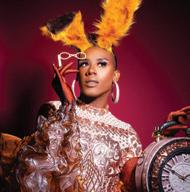
22 Online “Envisioning Justice RE:ACTION” expands communitydriven efforts to imagine a future without mass incarceration.
24 Comics Two stories of diasporic movement
26 Art Expositions Julius Caesar’s Barely Fair focuses on alternative art spaces.
28 Book Review In Balancing Acts: Unleashing the Power of Creativity in Your Life and Work, Cirque du Soleil’s former CEO touts creativity in business.
32 Profile The 30-year-old stage actor and self-described “biracial
disabilities
38 Profile Chicago-area actor Gabriella Carrillo returns in Six 40 Dance “A lot of us took on breaking because we were missing something from our lives.”
44 Dance Hedwig Dances returns with Field Theory.
46 Film Screenings Enjoy Ukrainian and Asian American cinema at Gene Siskel Film Center.
47 Film Festival The hybrid 38th iteration of the Chicago Latino Film Festival will take place April 21-May 1.
THEATER
48 Plays of Note About Face’s Laced, Otherworld’s Murder on Horizon, Rivendell’s Spay, and more
FILM
50 Movies of Note Ahed’s Knee, The Automat, The Contractor, and more
MUSIC & NIGHTLIFE
52 Feature Chicago garage rockers Barbie Army broke up in obscurity more than 30 years ago, but a German label is giving them a second chance.
CHICAGO READER | MARCH 31, 2022 | VOLUME 51, NUMBER 13
TO CONTACT ANY READER EMPLOYEE, E-MAIL: (FIRST INITIAL)(LAST NAME) @CHICAGOREADER.COM
PUBLISHER AND PRESIDENT TRACY BAIM
PUBLISHER AND EDITOR IN CHIEF KAREN HAWKINS EDITOR IN CHIEF SUJAY KUMAR
PRODUCTION MANAGER KIRK WILLIAMSON
SENIOR GRAPHIC DESIGNER AMBER HUFF
CULTURE EDITOR SALEM COLLO-JULIN
NEWS EDITOR JIM DALEY
66 Shows and Records of Note Previews of concerts including Wayfaring, Summer Walker, and Sons of Kemet, plus reviews of releases by the Cool Kids, Meshuggah, Orville Peck, and more

72 Early Warnings Newly announced and rescheduled concerts, plus other updated listings
72 Gossip Wolf Jazz guitarist George Freeman celebrates 95 years with a new compilation, Cheer-Accident stream a basement release concert, and Shannon Candy reissues two LP tracks on an Italian seven-inch.
OPINION
74 Savage Love Dan Savage offers advice on thinking about forever vs. now, as well as catching feelings for a polysaturated partner.
CLASSIFIEDS
THEATER AND DANCE EDITOR KERRY REID
MUSIC EDITOR PHILIP MONTORO
ASSOCIATE EDITORS JAMIE LUDWIG, TARYN ALLEN
SENIOR WRITERS LEOR GALIL, DEANNA ISAACS, BEN JORAVSKY, MIKE SULA
STAFF WRITERS ADAM M. RHODES, KATIE PROUT, KELLY GARCIA
AUDIENCE ENGAGEMENT MANAGER YASMIN ZACARIA MIKHAIEL
EDITORIAL ASSOCIATE JANAYA GREENE LISTINGS COORDINATOR MICCO CAPORALE
VICE PRESIDENT OF OPERATIONS ANN SCHOLHAMER
DIRECTOR OF DIGITAL JOHN DUNLEVY
DIRECTOR OF DEVELOPMENT JT NEWMAN
DIRECTOR OF MARKETING VIVIAN GONZALEZ
MEDIA PARTNERSHIPS COORDINATOR YAZMIN DOMINGUEZ
EXECUTIVE ASSISTANT SANDRA L. KLEIN SPECIAL PROJECTS ASSOCIATE SHAWNEE DAY CIMA SUPPORT SPECIALIST SAVANNAH HUGUELEY
ADVERTISING 312-392-2970, ADS@CHICAGOREADER.COM CLASSIFIEDS: CLASSIFIED-ADS@CHICAGOREADER.COM
deviant” Ana Silva challenges the order of the media world.
34 Theater Festival Rhinoceros Fest is back this spring.
36 Accessibility How COVID has changed theater for people with
A NOTE FROM THE WRITER
BREAKING IS A COMPETITIVE DANCE, usually performed solo, manifesting in bursts of energy that erupt in rapid detonations of aggression, invention, and expression. The experience can be overwhelming, intimidating, and earsplittingly, awesomely loud. Yet the battle is only a fraction of the art—to experience breaking is also to experience a dance and a community which exists to itself and for itself, yet which holds hope and promise for anyone willing to watch, learn, and practice.
I began this story by going to practice. Breakers practice where they can, and they practice together. They tape down linoleum in parking lots, throw down cardboard, dance in parks and on the lakefront, open up basements and businesses, face concrete head on. In these spaces, everyone says hello and goodbye with a fist bump or a handshake or a wave. Everyone makes eye contact.
These spaces are inevitably temporary. The Clarendon Park Fieldhouse, which hosts the longest running and largest practice in Chicago, has been slated for demolition. The Brickheadz, true to their origins all over the city, migrate from park to park and often practice outdoors.
56 Feature Unjustly obscure showbiz-adjacent eccentric Perry Kanlan, aka Dancin’ Man, recently passed away, so that the quixotic task of saving him from oblivion became more difficult—and more urgent.
76 Jobs, rentals, services, and more
ON THE COVER: PHOTO BY DUWAYNE PADILLA.
VP OF SALES AND BUSINESS DEVELOPMENT AMBER NETTLES
VICE PRESIDENT OF SALES AMY MATHENY SALES TEAM VANESSA FLEMING, LENI MANAA-HOPPENWORTH, TIM OGDEN, TED PIEKARZ, WILL ROGERS, LISA SOLOMON DIGITAL SALES ASSOCIATE AYANA ROLLING
NATIONAL ADVERTISING VOICE MEDIA GROUP 1-888-278-9866 VMGADVERTISING.COM JOE LARKIN AND SUE BELAIR
Since the writing of this story, the daycare in Cicero has closed for practice. Still, through breaking, they build.
In a dance dominated by men, two women, Carmarry “PepC” Hall and Tanja “Kid-T” Kuurola—regulars at the practice founded by a woman who, initially excluded from the art, found one friend to teach her how and opened the door for others to follow—are now training for the Olympics.
Through a dance from the Bronx, a bboy born in Mexico who grew up on Chicago’s southwest side became brothers with another breaker from Kyiv, Ukraine.

Practice at Blue Island ends with a pot of pasta boiled on a hot plate and eaten together.
People of all origins dance together, and most are people of color. Kids and adults dance together, in the same space, joyfully. Everyone is a teacher, and everyone is a student.
The learning never ends. The practice continues. IRENE HSIAO
DISTRIBUTION CONCERNS distributionissues@chicagoreader.com 312-392-2970
READER (ISSN 1096-6919) IS PUBLISHED BIWEEKLY BY CHICAGO READER L3C 2930 S. MICHIGAN, SUITE 102 CHICAGO, IL 60616 312-392-2934, CHICAGOREADER.COM
COPYRIGHT © 2022 CHICAGO READER PERIODICAL POSTAGE PAID AT CHICAGO, IL
ALL RIGHTS RESERVED. CHICAGO READER, READER, AND REVERSED R: REGISTERED TRADEMARKS ®
2 CHICAGO READER - MARCH 31, 2022 ll
THIS WEEK
IN THIS ISSUE
At City Colleges of Chicago, an affordable college education isn’t miles away—it’s down the street.
Save thousands on your college journey by taking classes at the campus in your community or from the comfort of your own home. With in-demand programs, expert faculty, and supportive resources, our seven colleges can help you map out your future.

Future
Daley College
Kennedy-King College
Malcolm X College
Olive-Harvey College

Truman College
CITY COLLEGES OF CHICAGO SOUTHWEST SIDE SOUTH SIDE WEST SIDE SOUTHEAST SIDE NORTH SIDE THE LOOP NORTHWEST SIDE
Harold CollegeWashington Wright College Online



Find your college, and your future, today:

MARCH 31, 2022 - CHICAGO READER 3 ccc.edu/apply
Dream Big, Go Local Find Your
A


handmade tale
By ISA GIALLORENZO
T“hrifting is huge right now— being able to go, pick out your materials, and put things together like Frankenstein, mixing a lot of elements to make something special,” says Cole Glover, 19, a student of designed objects at the School of the Art Institute. Glover perfectly embodies what’s going on in fashion right now: a combination of the comfort we got used to during COVID times, and what he calls “dopamine dressing”—a style that embraces fun and bright pieces, meant to bring us back to life in this (hopefully) post-pandemic spring.
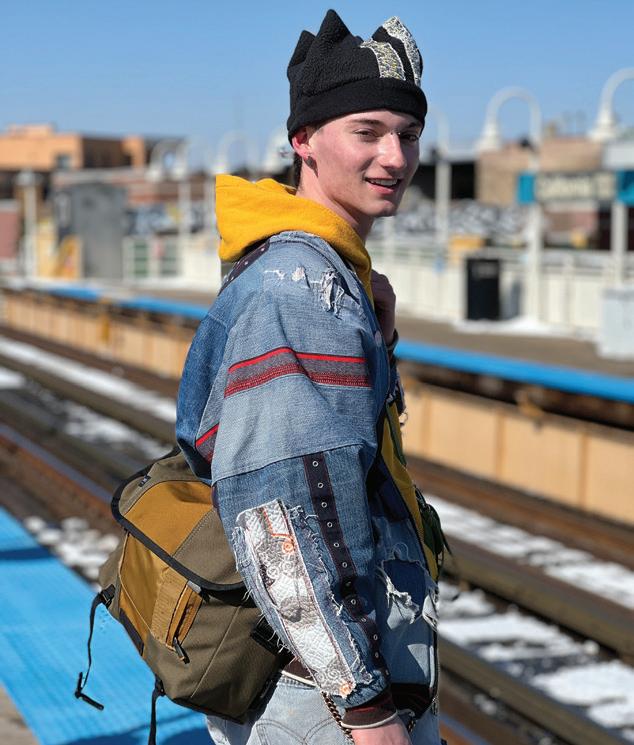
Many people also got a bit craftier during the lockdowns, which is reflected in the DIY flavor present in the latest trends, and in Glover’s outfit as well. He made his pants himself, complete with a strategic leg zipper that reveals a hidden pocket in the hem. His hat was made by his brother, and most of his other garments were either gifted or thrifted. His yellow hoodie was designed by Gaudmother, a Philadelphia-based label that accurately displays the anarchic and anti-capitalist spirit of our times. That sentiment is echoed by Italian brand Level XXX, the maker of Glover’s jacket.
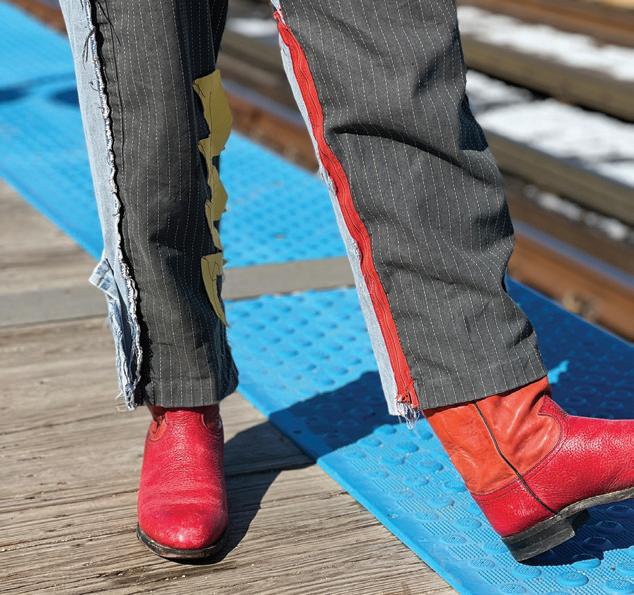
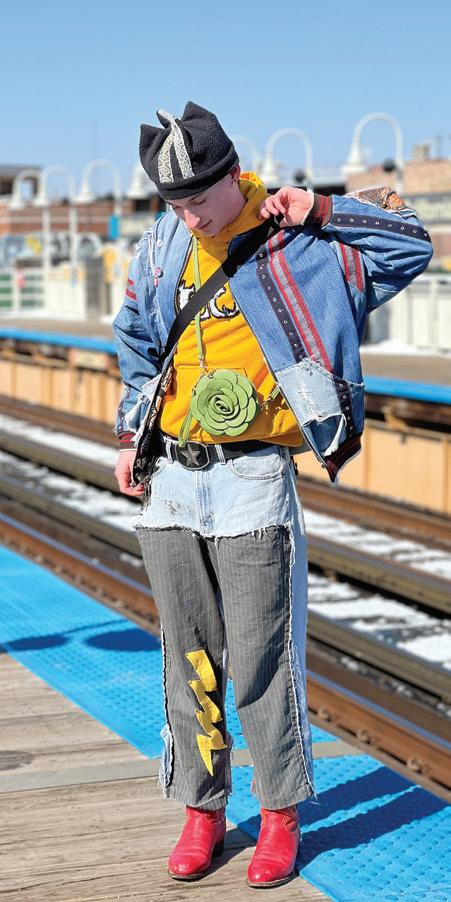
“I think a lot of people are reacting against fast fashion and lower quality stuff,” says Glover. “I like things that are handmade and upgraded, and also things that have an element of decay to them, that change over time.”
In his work with designed objects, Glover highly values sustainability, and adopts the “cradle-to-cradle” concept—which means designing things that will have continued use beyond their life expectancy, and not simply get thrown out. “I think there’s so much extra stu in the world right now, so much waste, that it’s really wise to find new uses for that waste,” he says. v
4 CHICAGO READER - MARCH 31, 2022 ll
CITY LIFE
@chicagolooks Street
View
A fashion-forward look that tells a story of creativity and eco-friendly practice
ISA GIALLORENZO












MARCH 31, 2022 - CHICAGO READER 5
Annie Xiang wants you to wake up and smell the pu’er
Volition Tea specializes in sustainable single-origin, loose leaf Chinese teas—no blends, no additives, no toxic supply chain.
By MIKE SULA
Annie Xiang’s son answered her morning co ee with violence.
“He was just kicking me in my belly,” says Xiang, at the time a tax manager at a Big Four accounting firm downtown. Hoping to advance to partner, she worked 70- to 90-hour weeks fueled by 32 ounces of Intelligentsia coffee per day—no cream, no sugar. She’d tapered down to a cup a day after she became pregnant, but “he would kick me nonstop right after co ee, so I went cold turkey. After giv-
ing birth I did need something to sustain me because of all the sleep trainings. I thought, ‘Maybe I don’t need 32 ounces of co ee but I could start drinking tea again.’”
Xiang’s co ee habit came late in life, after a long caffeine-free pause in her teens. She was born into a tea-drinking family in the U.S. commonwealth of Saipan but grew up in China’s northwestern Xinjiang province, where black brick tea with salty yak butter was the preferred m.o. “My mom actually was a Lipton
drinker for the longest time, which is ironic because in China, you have abundant access to all the great teas,” she says. “It’s because of marketing. They marketed Lipton tea as this high royal English tea that’s supposed to be better. But we all know that’s not true. Luckily she did have a lot of serious tea friends who introduced her into all the great teas. Just like all my fellow Asian Americans growing up, we just drank whatever our parents had.”
Xiang lost access to yak butter tea and her
mother’s stash of the good stu when she attended boarding school in upstate New York, years during which youthful energy precluded the need for ca eine. “Actually most Chinese don’t know that tea has caffeine,” she jokes. “They drink tea at all hours and give it to their children.”
It wasn’t until college that she began to form a physical dependence on independent third wave coffee shops, along with their commitment to transparency in sourcing and processing.

When she started looking for single-sourced, loose leaf teas produced with comparable commitment to sustainability and fair trade, she found the marketing was murkier. “I was looking for tea companies that matched the quality that I am used to growing up,” she says. “I had a hard time. If you’re in a grocery store and you move left to the tea shelf, they’re not providing the origin. They’re not providing the farmer information. They don’t give you the same level of transparency in terms of roasting date as when you buy a bag of co ee.”
The handful of promising tea companies she did find were suspect as well, run by white guys who continued to market teas couched with the trappings of western colonialism (Earl Grey, English breakfast) or worse, employed industrial-scale methods. “A common practice the tea industry does is to blend multiple years of harvest together in order to push through inventory.”
Xiang began to envision her own tea company, focused on the six families of tea derived from Camellia sinensis that are native to China (white, yellow, green, red, wulong, and black), but she was daunted by her lack of connections in the business. Then the pandemic hit, and along with it the rise in anti-Asian hate crimes. Xiang saw the stories of the small, sustainable tea farmers she admired as tools to build empathy for her own community.
“One other big thing people do when they say farm-to-cup is they erase all the people in the middle helping them, because very rarely can someone start a tea company and not use an importer.” She talked to several before she settled on Fujian-based Daniel Hong, a tea maker himself, who sent her some 50 samples from across China’s tea-growing provinces.
In October she launched Volition Tea with
6 CHICAGO READER - MARCH 31, 2022 ll FOOD & DRINK
Annie Xiang hosts a tea ceremony for Volition Tea at Moonwalker Cafe. Her goal is to inform consumers about the life cycle of tea and encourage them to think of the people behind its production. KATHLEEN HINKEL FOR CHICAGO READER DRINK FEATURE
Her
RVOLITION TEA
volitiontea.com instagram.com/volitionteaco

seven varieties of leaves ranging from refreshing Lu’an Melon Peel green tea, grown by fourth-generation farmer Xi Wei Hai, whose plants grow among rocks in the mountains of Anhui Province, and who plucks and dries leaves in three stages to maximize their sunflower and bamboo notes; to the Raw Jade wulong produced in Shuangyang, Fujian, by Zeng Pu Yu, a woman who married into the business and spent a decade building an organic tea garden and factory to yield the vegetal, orchidlike profile that she named after herself; to the Red Jade grown in Guangdong by Chen Yong Qiang, who fully browns his leaves for a dark amber tea that tastes like roasted squash and molasses.
“It takes ten years to really have a sustainable tea garden,” says Xiang. “They have to go in day after day, month after month, year after year to make sure that they are truly respecting their land and the people that live nearby.
That’s while looking at their peers having a higher yield because they use chemical fertilizers and pesticides, and to say, ‘That’s not who I am. I am willing to accept a lower yield if that means my tea is truly sustainable for tea drinkers and for villagers.’”



Xiang selected her teas based on what she thought might best appeal to western drinkers, and each tube of leaves is printed with general (but detailed) guidelines accounting for weight, temperature, and steeping time for someone in mind of a 12-ounce cuppa.
But there is a better way to appreciate the dynamic way these teas express themselves over multiple steepings. Last week Xiang set up a traditional gongfu Chinese tea ceremony for a handful of folks at the Moonwalker Cafe in Avondale. There she poured seven of her teas demonstrating how their flavors, aromas, and colors develop over several steepings.
She started with the delicate, floral Colorful
Peony white tea developed by her importer Hong and third-generation farmer Li Zhi Zhong in Fujian province. Zhong, like the other farmers on the Volition roster, doesn’t use chemical fertilizers or pesticides. He employs a shaking technique (common to wulong tea production) that oxidizes the edges of the leaves, which turn various shades of red and green, and brings out their fragrance. There was the nutty, High Mountain Dragon Well farmed in Pan’an Zhejiang by Kong Zhong Ming among forested mountain peaks and harvested late in the season. She finished with the malty, woody Girl Village Raw Pu’er tea, one of her most robust varietals, produced in southwestern Jinghong, Yunnan, by Yang Xiu Hai, a farmer whose path to the tea business mirrored her own. He left his corporate Beijing job to start a tea garden from scratch in ironrich soil; it’s a radical late-life career change that sounds awfully familiar amid the great
resignation.
You can find Volition tea at Moonwalker Cafe, where owner Arlene Luna plans to o er it cold-brewed this summer. It’s also in the cafe at Guild Row. It’s retailed at Oromo Cafe in Lincoln Square, Backlot Co ee in Old Irving Park, as well as on her own website.
Meanwhile, Xiang plans to focus on her small lineup of teas for now, taking them around to cafes and farmers’ markets, preaching the gospel of unblended, unflavored loose leaf tea. “I want our business to cause more people to pause before purchasing a tea that comes from a toxic supply chain, that treats tea as a commodity.”
As for her son, he’s a two-year-old tea drinker now. “He had a lot of opinions before he was born,” she says, noting that he still does. “He likes the Colorful Peony.” v
MARCH 31, 2022 - CHICAGO READER 7
FOOD & DRINK
CROSSINGS MAPPING AMERICAN JOURNEYS Exhibition on view at the Newberry Library 60 West Walton Street February 25 through June 25 Free and open to all Any views, ndings, conclusions, or recommendations expressed in this exhibition do not necessarily represent those of the National Endowment for the Humanities.
@MikeSula
POLITICS
A bad hand
Depending on a casino to pay our pension obligations is the second-dumbest idea of this century.
By BEN JORAVSKY
Now that Mayor Lightfoot has officially revealed the three finalists for Chicago’s casino, the bamboozling of the city will begin.
Oh, Chicago, you know you’re getting bamboozled. I think you sorta like it—a little attention from the boss.
It’s like you matter as they try to win you over into supporting something you don’t really want or need. In this case—a casino. Like the one they have in Hammond. Don’t call us the second city!
If I were an old leftie, I’d say they’re manufacturing consent. Noam Chomsky coined that term for when the powers that be (mass media included) convince you to sign onto something that’s not really in your interests.
Actually, I am an old leftie. So let’s run with it. You know the game by now. It starts with
the mayor trying to build anticipation over the heated competition to see which site will be lucky enough to win the casino.
By the way, pretty much everyone I ask— and I ask everyone who comes on my podcast—thinks city leaders have already selected where the casino will go and the site-selection competition is just a ruse. And people say I’m cynical?
We played this game with Amazon a few years ago, when they created a nationwide competition between cities looking to win the right to pay for their headquarters. Somehow Amazon bamboozled city leaders throughout the country to fight over who got to give their tax dollars to Jeff Bezos, one of the world’s richest men.
The good news is that the casino bamboozle is not nearly as outrageous as Amazon’s.
But it’s pretty offensive when our leaders tell us we absolutely, positively need this casino to pay our police and firefighter obligations.
I’d say that depending on casino revenue to cover pension obligations is the dumbest idea out of Chicago in this century, except . . .
Mayor Daley’s Olympic bid also occurred in this century. And nothing can be dumber than writing a blank check for an Olympics that would have sold away our parks for years.
If you recall, we were bamboozled into a breathless competition to win the 2016 Summer Olympics. The International Olympic Committee wound up going with Brazil—a clear case where we won by losing.
Depending on casino revenues to pay off pension obligations is a regressive and uncertain way to pay your bills. That’s because you’re relying on getting money from people who probably can’t a ord to give it to you.
Casinos are set up to make sure the people who gamble there lose—that’s how casinos make their money. So we’d be paying essential obligations by squeezing people who can’t a ord to be squeezed.
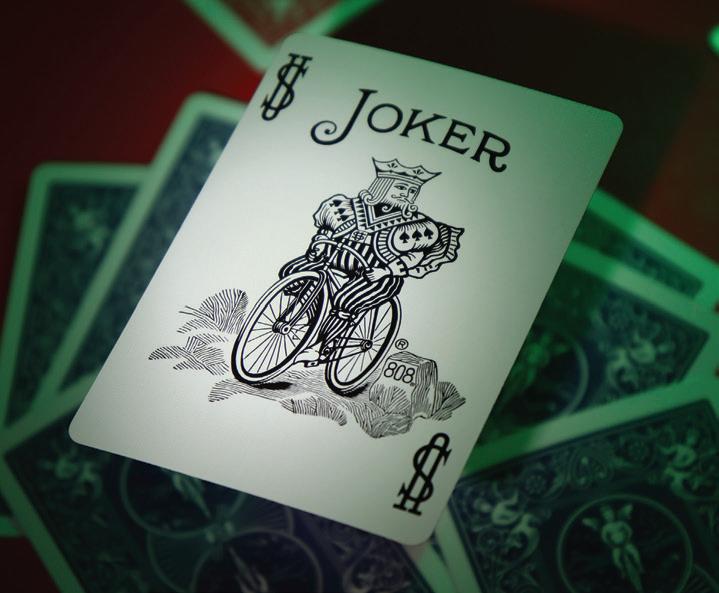
And we’re doing that because we’re apparently afraid of raising taxes on the wealthiest people in the state—who can afford to pay more to help cover our basic obligations.
But if we try to raise taxes on the wealthy, the wealthy will fight back by paying for commercials that trash the politicians who raised their taxes as tax-and-spend radical leftists, who are also soft on crime. Good luck getting elected with that label.
So we’re stuck with taxing vices like gambling and reefer. Don’t get me started on the latter. Cannabis is taxed so high—pun intended—that sales are starting to fall.
I’m pretty sure people are still consuming cannabis. They’re just buying it from their black-market dealers.
Now that I think of it—legalizing cannabis in order to raise money to pay our bills was the wrong reason to legalize it. We should have legalized it because it was unfair that Black people went to jail for doing something that white people freely do every day. We shouldn’t have worried about how much money it brought in. Have you ever noticed that when our lead-
ers actually do the right thing, they do it for the wrong reason?
Back to the casino . . .
City officials have not been upfront about how much it will cost the public to build the casino. But I think we all know that much of the money will eventually come from a TIF.
To refresh memory—that’s the infamous tax increment financing program, where the city slaps a surcharge on your property taxes in order to raise money to eradicate blight in a poor neighborhood. Though few of the neighborhoods that benefit the most from TIFs are poor.
That’s certainly not the case with the three sites in line to get the casino.
There’s One Central, a proposed megadevelopment that would be built over the train tracks just west of Soldier Field. The developer of that proposed project has been looking for a multibillion-dollar handout from the state.
The city says a casino can go there even without the handout from the state, which raises the question—why give the developer billions of dollars in the first place?
Another site is the Freedom Center printing plant on the near north side, not far from Lincoln Yards, which has already received a $1.3 billion TIF handout.
Putting the casino here means giving even more millions of public dollars to a community that was gentrifying even before Lincoln Yards, while the rest of the city collapses into a giant pothole. Hard to believe they’re so shameless as to even propose this site.
Finally, there’s the 78, the vast expanse of vacant land along the Chicago River just south of Roosevelt Road. I call that site Rezko Village in honor of Tony Rezko, the man who once owned it.
You may remember Rezko. Years ago, he went to federal prison after being convicted on various charges of fraud and corruption.
If this is where the casino goes, they should call it the Al Capone Casino at Rezko Village. It’s only appropriate that if we’re squeezing saps to pay our obligations, we name the casino for a gangster and a crook. v
8 CHICAGO READER - MARCH 31, 2022 ll
NEWS & POLITICS
You’re getting bamboozled by a bunch of jokers, Chicago! But I guess you’re used to that by now.
RYAN MOULTON / UNSPLASH
@bennyjshow
























MARCH 31, 2022 - CHICAGO READER 9 CHICAGO HUMANITIES FESTIVAL 2022 Get tickets: chicagohumanities.org April 13, 8:30pm April 13, 6:00pm Jonathan Van Ness & Greta Johnsen Molly Shannon & Tim Meadows
CULTURE
Coming of age in an ordinary and dangerous place
Lyric Opera’s Fire Shut Up in My Bones
By DEANNA ISAACS
Charles M. Blow once wrote in his New York Times column that he “likes to think of himself as a Southern writer.” His childhood in Gibsland, Louisiana, shaped his writing, and in the south, “you don’t so much say words as sing them.”
Now, at Lyric Opera, his own story is literally being sung. But not exactly in his own words.
Fire Shut Up in My Bones , Blow’s memoir of his early life, was published in 2014. It’s a deeply introspective coming-of-age story, rooted in an incident of childhood sexual abuse and its psychological aftermath for a gifted young Black man struggling to come to terms with his sexual orientation.
But what’s most striking about the book is its lyrical power. Poetry dressed as prose, it’s a rich portrayal of 20th-century life in a still-segregated small town—its impact coming as much from the evocative use of language as from the events described.
Which doesn’t necessarily make it ripe material for opera.
So when the opportunity presented itself, on opening night of the Lyric production of composer Terence Blanchard’s new opera of the same name, I asked the librettist, filmmaker Kasi Lemmons, whether having such a beautiful text to work with made her job easier or harder.
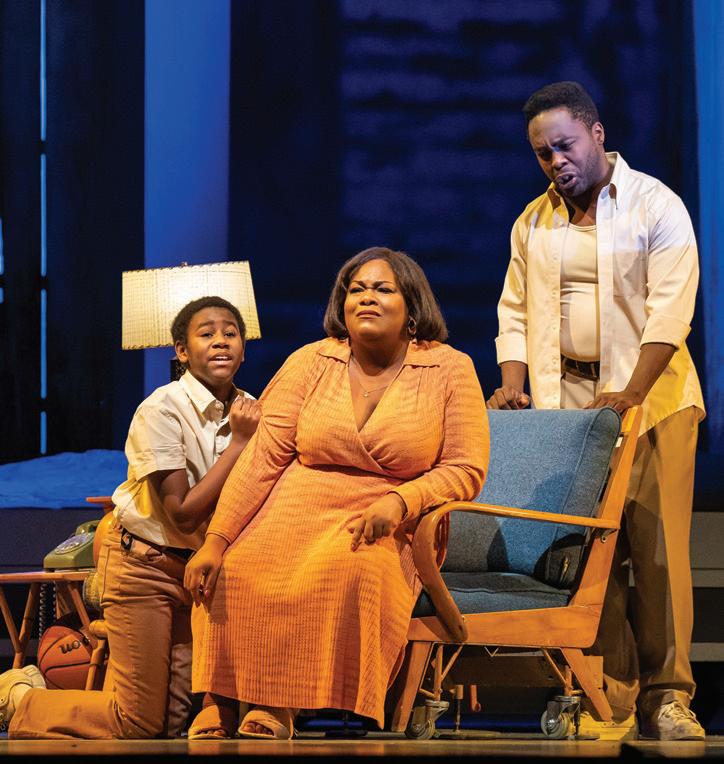
“Both,” Lemmons said, because Blow’s text was “so inspiring, but not theatrical in form.”
No worries: the creative team of Lemmons, jazz virtuoso Blanchard, co-director and original choreographer Camille A. Brown, and co-director James Robinson—all here for the opening—have succeeded in turning Blow’s literary tour de force into a riveting threeplus hours (including one intermission) at the opera.
Lemmons, who told me she tried to retain as much of Blow’s poetry as possible, managed to wrangle the story into the condensed narrative opera demands, while making his internal drama explicit—in part by personifying the pull of destiny and the loneliness that was his
frequent companion. And Blanchard, who’s scored many of Spike Lee’s films, notes (in an interview available on the Lyric website) that he composed the opera by speaking Lemmons’s lines out loud, over, over, and over, to capture the inherent rhythm in the words. The result is the best vocal storytelling in the form of recitative I’ve heard from a contemporary composer—backed and carried by a luscious, lyrical, and jazzy orchestral score that includes piano.
The opera tracks the book, opening with a glimpse of the climax to come, when Charles, 20 years old, armed, and in a rage, sets out to kill the older cousin who took advantage of him when he was only seven. According to the book, this assault did not include penetration of Blow’s body, but it definitely got into his head, and stayed there. As the teenage Charles—a perennial outsider, longing for his absent and inattentive father—finds himself attracted to men as well as to women, he’s haunted not only by the assault, but by his
own complicated tendencies. (Was he, “a child of peculiar grace,” somehow complicit in his own victimization?) Forays into religion and fraternal bonding (through hazing) at college fail to eliminate this self-blame, but provide the rationale for a rousing gospel scene and a show-stopping step-dance routine by the fraternity brothers. A breakup with Greta, the woman he loves, precedes the moment of decision that’ll determine the course of his life.
Lyric’s entire cast is exemplary, starting with Benjamin Preacely, the impressively professional fifth grader who plays the young Charles. Baritone Will Liverman, well-known to Chicago since his years at Lyric’s Ryan Opera Center, is fine in the demanding lead role of the adult Charles, and soprano Latonia Moore delivers a knockout performance vocally and dramatically as Billie, Charles’s strong, beloved, and beleaguered mother. Soprano Brittany Renee gracefully handles the triple role of Destiny, Loneliness, and Greta, while tenor Chauncey Packer nails the part of Charles’s charming rascal of a father. Reginald Smith Jr. invests the dicey Uncle Paul with a resonant baritone; another Ryan Center alum, baritone Chris Kenney, pulls off the role of the villainous cousin, Chester, with aplomb. Daniela Candillari conducts the Lyric Opera orchestra; Stu Mindeman is on that rippling piano.
Fire Shut Up in My Bones premiered at the Opera Theatre of Saint Louis in 2019. This co-production with the Metropolitan and Los Angeles opera companies was the first opera by a Black composer to be presented on the main stage in the Met’s 138-year history; at Lyric, it is the second (preceded by Anthony Davis’s Amistad in 1997).
“I don’t want to be a token,” Blanchard has said about that. “I want to be a turnkey. I want this to open up the floodgates for all different types of people.” v
Fire Shut Up in My Bone s, through 4/8: Sat 4/2, 7:30 PM, Wed 4/6, 2 PM, Fri 4/8, 7 PM; Lyric Opera House, 20 N. Wacker, 312-8275600, lyricopera.org, $49-$319.
@DeannaIsaacs
10 CHICAGO READER - MARCH 31, 2022 ll NEWS & POLITICS
Benjamin Preacely, Latonia Moore, and Will Liverman in Lyric Opera’s Fire Shut Up in My Bones TODD ROSENBERG
What Greta said ...
My Inheritance





 By Jarais Musgrove
By Jarais Musgrove
my inheritance comprised of water-burned, thrice dried, loose-leaf with words too faint, a ’93 Deville in need of a new wheel and axel, a deep freezer full of portioned pork, chicken kievs, and a newly opened pint of black walnut ice cream, chests of pristine FUBU, Girbaud, and Pelle Pelle coats and clothes with the tags still on. kangols too. a two-story house built in 1911 with the original siding, windows, pipes and shingles, a life insurance premium of an insatiable amount, $333 copays worth of therapy, five generations of hand me down fears and dated ideals, genetic strands composed by hittas who banged billions BCE, innate rhythmical sensibility, a versatile crown, anointed, full lips and divinely constructed vessel for the ability to cast manifestations and to “speak up for yo’ damn self” like grandmama pressed the meeker, greener me. ya see, we may never get rich but I got more than my parents did, cuz the Hoodoo truth lives in mine. making miracles from mud like grape do vine and feet do wine.




MARCH 31, 2022 - CHICAGO READER 11
Photo by Ronan Donovan. AuditoriumTheatre.org :: 312.341.2300 50 E Ida B Wells Dr | Chicago, IL NATIONAL GEOGRAPHIC LIVE Deborah and Bruce Crown Series Sponsors (Chicago, IL) North American Presenting Sponsor
APRIL 10 @ 2PM
Social by Nature
Jarais Musgrove is a Black, gender nonconforming Chicago-based actor, dancer, vocalist, and writer from Joliet, IL. These selected works are taken from their poetry ebook, Quiet As It’s Kept, a dedication to their adolescent self. Their work addresses queer intimacy, maternal lineage, and Black American faith and spirituality. They are a BFA recipient in Musical Theater-Dance from Roosevelt University’s Theater Conservatory.
Poem curated by Jada-Amina. Jada-Amina is a South Side Chicago born and based, Black Indigenous American singer, writer, and cultural worker.
more at
A biweekly series curated by the Chicago Reader and sponsored by the Poetry Foundation. Poetry Foundation Building Reopens April
7! Learn
PoetryFoundation.org
Hours Wednesday, Friday, Saturday: 11:00 AM– 4:00 PM Thursday: 11:00 AM–8:00 PM Respect the Mic Launch (In Person) An evening of poetry with the editors of and contributors to Respect the Mic: Celebrating 20 Years of Poetry from a Chicagoland High School Thursday, April 7, 2022, 7:00 PM
A farewell to the A.V. Club
The Chicago-based pop culture site moves to Los Angeles, leaving many worried about its fate.
 By KELLY GARCIA
By KELLY GARCIA
Earlier this month, the Chicago-based staff of the A.V. Club wrote their final words for the esteemed, deeply midwestern pop-culture site, which is relocating its headquarters to California.
The dreadful move came months after the company’s private equity owners announced they were bringing the site “closer to the industry it covers”—and forcing staffers to either relocate or quit their jobs.



Longtime fans from all over poured out their sympathies online for the writers and editors forced to make the gut-wrenching decision between moving cross-country or losing their jobs.
For years, the A.V. Club was the pop culture website for people who religiously follow entertainment news. Maybe you were lucky to witness the site’s comment sections after hate-watching season eight of Dexter or the A.V. Undercover live music webseries.
If the somber news of the departure feels eerily familiar, that’s because it is: news companies everywhere are being gutted by private equity firms or hedge funds. The publication’s owners claimed the move will “allow the site to grow its entertainment relationships and provide more access to exclusive events.” But that kind of music-insider business is the very antithesis of the A.V. Club.
There’s “something midwestern at the heart of the site,” former managing editor Erik Adams told the Reader in February. Founded in Madison, Wisconsin, the A.V. Club was once buried in the back pages of the Onion, and later grew to become its own media sensation. Over the years, it would find a home in Chicago, far from Hollywood’s glamour, where it had space to write the honest (and sometimes crass) pop culture criticism it grew to be loved for.
This isn’t an obituary of the A.V. Club—the
12 CHICAGO READER - MARCH 31, 2022 ll NEWS & POLITICS
Former A.V. Club staffers (clockwise from top) Laura Adamczyk, Alex McLevy, Gwen Ihnat, and A.A Dowd JONATHAN AGUILAR
MEDIA
site isn’t shutting down. It’s a tribute to the people who made it a staple of the midwest,
the story of how they did it.
In the fall of 1992, a satirical weekly newspaper in Madison, Wisconsin, was becoming popular enough to start attracting advertisers. With the revenue they brought in, the Onion was able to hire more sta ers and add pages—so much so that its writers, who were mostly college students, began looking for new ideas to fill the paper. They hired a friend, Stephen Thompson, to write concert listings for a whopping $15 a week. Other weeks, they paid him $25 for album reviews.
As a 20-year-old fan of the Onion, Thompson happily agreed. Over time, he began fleshing out an entertainment section to fill the back pages, including sections of its own: Sonic Boom for music, Toilet Reading for books, and the A.V. Club, its name a nod to high school audiovisual clubs, for movies.
Then the sta decided to rebrand the paper, which Thompson said was originally designed to be silly, with over-the-top screamer headlines, to look more like a real newspaper.
“They went from being a parody of Weekly World News to a parody of USA Today ,” Thompson recalled. The entertainment section, too, was redesigned and collected under the A.V. Club.
It wasn’t until the mid-90s, with the launch of its website, that the Onion went from being a regionally known paper to an international media phenomenon. TV camera crews parked outside the Madison o ce, desperate to capture writers in action.
“I remember cameras pointing at the accumulated dust and garbage strewn on the floors,” Thompson said. “It was like a college group house.”
In contrast, the A.V. Club was inconspicuous. Its Internet debut was gradual. Sta ers updated the site once a week with a few reviews and a feature—always in the shadow of the Onion
“One of the big things that we had to learn was how to be our own publication and have our own voice that was separate from the comedy section,” Thompson said.
But its time would come soon enough. In 2000, the Onion moved its editorial o ces to New York. A.V. Club staffers stayed in Madison, but not for long. They began to look elsewhere—148 miles south to Chicago—where they could get better access to press screenings and movie premieres.
Thompson stayed in Madison, where he worked remotely as editor in chief of the A.V.
Club. The Onion’s online success meant faster turnaround, which also meant he was working seven days a week for six months at a time.
“I was massively burned out,” he said.
He stayed on until 2004, having paved the way for a new era of the A.V. Club under the leadership of Keith Phipps. Over the next eight years, the publication would reach unprecedented heights in its new home in the heart of the midwest.
The A.V. Club broke into the Chicago scene in a cramped o ce near the corner of Clark and Belmont, on the second floor of the building neighboring the Dunkin’ Donuts a ectionately called “Punkin’ Donuts” because of the mohawked, leather-jacketed kids who hung out there (the location is now a Target). Former film editor Scott Tobias fondly remembers the stench of urine greeting sta ers from the alley every day while walking into work.
“We were all working on top of each other,” Tobias said. The o ce was a tight space for the growing sta .
A few years later, the A.V. Club upgraded to a converted loft space at 212 W. Superior, and later moved into a bigger office around the corner near Chicago and Franklin.
The new o ce had a rooftop deck (that they only used for a couple of summers because the building owners didn’t get the right permit), a Kegerator, and a tech start-up feel. It was also a short walk from film screenings in the Loop.
A space at 730 N. Franklin would later become the Onion’s headquarters, too, after that publication returned to the midwest from New York City in 2011—a move that startled its sta , who like the A.V. Club sta ers a decade later, were forced to either make the move or quit their jobs.
“I remember thinking, ‘Gosh, I don’t know how you could give up a job like that,’” Erik Adams said. “It’s hard enough getting a job at the A.V. Club. For a job with the Onion, there’s so many other hoops to go through.”
The Franklin building would end up housing several of the Onion’s sister publications—the A.V. Club, ClickHole, and the Takeout. Sta ers quickly became accustomed to working closely with one another.
“What I remember a lot about that o ce is the A.V. Club writers would be sitting there writing their 5,000-word treatises on TV episodes, while the Onion pitch meetings would be going on and they would always be laughing really loud,” former senior writer Katie Rife said. “It was an interesting combination of a library and a comedy club in there.”
The Franklin o ce remained the A.V. Club’s
headquarters as long as the publication was based in Chicago. In interviews with the Reader, sta ers reminisced about their days working at their “dream job.”
Former uno cial music editor Alex McLevy still remembers the excitement he felt on his first day walking into the office. “It felt like Charlie Bucket getting the gold ticket” in Charlie and the Chocolate Factory, he said. During his first week at the A.V. Club, McLevy was working on a story when his editor told him to take a break so that they could go watch Screaming Females play. Down the hall, the three-member rock band was performing a cover of Taylor Swift’s “Shake It O .”
It was one of hundreds of performances from bands invited to perform song covers at the Chicago o ce in what came to be known as the A.V. Club’s Undercover series.
“It was cool because you could kind of pause your workday and go into the studio and watch your favorite band play for a little bit,” Rife recalled.
The A.V. Club was also deeply embedded in Chicago’s music scene.
The Hideout’s annual block party, which later turned into the combined A.V. Fest/ Hideout block party, was a popular hit for local fans in the mid-2010s. Named the “antiLollapalooza” by Consequence Media, the music festival was a ordable and fan-friendly. A.V. Club editor Josh Modell and Hideout co-owner Katie Tuten curated a lineup of their favorite bands, and the dive bar’s parking lot served as the stage.
The A.V. Club also grew to be lauded for its TV coverage, which exploded in the 2010s. Phipps expanded the freelance budget to hire more contributors from around the country, like TV critic Emily VanDerWer , who worked remotely from her apartment in LA.
Fans became enamored with the reviews and comment sections, like VanDerWerff’s reviews of the TV sitcom Community . Her recap of the season three finale garnered over 100,000 comments.
The in-depth TV coverage was exceedingly popular, even for people hate-watching Dexter or True Blood . “I bet there were people that only watched terrible shows to go to the A.V. Club afterwards to crack some jokes,” a commenter on the news-aggregator site Reddit wrote.
“There is often a fair accusation of rosecolored glasses in that the people who worked there, the people who commented, the people that read that site cared about each other in a way that has become a lot harder to find online,” VanDerWer said. “It felt like you could go there and the world would be a little less unforgiving . . . even if it was comment wars about America’s Next Top Model. It wasn’t like we were arguing about the future of the republic. It was a place where the world felt like it made sense for a little while.”
In the late 2010s, the A.V. Club began diversifying its masthead and pool of freelance contributors. Former film editor Danette Chavez remembers being the only person of color working full-time at the A.V. Club. She successfully pushed the company to hire more Black and Latinx sta ers and also widened the
pool.
MARCH 31, 2022 - CHICAGO READER 13
contributor
NEWS & POLITICS
From its inception, The A.V. Club has been a home for popculture obsessives, but rooted in midwestern sensibilities, it stayed accessible to casual fans as well. Its distance— both physical and philosophical—from the industry’s epicenter granted readers and writers alike the space to be critical of popular media, from Breaking Bad to America’s Next Top Model.
and
NEWS & POLITICS
“We now have young Black women, like Ashley Ray-Harris writing about Insecure , and Ali Barthwell, who recently won an Emmy for her work on Last Week Tonightwith John Oliver,” Chavez said.
As that success panned out, “The A.V. Club became more of a platform for voices that have been historically underrepresented in alternative media,” Chavez said.
In 2012, Phipps stepped down from his role as editor in chief, the first in a wave of departures at the A.V. Club that included staffers Scott Tobias, Nathan Rabin, Tasha Robinson, Genevieve Koski, and Noel Murray. A few months later, the six former sta ers announced their new senior roles at the Dissolve, a Pitchfork-run film website that closed in 2015.
“There was greater concern for metrics, page views, and sponsored content,” Phipps told the Reader regarding his A.V. Clubdeparture. “I think my views on that have borne out, but I don’t think sponsored content saved online editorial sites in the long run.”
A few years later, CEO Mike McAvoy sold the Onion to Univision. Alex McLevy said the new owners mostly kept their hands off the A.V. Club, other than forcing the site to adopt Kinja as its new publishing platform, effectively annihilating the popular comments section. Around the same time, Univision purchased Gawker Media, another online media company, and reorganized several of its sites under the new Gizmodo Media Group.
In 2019, Univision sold the Onion, along with Gizmodo Media Group, to private equity firm Great Hill Partners. The new organization was rebranded G/O Media company.
“That’s when all the changes really began in earnest,” McLevy said.
The first mention of moving to LA, sta ers recall, was in 2019.
“It was presented to us as an actual invitation,” Chavez said. “The way that the information was disseminated to us was that they were building up an o ce in LA, not that they were shutting down the Chicago o ce.”
In September of 2021, G/O Media hired Scott Robson, Los Angeles-based media executive previously from E! Online and Yahoo! Entertainment, as editor in chief.
The move didn’t come up again until December of last year, when sta ers say they were informed during a meeting that the company would be shuttering its Chicago o ce and relocating to LA.
Staffers were given two options: move to
LA, or quit and take a severance package.
The company offered the Chicago-based sta ers $5,000 each to cover relocation costs, but no salary raises despite the higher cost of living in Los Angeles. They were given a month to make their decision. One said that had they not been unionized, they wouldn’t have even been o ered the severance.
“We didn’t get an incentive to move,” Chavez said. “We were given an ultimatum.”
In a statement to Gawker, G/O Media’s spokesperson wrote that “The A.V. Club ’s move to Los Angeles was planned to commence two years ago,” but was slowed because of the pandemic.
Some staffers considered the move, but it was less possible for others. “I have a three-year-old and we didn’t really want to uproot our lives,” said Alex McLevy, who ultimately chose to quit. “And also I fucking love Chicago.”
Before the deadline to make up their minds had even passed, the company was already advertising three of the seven Chicago-based job positions.
“It’s clear that G/O wants these veteran employees to leave so the company can replace them with workers paid at the salary
minimums as stipulated in the union contract—minimums that were bargained based on Chicago rates,” the union representing A.V. Club sta ers wrote in an online statement.
On January 18, the seven Chicago-based staffers announced they would be taking their union-contract-protected severances. In March, the A.V. Club began relocating its headquarters to Los Angeles.
On March 2, in the comment section of her last article for the A.V. Club, Katie Rife wrote a farewell to readers.
“I was a reader long before I was a writer for AVC, and many incredible writers, some of whom I am lucky enough to call friends and colleagues, passed through these doors before my time,” Rife wrote. “Many more have during my time, and many will after.”
From its inception, the A.V. Club has been a home for pop-culture obsessives, but rooted in midwestern sensibilities, it stayed accessible to casual fans as well. Its distance—both physical and philosophical—from the industry’s epicenter granted readers and writers alike the space to be critical of popular media, from Breaking Bad to America’s Next Top Model
Chicago is deeply indebted to the A.V. Club for helping make the city a mainstay of pop-culture criticism that is honest and sharp, like a true midwesterner. And perhaps because that kept it grounded, the A.V. Club was a platform for high-profile and emerging artists alike.
No one gave Bob Odenkirk—a native of Berwyn and star of the Breaking Bad spin-o Better Call Saul—the time of day quite like the A.V. Club. Local traditions like the old Hideout shows will be lost as well.
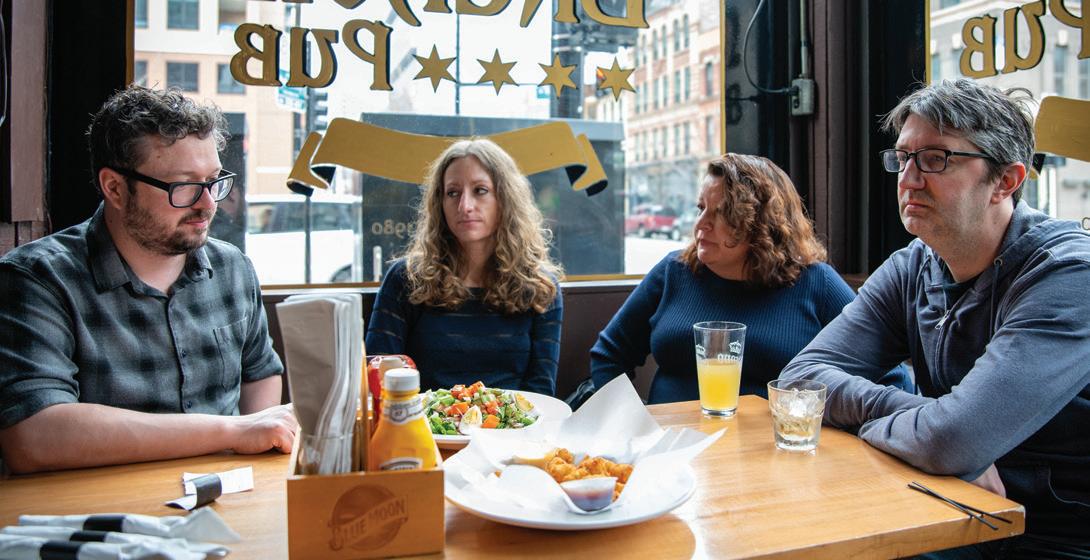
Thanks to the writers who gave it breath over the years, the A.V. Club will always be a product of the midwest (and maybe a candidate for “Chicago Not in Chicago”).
“I hope that people recognize that even as much as the A.V. Club has changed, if people are doing this work, it’s because they care about it,” Adams said.
“Our work at the A.V. Club wasn’t Pulitzerprize winning investigative journalism and it wasn’t writing that righted injustices, but in small ways it helped people understand their world better through the media that they love.” v
14 CHICAGO READER - MARCH 31, 2022 ll
@_KellyGarcia_ continued from 13
Chicago-based A.V. Club staffers A.A Dowd, Laura Adamczyk, Gwen Ihnat, and Alex McLevy said they were given an ultimatum by the website’s parent company: Uproot and move to Los Angeles, or quit. They chose to stay in Chicago. JONATHAN AGUILAR

MARCH 31, 2022 - CHICAGO READER 15
SPRING THEATER & ARTS PREVIEW
All the better to appreciate a disconcerting view of the surrounding trees reflected on the cube, juxtaposed by a central circle that reveals the sky. The scene evokes a mirage almost, a dream: two opposite yet very familiar worlds surreally brought together, causing perplexity and amazement in equal measure. “My work is about shifting our perception, helping us see with new eyes that which we have either ignored or become desensitized to. I have always found reflective surfaces are an excellent way to shift our vision, to bring about a reorientation by way of disorientation,” he says.
conscientiously researched.
“She was an iconic pioneer in the fields of science and art, and this house wouldn’t be here if it wasn’t for her,” Haskins says.
Haskins also pays homage to the designer of the house himself, van der Rohe (also known as the creator of the glass skyscraper).
Haskins’s sculpture is made with tinted skyscraper glass, using exactly half the amount of glass used to glaze the Edith Farnsworth House: a whole ton of it.
R “DAVID WALLACE HASKINS: LANDSCAPE + LIGHT”
Here, now, and everything in between
Art by David Wallace Haskins connects us to our surroundings in a transcendent experience.
By ISA GIALLORENZO
Planted in the woods like an extraterrestrial monolith, both completely alien and perfectly at home in its environment, lies Image Continuous , a mirrored, eightfoot-tall cube with a sky-reflective circle in the middle. On view at the Edith Farnsworth House in Plano and part of David Wallace Haskins’s “Landscape + Light” exhibition, Image Continuous was conceived in 2010, but kept unfi nished until Haskins found the ideal site for the sculpture.

“It was important that it be surrounded by nature, and that it sat in a glade so that it could really disappear into the landscape. As I passed the opening in the woods on the way to the [Farnsworth] house, I immediately knew I had found the place,” he says. Image Continuous is made with pyrolytic coated glass, and Haskins explains that the reflection on it comes from the surface of the glass, not from its backside; the silver is actually baked into the glass itself and is therefore surprisingly clear.
Haskins, 46, has been fascinated by reflections since his formative years in west suburban Elmhurst, where he would gaze at the sky reflected in the rain puddles. “Looking back I recognize this was the moment I began to see the world di erently, upside down, if you will, and it has continued to inform my life and practice to this day,” he says. It is not a coincidence that his biggest influences are artist René Magritte as well as Yves Klein, whose works, according to Haskins, were also “famous for bringing the sky down to the pictorial plane.”
The experience of viewing Image Continuous is complemented by the neighboring Edith Farnsworth House, located on a bucolic 60-acre property along the Fox River. An iconic home built by Mies van der Rohe between 1949 and 1951 for Dr. Edith Farnsworth, it is currently owned and operated by the National Trust for Historic Preservation. According to the organization’s executive director, Scott Meha ey, the Edith Farnsworth House has received over 100,000 visitors from all over the world since its opening to the public in 2004.
There are plenty of reasons to venture on the 58-mile trip to the house from Chicago, besides the pleasant drive itself: the venue promotes multiple exhibits, talks, and events, and will soon showcase more works by Haskins, its current artist in residence. Image Continuous borrows its title from one of Edith Farnsworth’s poems, which Haskins
Through December 2022 : Wed-Sun, 9: 30 AM- 3: 30 PM, at the Farnsworth House, 14520 River Rd., Plano, 630 552 0052 , edithfarnsworthhouse.org
Haskins sees similarities between his work and that of the modernist architect: “Mies was a master of light and space, and was in many ways one of the true fathers of the Light and Space art movement, of which my work is often associated with. But what that really means is that he was a master of getting to the essence of a thing, of stripping it down so far that something you didn’t know could happen, happens. And this is something he did without compromise, with a singular vision. And he found a way to turn that vision into reality again and again, and as a self-taught artist no less, which is inspiring to me because I am self-taught as well. I know his work is divisive: people love it or hate it. But I have always found it to be soothing to my busy mind. It feels very Zen to me, so I enjoy it. And my work shares a similar desire to strip away what’s nonessential and get to the heart of something, to arrive at a kind of multiplication by way of subtraction, which is what all great poetry does.
“I think it’s a very di cult thing to do well, but when it happens, it creates something special in us, a kind of space. It widens something in us that needs widening. And that is something I think we all need more of, and I do hope my work can in some way participate
16 CHICAGO READER - MARCH 31, 2022 ll
Skycube installed on the grounds of Farnsworth House ISA GIALLORENZO
LANDSCAPE ART







































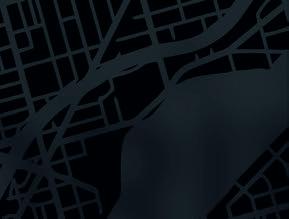


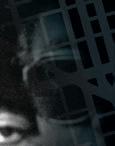


























MARCH 31, 2022 - CHICAGO READER 17 #ChicagoStoriesWTTW wttw.com/chicagostories FRIDAYS 8 PM NEW SEASON APR 1
Photo:
Chicago Mayor Jane Byrne, 1982.
ICHi-037841;
AN ORIGINAL DOCUMENTARY SERIES ABOUT PEOPLE AND EVENTS THAT SHAPED A GREAT AMERICAN CITY Enter to win! chicagoreader.com/contests
Photo: Chicago History Museum,
Richard T. Kaner, photographer.
SPRING THEATER & ARTS PREVIEW







in,” Haskins explains. He adds, “It is also interesting to note that Mies helped usher in a golden age of glass. As the father of the glass skyscraper and the contemporary glass house, he really set the course for the next hundred years of glass architecture. Almost every city around the world looks the same: a mountain range of glass. We live in the age of glass—there is nothing we experience today that isn’t delivered to us by it. It’s how billions of us see, thanks to eyeglasses, it’s how we interface with every computer, smartphone, and watch. It’s how we see out of our cars, our homes and o ces, how we see into the universe at the macro and micro levels, and it’s how the Internet travels around the globe, through actual glass fiber optics. Glass is the material of this age.
“Because of glass we can become more attuned to our world at home and afar, and the more we feel connected to it the more we care to care for it. Nothing helps us feel closer to nature in our living space than unfettered views of the landscape and light. But all this



comes at a price, and that is the price of killing birds by the billions, because to a bird, our windows are solid air, and their fragile heads are easily damaged upon impact. I don’t think we should stop striving to make homes and buildings more entwined with nature, as I think it is essential in order to help us thrive mentally and emotionally, and ecologically, because if we can’t see and feel connected to the landscape and light of the living world we are doomed to destroy it. But we must fi nd a way to do so while also caring for it, and that means making glass visible to our bird brothers and sisters. I am currently working with some researchers in Austria who are testing some special film that is visible to birds but invisible to our eyes. If all goes well with the tests, we hope to apply it to Image Continuous soon.”
An earlier Skycube is also adjacent to another Mies van der Rohe home—it is on permanent display next to the McCormick House at the Elmhurst Art Museum. The area has a special significance for Haskins since he lived just across the street in his youth. The
museum is also the place where he had two glorious solo exhibitions, the first entitled “Presence” (2016) and the second “Polarity” (2018). For those who missed them, the video archives are highly recommended. Even though this seminal Skycube is made with a steel frame and has a square opening in the middle, the two sculptures share a similar idea: creating an opportunity for the viewer to contemplate the sky, and how it relates to us and everything it permeates.
“The sky, or troposphere, begins at the ground and rises ten miles high,” Haskins says. “All of this planet is at once rooted in the earth while living and breathing in the sky; they are intertwined, interrelated, and interdependent. What we do to one we do to the other. Here we see and feel that connection in a way that is no longer conceptual, but is personal and real,” he adds.
Interconnectedness is at the heart of Haskins’s work, something he learned while caring for Tom, an elderly man he lived with for 20 years. “My life with Tom really led me into a huge perceptual shift. It brought


me into a deeply embodied understanding of what it means to live a life of interdependence, attuned to what I often refer to as the interrelational nature of reality, something we have been taught as a society to ignore. I’ve gained as much or more from living with Tom than he has gained from me, that is for sure. It’s been my greatest joy and honor to know him and help him for 26 years. I highly recommend people caring for others in need.”
Since 2017 Haskins has lived with his wife, Brittney Dunn, a fellow artist and designer, in a sunny apartment in downtown Wheaton. He still oversees Tom’s care and keeps on creating work that beautifully conveys our shared reality, drawing the viewer into a space of profound humility and vulnerability where they can hold space for the other—be it “a shaft of light, a tree, an animal, a reflection that allows you to see yourself as if for the fi rst time, a friend, a stranger, a lover, or an enemy— to see yourself in them and they in you,” Haskins says. v
18 CHICAGO READER - MARCH 31, 2022 ll
continued
16 24 hours a day Monday to Friday, and Saturday until pm. *Average voyage starting price. Starting price is subject to change. We reserve the right to change our products’ prices at any time without further notice. 24 4 * Quark Expeditions has been exploring the Arctic for 30 years. Isn’t it time you joined us? See polar bears, whales, muskoxen, reindeer, glaciers and more Explore by ship, helicopter and Zodiac Embrace exciting o -ship adventures Call one of our Polar Travel Advisors: Voyages start at $11,913 1.866.460.1881 CALL 1-855-927-2570 promo code N7017 TM * Prices are per person based on double occupancy plus up to $299 in taxes & fees. Single supplement and seasonal surcharges may apply. Add-on airfare available. Free date changes prior to final payment. Deposits and final payments are non-refundable. Onboard Credit requires purchase of Ocean View or Balcony Cabin. O ers apply to new bookings only, made by 3/31/22. Other terms & conditions may apply. Ask your Travel Consultant for details. BEST OF HAWAII FOUR-ISLAND TOUR GRAND ALASKAN CRUISE & TOUR Oahu • Hawaii Island • Kauai • Maui — Enjoy a fully guided 4-island Hawaiian vacation with centrally located lodging in Waikiki on Oahu, and beachfront lodging on the “Big Island” of Hawaii, Kauai, and Maui. Guided throughout by our friendly Tour Directors—your local experts. Includes 3 inter-island flights. Seattle • Vancouver • Ketchikan • Juneau • Skagway • Glacier Bay • Anchorage • Denali • and more Visit Denali and Glacier Bay on the same incredible trip! Cruise through the Gulf of Alaska and the Inside Passage as you discover the best of the Frontier State by land and by sea. 12 days, departs year-round 12 days, departs May - Sep 2022 FROM $2,549 * $2,299 * FROM $1,949 $1,699 * FREE ONBOARD CREDIT FREE DATE CHANGES
@chicagolooks
from
The fire burned for three days, killing hundreds, and leaving a thriving city in ruins. Risen from the ashes, Chicago rebuilt as an economic and architectural marvel. But just who benefited from reconstruction efforts?









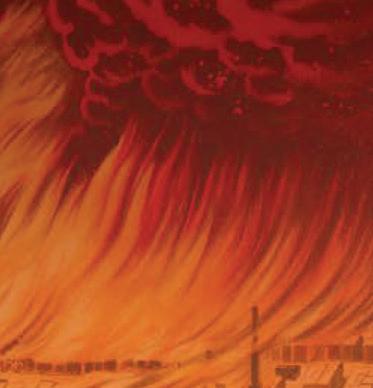

MARCH 31, 2022 - CHICAGO READER 19
Discover the story behind the blaze. Learn more and plan your visit at chicago1817.Org NOW OPEN AT
The Chicago History Museum gratefully acknowledges the support of the Chicago Park District on behalf of the people of Chicago.
EXHIBITION SPONSORS
Established in part by the Elizabeth Morse Charitable Trust and the Elizabeth Morse Genius Charitable Trust, the Exhibition Innovation Fund has provided additional funding for City on Fire: Chicago 1871.
Food & Drink A weekly newsletter featuring exclusive new writing by our critic Mike Sula and the latest restaurant reviews, chef profiles, and more from our site. Hot off the grill every Friday. SANDY NOTO FOR CHICAGO READER chicagoreader.com/newsletters
EDUCATION SPONSOR The A. Montgomery Ward Foundation, Bank of America, N.A., Co-Trustee
SPRING THEATER & ARTS PREVIEW
Subverting the dominant paradigm—one stitch at a time
“Fiber-Fashion-Feminism” visits the Art Center Highland Park.
By NOAH BERLATSKY
The Bayeux Tapestry dates back to the 11th century, so you can’t really say that high art appreciation of fiber work is new. There’s a big difference, though, between validating a giant record of European military conquest and the recent explosion of curatorial interest in quilting, knitting, embroidery, and clothing. Mrinalini Mukherjee’s monumental draped fabric monstrosities and Bisa Butler’s stunningly vivid hyper-patterned portraits use fiber to explore, celebrate, and mutate stereotypically domestic craftwork. Nick Cave’s gracefully bulky and jaw-droppingly adorned Soundsuits dance and trundle across the line between fashion and sculpture. In each case, fabric is the needle that pokes through rigid male, and often rigid white, assumptions about art to wear and art to stare at, pretty things in the home, and profound truths in the gallery.
The pretty and the profound are woven together in “Fiber-Fashion-Feminism,” the
forthcoming exhibit at The Art Center Highland Park, which runs from April 29 to June 11. In celebration, the gallery will be returning to live in-person events with its 62nd birthday party and annual spring benefit, this year titled Common Thread. The combined opening
R“Fiber-Fashion-Feminism”
On view Fri 4/29-Sat 6/ 11, MonSat 10 AM- 4 PM, Sun by appointment, at the Art Center Highland Park, 1957 Sheridan, Highland Park, 847 432 1888, theartcenterhp.org
and event will include music by DJ Tess and a fashion show featuring Chicago creators Katrin Schnabl and Maria Pinto (who has previously designed for Michelle Obama).
Curated by Caren Helene Rudman in consultation with Anne Wilson of the School of the Art Institute of Chicago’s Department of Fiber and Material Studies, the exhibit itself features a generous selection of work from nine contributing fiber artists: Schnabl, Pinto,


Nneka Kai, Jennifer Markowitz, Laura Morrison, Marty Ornish, Nirmal Raja, Yana Schnitzler, and Ginny Sykes.
Laura Morrison’s piece Don’t Touch functions as a warm bow, or a curtsy, to the Bayeux Tapestry: it’s a knit brown sweater-like cov-
RCommon Thread: 2022 benefit for the Art Center Highland Park Fri 4/29, 7 PM, at the center, $175 includes a fashion show, cocktails, passed appetizers and desserts, demos by center art faculty, and music by DJ Tess. Tickets and online raffle items at one.bidpal.net/commonthread
ering that evokes a breastplate draped over a mannequin torso. Morrison has said that she often finds gallery-goers “petting” her work on the sly. The title is a further taboo enticement, even as the fabric armor suggests both invitation and defensiveness. The gallery makes fiber more canonical and less reachable, even as fiber makes the gallery more familiar and more tactile.
Morrison’s work fuzzily foregrounds its fabric materiality. Schnabl’s works like Portal, in contrast, encourage a kind of fiber double take. The installation is a rectangular box covered in flowing abstract shapes. It takes a moment to realize that what you’re looking at is fabric draped over a frame. It’s like a specialized stand wearing a diaphanous covering for modesty—though not that much modesty, since the fabric is see-through, allowing the shapes on opposite sides to float over each other like fish passing in a pool. The piece nods to Schnabl’s work as a fashion designer; it’s essentially clothes without a person to wear them. That’s a comment perhaps on how high art has historically separated sensuality from bodies through various methods of abstraction, in contrast to the supposedly less authentic, but arguably more honest, practices of fashion.
Yana Schnitzler’s approach is again completely di erent. Her Tales of a Phoenix: The Letting Go Project is the record of a collaborative performance. Schnitzler invited women from across the country and the world to send her pieces of fabric stating or representing things they want to let go of. Over seven weeks at Chashama, a gallery in Manhattan’s Garment District, she stitched them all together into an enormous, room-sized skirt. After Tales of a Phoenix tours through 2022, Schnitzler is planning to perform a dance while wearing the skirt and then destroy it. Domestic and fiber arts traditionally have been created for use, rather than for eternal preservation, and Schnitzler’s Letting Go Project threads that history into her art about process, collaboration, and community.
The Art Center touts “Fiber-Fashion-Feminism” as cutting edge, and that’s accurate. But part of what’s cutting edge about fiber art is the way that it inevitably braids the history of women’s labor and art into current practice. Whether it’s Nneka Kai’s taut organic threaded abstractions or Marty Ornish’s sustainable baroque patchwork clothes, fiber can be an avant-garde art form that makes a gallery feel like home for people who haven’t always been allowed to live there. v
20 CHICAGO READER - MARCH 31, 2022 ll
Le : Don’t Touch by Laura Morrison; right: Portal by Katrin Schnabl BOTH COURTESY THE ARTISTS
EXHIBITIONS
@nberlat





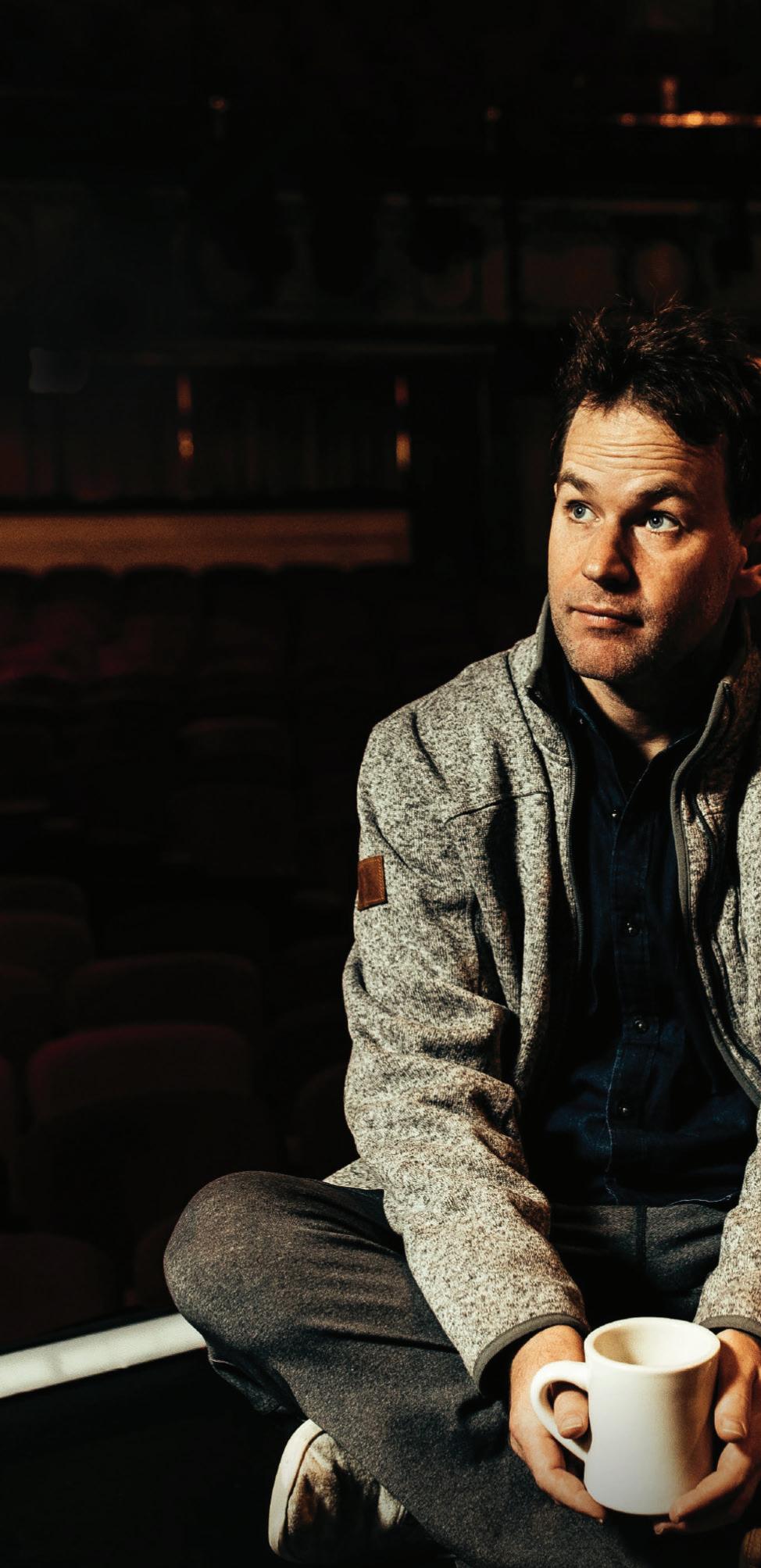




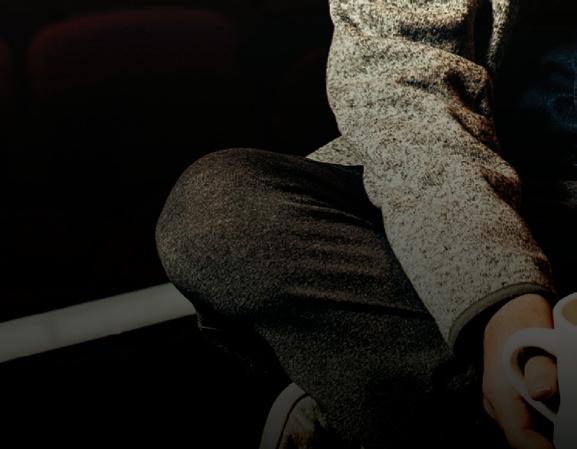









MARCH 31, 2022 - CHICAGO READER 21 BY
|
BY
It’s 1958, and Jack Paar hosts the hottest late-night talk-show on television. His favorite guest? The irrepressible character actor, pianist and wild card Oscar Levant, played by Emmy Award winner Sean Hayes (Will & Grace). EXTENDED THROUGH APRIL 24! 312.443.3800 GoodmanTheatre.org Groups 10+: Groups@GoodmanTheatre.org Lead Corporate Sponsor Corporate Sponsor Partner Piano by SEAN HAYES IS A REVELATION . A STUNNER OF A LEAD PERFORMANCE. DOUG WRIGHT DELIVERS A BLISTERING AND HILARIOUS PIECE.” –CHICAGO TRIBUNE SEAN HAYES IS A REVELATION . A STUNNER OF A LEAD PERFORMANCE. DOUG WRIGHT DELIVERS A BLISTERING AND HILARIOUS PIECE.” –CHICAGO TRIBUNE “ New Play Award THE OLD MAN AND THE POOL MIKE BIRBIGLIA APRIL 28 - MAY 22
DOUG WRIGHT
DIRECTED
LISA PETERSON
SPRING THEATER & ARTS PREVIEW
COURTESY ILLINOIS HUMANITIES
so that people would see the city through this lens of both [the] horrible things that happened and the struggle of people who fought against it,” Ross says.
In addition to viewing the installations, which were created by 14 different humanities- and arts-based projects, viewers of the exhibition become active participants when they themselves work on its activation kit—a collection of more than a dozen prompts that asks them to show us how they envision justice. After completing a prompt, participants can add their responses using a submission form. Jane Beachy, artistic director at Illinois Humanities, says this new process is an experiment and a way to encourage people to not just engage with the work, but also add to it.
‘We can imagine our way into something else’
By ARIONNE NETTLES
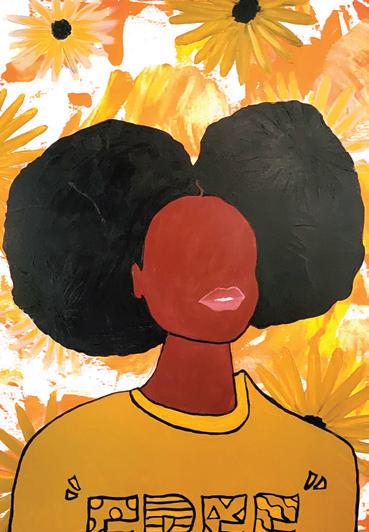
When Anthony Holmes goes to the doctor today, he’s asked: How many heart attacks have you had?
That’s because, Holmes says, the torture he faced in 1973 at the hands of then-Chicago Police Commander Jon Burge included shocking him with an electric shock box and suffocating him with plastic bags. Burge and the mostly white group of detectives that reported to him, known as the “Midnight Crew,” tortured hundreds of people in Chicago, mostly Black and Brown men, to force them into confessing crimes they did not commit between 1972 and 1991.
“To this day, we still suffer from this,” Holmes says. “We won’t ever be able to get rid of it because it’s going to be with us every day
that we walk. But the thing is, we can hold our heads up high.”
Holmes, one of the first known torture survivors, spent three decades behind bars after his forced confession and was released on parole in 2004. In 2010, he testified at Burge’s trial, where the disgraced commander was found guilty. At least 55 people who were tortured by Burge, now deceased, have been exonerated so far, while many other survivors are still incarcerated and waiting for their cases to be reviewed. But for Holmes, telling his story with the Chicago Torture Justice Memorials has been a way to let the world know this torture was real.
“We all got sent to the penitentiary with cases that weren’t ours, but they gave them to us,” Holmes says. “A lot of people died
[while incarcerated] and some people made it home—I’m one of them—but the issue is that this is the only way we could prove our truth that we were tortured.”
The stories of Holmes and others are part of “Envisioning Justice RE:ACTION,” a digital exhibition by nonprofit Illinois Humanities that asks both artists and participants to imagine a future without mass incarceration—an expansion from its 2019 exhibition. This installation focuses on the sites of police torture resistance around Chicago with a map itinerary for participants to visit and video testimonies about each site.
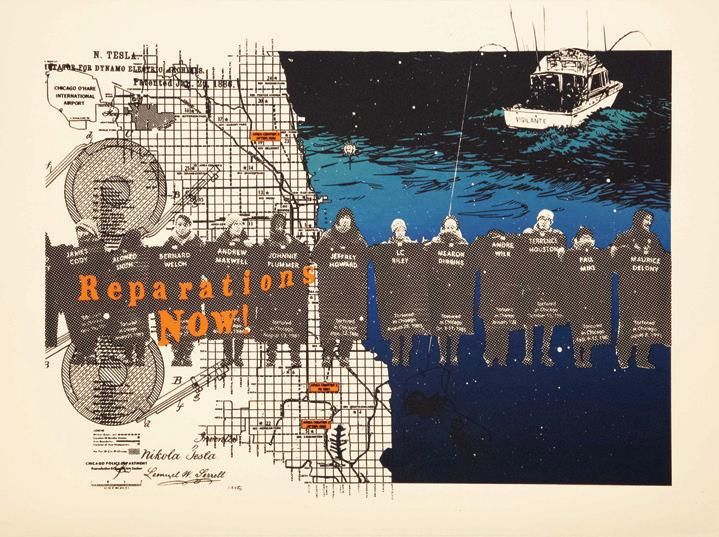
Artist Sarah Ross works with Chicago Torture Justice Memorials and is a co-founder of the Prison + Neighborhood Arts/Education Project, which works in and outside Stateville prison. She says these sites are an important feature of the work because they are related to many of the survivors’ stories.
“The cop would take them to one police station but tell their family they were at another,” Ross says. “And then when the family went to the other police station, they would move them again.”
Today, many of the police stations have been changed into other places, but Ross says that’s why it’s even more essential that people know what happened there.
“We live around these places where this immense harm happened as if things can go on, and so we really wanted to make this itinerary,
“It’s our hope that people will not only do those things but then share them back to the site,” Beachy says. “So that alongside the work that we commissioned, we’ll have all these other kind of visions and models and perspectives and reflections that will help us tell the story of how the arts and humanities make change.”
Another installation is Unbarred Poetics , which is a collaboration between poet Tara Betts and filmmaker David Weathersby that
R “ENVISIONING JUSTICE RE:ACTION”
Art and activation kits available to view at envisioningjustice.org.
features videos of Betts’s poetry and that of three other Chicago-based poets: Khari Bowden, Ciara Miller, and Devon Terrell. Viewers can watch and read the poems, and then submit their own work in response to the four prompts that accompany them.
“I realized that the impact of mass incarceration is much deeper than you expect,” Weathersby says. “And to really understand it, you have to listen to every angle of it, of every person: from the personal to the political to the economic.”
And to do this, Betts and Weathersby say they created stories that go past soundbites and statistics to relate the experiences of real people. Part of that has been to create counternarratives in the work that actively humanizes people who are incarcerated.
22 CHICAGO READER - MARCH 31, 2022 ll
Le : Reparations Now!/The Dynamo and The Black Box (2022), part of The Tea Project by Aaron Hughes and Amber Ginsburg; right: Diana Free (2001), painting by Antonio Burton
ONLINE
“Envisioning Justice RE:ACTION” expands community-driven efforts to imagine a future without mass incarceration.
Betts’s poem, “Small Illuminations,” tells the story of Albert, a writing student she met while teaching at Stateville prison. He had been incarcerated for decades after being, like many, “in the wrong car, with the wrong people, at the wrong time.”

“When I chose the poem that I shot with David, I really was thinking about how that story, in particular, is really important to me— not just because I lived it, but because I think a lot of people assume that if you interact with people in the prison system, you’re in danger, or that you’re going to meet people who are just vicious and cruel,” Betts says. “And I think what you discover is that you can meet people
who are vital and beautiful and intelligent and funny and engaging.”

Illinois Humanities also hopes to work with artists and humanists outside of Chicago and has been building relationships in other communities impacted by the carceral state such as Carbondale, Decatur, East Saint Louis, Bloomington-Normal, Galesburg, and Urbana-Champaign.

“We recognize that everybody has a unique experience and a unique set of experiences and a unique perspective and a unique set of skills to contribute to what we hope is a collective questioning and collective imagination about what could exist instead,” Beachy says.
SPRING THEATER & ARTS PREVIEW

“Because we imagined the system that we have now—it wasn’t like a default that mankind was born into—we imagined our way into this, we can imagine our way into something else, and everybody has a role to play in that.”
And for Anthony Holmes, the survivor, reimagining the future also means something else: an acknowledgment of the past.
“The most important thing about it all is that we’re still here,” Holmes says. “We’re going to keep on being here and we’re going to keep on talking about it. Let them know that we won’t ever forget about it.” v
MARCH 31, 2022 - CHICAGO READER 23
Alicia Brown of Circles and Ciphers facilitates a workshop at Illinois Humanities’s 2019 ”Envisioning Justice” exhibition. HALEY SCOTT
@ArionneNettles
SPRING THEATER & ARTS PREVIEW
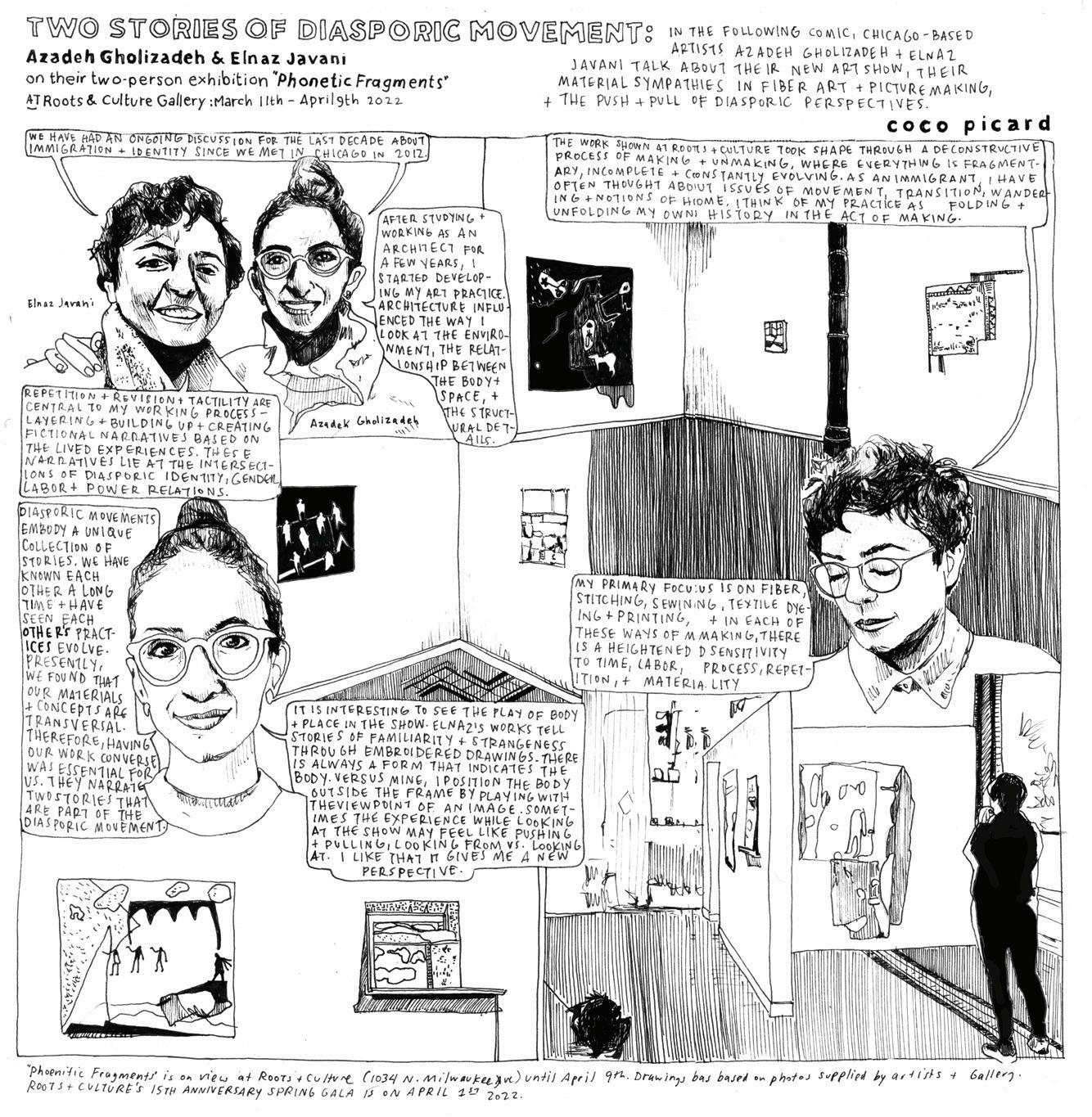
24 CHICAGO READER - MARCH 31, 2022 ll
v @cocolarolo
COMICS JOURNALISM
Find Cannabis with Confidence at Curalea f.

Enjoy 15% o your visit!

Whether you’re a long-time cannabis enthusiast or just getting acquainted with this incredible plant, we’re honored to guide you along your cannabis journey. Let’s talk about cannabis—and let our confidence become yours.

Find out what happens when cannabis and wellness intersect.
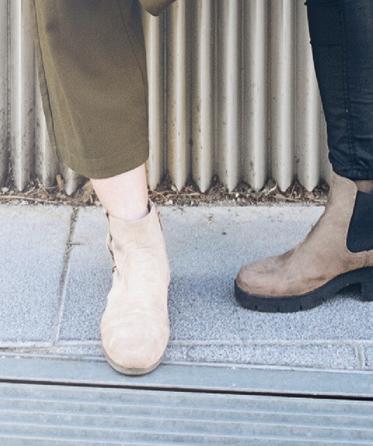


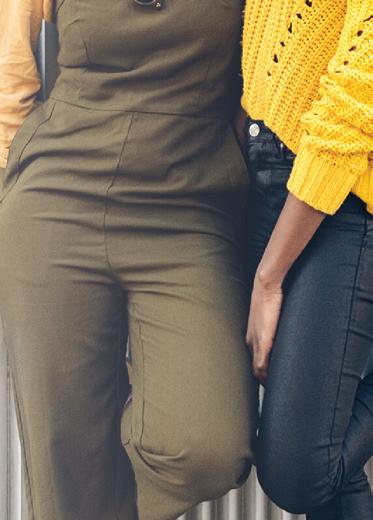
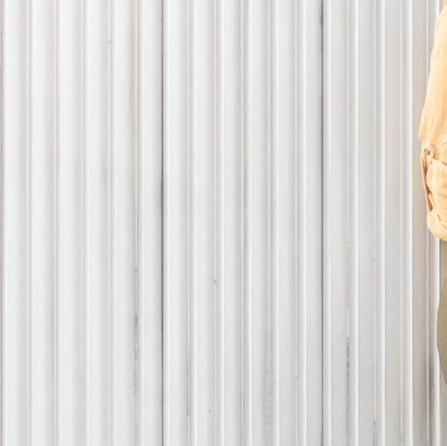




MARCH 31, 2022 - CHICAGO READER 25
@curaleaf.usa
curaleaf.com
SHOP NOW
SPRING THEATER & ARTS PREVIEW



ART EXPOSITIONS

What’s fair about art fairs?




 By MICCO CAPORALE
By MICCO CAPORALE
What’s fair about art fairs? That’s the question at the heart of Barely Fair, a show organized by Garfield Park gallery Julius Caesar that’s designed to run in tandem with the international art fair EXPO Chicago. Founded in 2019, this is the second iteration of the Barely Fair, which quietly marks EXPO’s return to in-person programming following COVID-19.
Thirty independent art spaces and curatorial projects from across the world will gather at the Color Club to exhibit in booths designed at a twelfth of the size of traditional fair booths. While this size constraint poses an exciting challenge to participants, it also invites visitors to consider the scale and expense of traditional art fairs, which serve to push venues like those at Barely Fair out of the broader art conversation.
More often than not, alternative art spaces

are labors of love with thin profit margins. They usually exist in spaces and neighborhoods separate from cities’ main art areas,
R BARELY FAIR


Opening Fri 4/8, 6-10 PM, then on view Sat 4/9, 11 AM-7 PM; Sun 4/ 10, 11 AM- 6 PM; Sat 4/ 16 -Sun 4/ 17 and Sat 4/23 -Sun 4/24, 1-4 PM; or by appointment (email juliuscaesar@ gmail.com) through Sun 4/24. Hosted at Color Club, 4146 N. Elston; barelyfair.com
so such spaces can afford to exhibit work with less market value. Want to make money selling art? Don’t focus on emerging or avant-garde artists or showcase pieces that can’t be sold as tidy commodities to investment-minded consumers.
Of course, art has value beyond its price tag; anyone who’s felt changed by an after-


noon at the Art Institute can attest to that. And yet fairs such as Frieze, Art Basel, and EXPO set standards for what’s considered attention-worthy based on who shows up and what they sell. Bigger galleries consistently drop six fi gures because they can—and do—recoup their investment with just one million-dollar sale, but for smaller galleries, it can cost upwards of $10,000 to do a “cheap” fair weekend. As Julia Halpern at Artnet reported in 2017, art fairs are loss leaders for small galleries.
So with such a high barrier to entry, where does that leave, say, apartment galleries? Shed shows? Artists heavily critiquing capital? Are they less important because they lack the capital to be as visible? In a market designed to make them feel barely there, they can show up and be seen at the Barely Fair.
For a small affair, Barely Fair promises a tremendous breadth of contemporary art. Chicago makes a strong showing with galleries such as Extase, the apartment gallery of Rhona Ho man director Julia Birka-White; Hyde Park’s artist-run 4th Ward Project Space; the Franklin, which is the backyard gallery of artists Edra Soto and Dan Sullivan; and the frenetic and fun Soccer Club Club. Many projects are coming from California, including LA’s Serious Topics, which boasts specializing in the “conceptually messy,” and Left Field from Los Osos, which showcases bold regional art. New York makes a showing, too. International galleries hail from places such as Toronto, London, and Tokyo, but there’s still midwestern pride in Good Weather (which has locations in both Chicago and North Little Rock, Arkansas) and Milwaukee’s Green Gallery. Whether you’re a seasoned aesthete or a casual appreciator or the arts, Barely Fair proves big things can come in small packages. v
26 CHICAGO READER - MARCH 31, 2022 ll
Small scale art from Tony Matelli, Michelle Grabner, and Katy Cowan hosted by Milwaukee’s Green Gallery ROLAND MILLER
@JuggaloReporter
Julius Caesar’s Barely Fair focuses on alternative art spaces.
The future is a community project How do you envision justice? Learn more! envisioningjustice.org/chicagoreader A digitalexhibition and activation kit RE : ACT ION Envisioning Justice is generously funded by: Find hundreds of Reader-recommended restaurants at chicagoreader.com/food










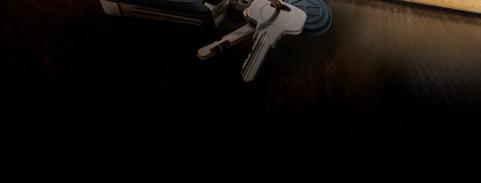




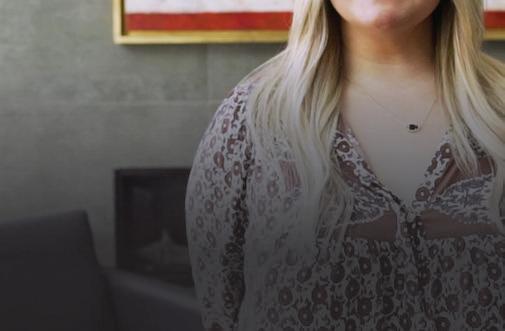
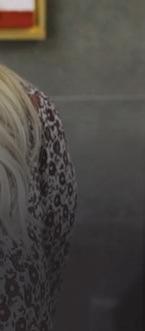






MARCH 31, 2022 - CHICAGO READER 27 KAHLO HER PHOTOS Discover the world of Frida Kahlo. 4.1.22 - 8.7.22 FRIDA Diego Rivera & Frida Kahlo Archives. Bank of Mexico, Fiduciary in the Diego Rivera and Frida Kahlo Museum Trust. Guillermo Kahlo, Frida 1932, Archivo Diego Rivera y Frida ALWAYS FREE Exhibition by WRITTEN BY KRISTINE THATCHER DIRECTED BY TERRY MCCABE TICKETS: WWW.CITYLIT.ORG 773.293.3682 • boxoffice@citylit.org APRIL 15MAY 29, 2022 PREVIEWS APRIL 15 23 $5 off Full Price Tickets! Promo Code: READER Overcome Addiction in 2022 INPATIENT & OUTPATIENT TREATMENT INCLUDING TELETHERAPY, FAMILY SUPPORT & ALUMNI SERVICES Open & Admitting Patients 24/7/365 In-Network with Major Insurance Providers As your journey to recovery begins at our world-class facility, you will be treated with compassion and dignity by our expert team of addiction professionals. Our team is dedicated to treating addiction and healing families and will be by your side from the time you call us through a lifetime in recovery. AT ST . CHARLES Call Today: 331-422-4851 RecoveryCentersOfAmerica.com/stcharles “You deserve recovery.” KAT C. / RCA ALUMNI
SPRING THEATER & ARTS PREVIEW
Circus & Performing Arts Festival (produced by Yes Ma’am), which will bring local performing artists from circus, burlesque, and physical theater to the Den from April 21-24 for ten di erent shows.

In attempting to convey the corporate culture and triumphs of Cirque du Soleil, Lamarre does little to address the plight of smaller companies and festivals like these during the pandemic and recovery, let alone the struggle of circus artists, many of whom were forced to leave the industry due to lack of support. He skips the opportunity to reflect on the future of the sector and wonder: “If variations of the pandemic persist, how will the performing arts world continue to adapt and rebound in order to keep creativity (fueled by its artists) alive?” Creativity is Lamarre’s key word in the book, yet his focus is on the big picture—the business deals and bailouts that keep a corporation robust.
The business of circus
By KIMZYN CAMPBELL
Balancing Acts: Unleashing the Power of Creativity in Your Life and Work (HarperCollins Leadership, January 2022, $28.99) by Daniel Lamarre is a book for those who need creative inspiration. Part business memoir and part self-help/motivational, the appeal of this book will land squarely on the aspiring businessman who needs an icon. It not only celebrates the business braggadocio commonly attributed to male CEOs but also focuses its energy on the business deals of Cirque du Soleil (starting in 2001 when Lamarre arrived) with relatively few musings on the company’s artistic impact in the performing arts—and even less recognition of the creative contributions of its artists, let alone artists outside of the Cirque aesthetic. Apart from a token mention of a female creative (and one POC artist), the mention of almost any
woman in the book is often tied to their status as wives (Beatles’ wives included).
Daniel Lamarre was the perfect hype man for the job. In his two decades as CEO, his tone remained optimistic, even during the darkest moments of the pandemic when he paints a picture of himself stalking the lonely halls of headquarters, manifesting a corporate comeback, and tirelessly facilitating the bankruptcy/reinvestment deal to reinstall the shows (and pay the freelance workers demanding their backpay). Though styled as a book to give business folks a boost of the creative, people in the business of circus will fi nd it a fascinating peek behind the curtain of the most iconic circus company.
In parallel with Cirque’s rebound, the local circus sector is in recovery mode, with Chicago circus schools like Actors Gymnasium,
Chicago Center for Dynamic Circus, MSA & Circus Arts, and CircEsteem back in full operation with a variety of classes to suit all ability levels. The circus shows are keeping pace with the re-emerging Chicago theater scene, with companies like Yes Ma’am Circus, Company To X For, and La Vuelta emerging left and right. The Chicago International Puppet Festival ran in January (at the height of Omicron), and Teatro Zinzanni mounted its second cast not long after. A new wall trampoline show, Unspoken, debuted at Aloft in mid-March, and Cirque Us is slated to appear at several venues around town with their show RagTag (March 26-April 2), while Physical Theater Festival Chicago returns to full live production mode in July. Perhaps the most significant sign of Chicago’s circus recovery is the inaugural edition of the Chicago
Although Lamarre struggles to reconcile being seen as a business square in a suit (by his artsy circus colleagues) with his own sober image of himself, he admits that the cold realities of running a business often clash with the romantic dream of an artistic company. Like when casting executives make the decision on who to hire based not on their artistry but on whether they might have the stamina for a six-day work week of ten shows. Trained athletes fare better than artists, Lamarre reasons. Wouldn’t it be best to hire the athlete and teach them the art than to hire the artist and train them to be physically resilient? Still, he shows some heart (and internal contradictions), professing that while working for Cirque he considered that his mission in life was to create jobs for artists.
Lamarre’s bottom line is to be bold, to innovate, to take risks—all qualities well embraced by the circus world and the business world. Using worn-out aphorisms and sports analogies, each chapter invites you to get there by taking creative risks (Run away with the circus!). What emerges is a mantra for management that Lamarre credits as the recipe for Cirque’s success, something like, “Encourage creativity—but monitor creativity.” Yet if his answer is “creativity”—and his defi nition of the word is “doing business stu that works,” then what is the actual question?
Maybe this: What does the struggle of a
28 CHICAGO READER - MARCH 31, 2022 ll
Kinjaz Dance Crew from Cirque du Soleil’s Twas the Night Before . . . KYLE FLUBACKER, MSG ENTERTAINMENT
BOOK REVIEW
Cirque du Soleil’s former CEO touts creativity in business—while creatives still struggle.
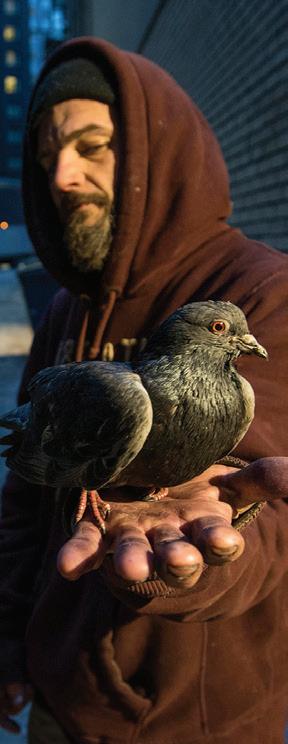















MARCH 31, 2022 - CHICAGO READER 29 The ReaderDaily Get our free daily newsletter delivered straight to your inbox Monday through Friday! Dive into our most recent stories and exclusive insights from our copublishers, editors, and staff writers. LLOYD DEGRANE chicagoreader.com /newsletters
SPRING THEATER & ARTS PREVIEW

Montreal-based circus company (as told by the CEO) to survive a global pandemic have to do with the Chicago arts scene? Perhaps as a case study for local arts companies (circuses and theaters) to model adaptation and agility? Or maybe for arts consumers to understand how the cost of big business a ects the quantity and quality of art, trickling down not to the audience but to the artists (caveat emptor).
Cirque closed up shop with every venue and producer around the world, laying off nearly 5,000 employees in 2020. Yet, Montreal’s circus community, the government, and advocacy agencies (like En Piste) soon partnered with venues like TOHU (an arts venue right next door to Cirque). Together they supported artists with fi nances, COVID-safe residency spaces, and online workshops—using government funding. This model repeated itself in some European countries, while many theaters accepted grants and private funding to improve their structure during downtime instead (new seating, better lights, deeper stages, sleeker lobbies). Often, grant money is earmarked for certain segments of the business, like structural improvements—giving the overall business of performance a means to improve while the actual performers themselves struggle.
Right here in Chicago, unemployed performers had few support streams, yet Steppenwolf Theatre installed $54 million worth of improvements during pandemic closures. Executive director Brooke Flanagan spoke in an interview about how di cult it was for the arts industry, and in the same breath explained, “But we’re thrilled that during that time construction was declared an essential service by the governor and we were able to literally see this building rise.” For Steppenwolf, the improvements granted more access to people who are disabled and will provide more opportunities to offer arts education (workshop and classroom spaces). So it did help the local performing community expand impact, even if actors had to search for paychecks elsewhere.
Perhaps the real question to the answer of creativity should be, “Why do the artists seemingly come last when the future of creativity depends on them?”
In the book, Lamarre seems to agonize over the employees stuck at home, and says Cirque would never risk their health by remounting shows at too fast a pace after such a large work gap. But he wants it both ways,
praising the artists who stayed trained up by setting up rigging in their garages, and crediting them for how Cirque was able to so quickly remount their shows.
Balancing Acts is an entertaining case study. Lamarre’s enthusiasm is contagious— who doesn’t want to ride along on the deals that netted Cirque millions for decades in Vegas? He is a good storyteller. Who doesn’t want to read quirky stories, like when Cirque cofounder Guy Laliberté hired a clown to follow Lamarre around to disrupt his work? He has deep knowledge of the fi nancials. Who doesn’t want to know the sordid details of dealing with creditors—taking a company $900 million in debt, then convincing investors to toss in $375 million so that the company could be valued at $1.275 billion? Presto, the creative financing of bankruptcy turns that negative back into a positive! Ever an optimist, Lamarre still addresses the changes made to reduce costs, to become more efficient and resilient when returning from the pandemic for the next round, rebooting shows. He confidently explains how Cirque had one billion dollars in annual revenue at its height—so perhaps a rebound could quickly resolve things.

Balancing Acts was his final bow, before exiting stage left for the next scene of his life. Call this book his soliloquy then, to reflect on the lessons he learned at Cirque while trying to bridge the gap as he says between art (the idea) and business (the execution of the idea). He speaks about risks and drama, about their uno cial motto that “The show is the star.” (Not the artists. Which explains why none of the performers in the book have their names under their photos, while Lamarre, movie stars, photographers, and costume designers are all clearly attributed.)
Yes, Cirque has a weird corporate culture, and like most big entities, some of their ideas contradict each other. Still, everyone knows that without Cirque, live entertainment would not have risen to the height it is at today in the popular imagination. This is why we go to their shows. They reinvented something grand and elemental about human expression, and like any big business, they will ride it out, focusing on growth and innovation. It is embedded in our Western psyches to both admire and revile corporations thatsucceed at such pursuits. In that sense, it is a book for the masses—for the businessman, and his wife. v
@kimzyn
30 CHICAGO READER - MARCH 31, 2022 ll Choreography Young Dancers Beginners Pointe Pre-Professional Little Dancers Mini Camp Teen/Adult Ballet Creative Movement Pre-Ballet Ballet Floor Barre Modern Hip Hop Tap DISCOVER THE JOY OF MOVEMENT THIS SUMMER AT HPSD! We offer dance classes for all levels from beginner to preprofessional and for all ages from toddlers to adults. Regular Classes Regular Classes Workshops | Camps Intensives Workshops | Camps Intensives Summer 2022 June 4-July 1 | July 9-August 5 Training | Performance | Community www.hydeparkdance.org To learn more, visit www.hydeparkdance.org
continued
from 28




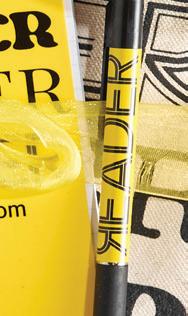
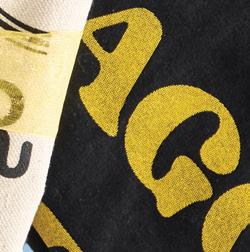

















MARCH 31, 2022 DER 31 SOMETHING READER FOR EVERYONE! store.chicagoreader.com chicagoreader.com/mayabook The new book from Chicago Reader’s own Maya Dukmasova Available in paperback and PDF download A HOME IN CHICAGO: Rent, ownership, and neighborhood struggle since the collapse of public housing
SPRING THEATER & ARTS PREVIEW
Ana Silva ELIAS RIOS
lunch and I got the o er,” she says.
For her fall performance in Theater Wit’s Mr. Burns, a Post-Electric Play, Silva was runner-up for the Reader’s 2021 “best stage actor.” (She lost to Carrie Coon, who is currently starring in HBO’s The Gilded Age.) After that, she took an impromptu break from performing. Despite being vaccinated and boosted, Silva caught COVID-19 and even missed seeing her family over the holidays. The last time she saw them was for her grandfather’s memorial service this past summer.
people who can do this for a living and they don’t have to work at a med spa,” she says. “I’m so ready for that to happen.”
Now a stage actor, writer, comedian, Second City teacher, and candle connoisseur, Silva uses entertainment to “create a world that you want to see.” A master improviser, she has performed with three local troupes, including Improvised Jane Austen and Baby Wants Candy, a long-running musical improvisation troupe with notable alums like Saturday Night Live ’s Aidy Bryant.
The Ana Silva Show
By BOUTAYNA CHOKRANE
Ana Silva is the type to celebrate Groundhog Day.
On a January morning, over Zoom, Silva recounts how she “asked off work” for the woodchuck festivities. She and her boyfriend, actor Andrew Jessop, are driving to Woodstock, where the 1993 classic Groundhog Day was fi lmed. Next on the list is a groundhog-themed pub crawl followed by a bags tournament. They are especially excited to meet mascot Woodstock Willie.
Wearing a Prussian blue flannel, Silva sits in her kitchen. A natural storyteller, she leans forward when she speaks like she’s telling me a secret. Her cocoa curls upstage her espresso cabinets. I can’t see much of her background, except for a large jar of coconut oil and a yellow onion perched on her gray marble counter.
Effortlessly funny, Silva talks about her first taste of stardom—her kindergarten’s rendition of Mary, Mary, Quite Contrary. She was determined to play Mary: the lead who forgot to water the flowers. But she was cast as one of the flowers. “And that’s the story of my life,” she says.
In high school, her only representation on screen was America Ferrera. “How fucked up
that a person who looks like me is in a show titled Ugly [Betty],” Silva says. “It brainwashes you into believing there is no space for you.”
And beyond the lack of TV representation, Silva experienced this bias firsthand o screen. When she studied acting in Los Angeles at the American Musical and Dramatic Academy, she “didn’t fit the media standard of beauty.” One of her teachers told her she wouldn’t fi nd work until she was 30 because she wasn’t a size two. Casting agents would tell her, “We don’t know where you belong,” because she’s Latina but doesn’t speak Spanish. “And it destroyed me,” she says.
This April, Silva will make her debut as Sister Sophia in The Sound of Music at the Marriott Theatre in Lincolnshire, opening in previews on April 13. Rehearsals began on March 28.
“I thought I bombed the callback,” Silva says. After forgetting the lyrics halfway through “How Do You Solve a Problem Like Maria,” and having to start over, Silva left the audition thinking, “‘Well I lost this job,’” she says. Jessop drove her to the callback in the midst of a blizzard, which probably didn’t help the overall vibe. “We came home, and I cried and cried and cried, and we’re having
“I come from a green card marriage,” Silva says. Her father is from Brazil, and her mother, who died five years ago, “was a Jew from Long Island.” Growing up in Portland, Oregon, aka “the cool Portland,” with her parents and two siblings, Silva is the quintessential middle child. Olivia, her older sister, is a nurse who married an electrical engineer and, as a result, is “the pride of the family,” she says (only half-jokingly).
Silva’s parents expected her to go to law school, not acting college, “which is basically clown school,” she says. It’s safe to say they weren’t happy when she pursued live theater, and it wasn’t just a phase. Especially when she moved back home shortly after college to live in her dad’s basement and work at Baskin-Robbins. “People that I went to high school [with] would come in and be like, ‘Why is the valedictorian serving me chocolate fudge?’” Silva says as she laughs.
After dabbling in improv, Silva moved out of her dad’s basement and to Chicago where she fell in love with sketch comedy. Improv allowed the self-described “biracial deviant” to perform with a diverse community she felt safe with. “I ended up fi nding my family here,” Silva says. “It’s through working with them that I have felt empowered to come into my own.”

Having the coronavirus forced Silva to get in touch with her body and ask herself, “What does it mean to take care of myself again?” Since then, she has opened an Etsy candle shop, FireandFlameCandleCo, with Jessop, who she’s been dating for six months now.
Silva also worked as a med spa receptionist, which she describes as “low-key, a therapist service where people put things in their face to convince them that they’re now pretty when they were gorgeous before.” Earlier this month, she quit. “I know that there are
Silva was also a member of Matt Damon Improv, composed entirely of women of color. Occasionally, they would invite a white male or female to perform with them. (I recommend watching their In-Diana webseries, fi lmed entirely on Zoom during peak quarantine. The project won Best Web Series in the London International Web & Shorts Film Festival last year.) The members of Matt Damon Improv went on to pursue individual projects, but they remain best friends. Maria Konopken, a Matt Damon member, remembers when Silva joined their team. After performing with her a few times, they made it o cial. “It was like a proposal,” Konopken says. At a local improv festival, Matt Damon cofounder Allison Reese was handing out wristbands to members. Silva was sitting in the corner, just enjoying her Stella Artois. That’s when Reese turned to her with a wristband and popped the question, “Will you be on Matt Damon Improv?” Silva jumped out of her seat and shrieked in excitement.
Last December, Silva celebrated her 30th birthday. In the last decade, she’s accomplished more than her teacher could fathom, including starring in a Mike’s Hard Lemonade commercial. And after taking a brief hiatus from the theater scene, she’s eager to return to the stage.
Her father now sees why she loves it so much. “But when I told him that I got this [Reader] nomination, his answer to me was, ‘You know, I had a dream last night that you got an MBA and were working on the stock market in New York City,’” she says. While Silva was Rex Putnam High School 2010 valedictorian, she doesn’t want to be a nurse, an engineer, or worse—a fi nance bro.
This May, her family is flying in to celebrate her many accomplishments, including The Sound of Music. They will also be meeting the boyfriend for the fi rst time, but that’s a whole other story. v
32 CHICAGO READER - MARCH 31, 2022 ll
RISING STAR
The 30-year-old stage actor and self-described “biracial deviant” challenges the order of the media world.
@boutaynaaa














MARCH 31, 2022 - CHICAGO READER 33 Relentless is supported by SPONSORS OF THE ORIGINAL PRODUCTION SPONSOR OF THE GOODMAN PRESENTATION Additional support provided by Corporate Sponsor Partner DOUGLAS BRADBURY THE ELIZABETH F. CHENEY FOUNDATION GoodmanTheatre.org 312.443.3800 Groups 10+: Groups@GoodmanTheatre.org RELENTLESS BY TYLA ABERCRUMBIE DIRECTED BY RON OJ PARSON After a sold out run this winter, Tyla Abercrumbie’s world premiere play comes to the Goodman, weaving a mother’s past with her daughters’ present in a centuries-spanning tale of family, legacy and progress. APRIL 1 – MAY 1 TIMELINE THEATRE COMPANY’S PRODUCTION OF “THE BEST NEW WORK IN YEARS” –Chicago Tribune AuditoriumTheatre.org 312.341.2300 50 E Ida B Wells Dr | Chicago, IL Photo courtesy of Renée Elise Goldsberry. TONY-AWARD WINNING STAR OF HAMILTON An Evening with Renée Elise Goldsberry A high-energy evening of pop, soul, and Broadway classics CELEBRATION CO-PRESENTING SPONSORS Ann and Tom Nash Patti Eylar and Charlie Gardner 2021–22 SEASON SPONSORS O cial Hotel Partner The Florian Fund Dance Sponsor Magazine Sponsor ONE NIGHT ONLY! APRIL 9
SPRING THEATER & ARTS PREVIEW
Mouth (a band composed of Magnus, O’Reilly, T-Roy Martin, Vicki Walden, and Heather Riordan) will perform on Saturday, April 2.

The connection to PrideArts came about because Brün was brought in as a consultant when the company started fi xing up the space during the COVID shutdown. PrideArts let Curious use the theater for a three-week tribute to the late Rhino/Curious vet Michael Martin last fall.
PACHYDERMIC PERFORMANCES
The Rhino in spring
The beloved fringe theater festival blooms again.
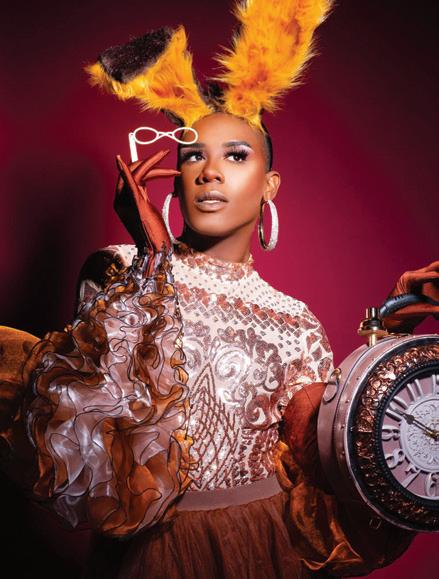 By KERRY REID
By KERRY REID
In January 2020, I checked in with Jenny Magnus about Rhinoceros Fest (better known as Rhino Fest), the city’s longest running fringe theater festival. “The world is really hard right now,” Magnus said at the time. “All we have is each other and the intention to do something good. Aid and comfort. We just need to be paid attention to and we need to be taken care of a little bit.”
That was before COVID-19 wreaked havoc with everything, not least the fortunes of small theater companies like Curious Theatre Branch, which Magnus cofounded with Beau O’Reilly and which has been producing Rhino Fest since the late 1980s. Among other developments since the last Rhino, Prop Thtr (cofounded by Magnus’s husband, Stefan Brün) gave up their longtime two-venue building in Avondale, where Rhino had been housed for many years.
But Rhino is back—or at least, “A Hint of Rhino” is.
Opening April 1 and running through May 7 at two venues—Logan Square’s Jimmy Beans Co ee and the Broadway at PrideArts Center in Buena Park—the latest incarnation of Rhino may be a little truncated compared to the abundant schedules of years past. And unlike past Rhinos, where performers were invited to submit proposals, this year the producers reached out to artists old and new
that they wanted to highlight.
“We’re calling it a Hint of Rhino because it really is di erent,” says Magnus. “It’ll never be like this again. If we do Rhino and when we do Rhino again, it will go back to the bigger submission process of really trying to open the doors to just as many people as we can possibly cram in.” She further notes, “This is our fi rst time doing it in not our own space in like 17 years. It’s the fi rst time doing it in two di erent venues that are at di erent places [in the city] in a really long time.”
One of the other things that Curious and Rhino are trying to come back from is the loss last October of Curious’s longtime managing director, Matt Rieger, who died shortly after being diagnosed with cancer.
Rieger’s work is part of Rhino this year, however; Brün directs Rieger’s play Jimmy and the Nickels at PrideArts (it runs Sundays and Thursdays, with a celebration of Rieger following the 3 PM show on Sunday, May 3). It’s a follow-up to Rieger’s My Dinner With Joe, which ran in the 2020 Rhino. “That play was very humorous and sort of brought up a little world of modern masculinity that is in a crisis, but in a very humorous crisis,” says Brün. In Rieger’s last play, “There’s three old guys who run this little shop and they’re all Jimmys and all they got is nickels,” says Brün. “There’s actually a nickel shortage
and they’re old-fashioned Luddites who don’t want to adapt to new tech. They just want to keep things really simple.” He also notes that the PrideArts space (and possibly Jimmy Beans) will have a listening station so audiences can hear Rieger’s Aviva Green: The Rebirth of Bleak , inspired by his noiresque play Crossing Aviva, which Curious produced in 2018. The episodic follow-up was recorded as an audio drama for Rhino at Experimental Sound Studio; it’s also available as a download through Bandcamp.
A Hint of Rhino: Rhinoceros Theater Festival 2022
4/1-5/7: performances at Jimmy Beans Coffee, 2553 W. Fullerton, and the Broadway at PrideArts Center, 4139 N. Broadway; full schedule and tickets at rhinofest.com, $20 or pay what you can. (The Broadway is wheelchair accessible; Jimmy Beans is up one flight of stairs.)
Magnus and Brün both note that the two different spaces will offer different kinds of programming. The more intimate room at Jimmy Beans, where O’Reilly has been organizing Saturday cabaret-style shows, will feature music and storytelling; opening night features an evening of new speculative fiction from Sharon Houk, Andy Sullivan, and Tanner Vaughan Halversen, and the Crooked
Chicago Beast Women, who bill themselves as “Chicago’s longest-running showcase for veteran and premiering female artists,” will take the Saturday late-night slot at PrideArts for Rhino. Labyrinth Arts and Performance Collective, run by Diane Hamm, will offer The Labyrinth Hour Cabaret, featuring several drag artists (including Eve the Bunny, Narcisca, and Slussy Vanity) as well as sketch artists John Klingle and Paul Brennan in John & Paul: Strictly Platonic at PrideArts. Even in this somewhat-smaller format, putting together Rhino Fest remains a gargantuan task (one that Magnus sadly notes is even harder without the administrative chops and general joie de vivre of Rieger to lean on). So why do it?
“It’s the philosophical question for us as a company, for sure,” says Magnus, “and for us as makers. Why should we do this unbearable amount of work that is just so exhausting? We really sit and go, ‘Do we really want this again?’ And the answer always comes down to: we could just be making our own little stu in our own little corner and that could be enough. Or we can extend ourselves and support other artists who don’t have a company with money behind them. We support artists who don’t have an infrastructure, who don’t necessarily even have collaborators. We can support artists who want a low-stakes environment for their work.
“So I think it is sincerely about wanting to be of service to the community and the tremendous feeling of togetherness that brings. We call it the Rhino bliss. It’s the summer camp feeling. There’s nothing like it when you’re in the lobby and people are coming out of one show or going into another show, and there’s this mix of all kinds of people.” v
34 CHICAGO READER - MARCH 31, 2022 ll
Le : My Dinner with Joe, 2 020 Rhino Fest. Playwright Matt Rieger is on the far le . Right: Eve the Bunny performs this year with The Labyrinth Hour Cabaret JEFFREY BIVENS/ERIC MAGNUSSON
@kerryreid



MARCH 31, 2022 - CHICAGO READER 35
PHOTOS BY ANDREW ECCLES
Audience members are all required to be masked and show proof of vaccination. For those with exemptions, proof of a negative COVID-19 test is required. For the latest health and safety procedures and guidelines visit BroadwayInChicago.com/COVID19.
SPRING THEATER & ARTS PREVIEW
‘Creating accessibility programming benefits everyone’
How COVID has changed theater for people with disabilities
By BRIDGETTE M. REDMAN
Everything is di erent as the performing arts world feels its way back into being together and breathing the same air, but in a way that won’t infect and kill each other.
As everyone hopes to be headed toward a post-pandemic world, the question of accessibility, of fi nding a way to bring everyone— and not just select groups—together continues to be asked and answered in new ways.
A.B.L.E. Ensemble’s goal is to provide performing arts experiences for people with Down syndrome and other intellectual and developmental disabilities. With an acronym standing for Artists Breaking Limits and Expectations, the ensemble had to think carefully about the needs of its participants this year, needs that they recognize have grown in intensity because of years of isolation.
This spring, they have four ensembles serving a total of 35 actors ages 16-52.
“Since this is the first time many of our actors have been together in person in over two years, we’re doing something a little different this spring,” says Katie Yohe, A.B.L.E.’s founder and artistic director. “We’re focusing our semester on rediscovering the joy of being together, playing games, and enjoying some time to play.”
Instead of picking a show and working toward producing it, they’re going to livestream their rehearsals May 22-24 and let audiences get a behind-the-scenes look at their process.
“Social situations take a lot of processing energy, and we all need to rebuild those
muscles,” Yohe says. “I’m exhausted after a trip to the grocery store, let alone a two-hour rehearsal. I’m so glad we’ve been able to o er programming throughout the pandemic, but sitting in your Zoom square is defi nitely not the same as being up and in 3D.”
Seesaw Theatre produces multisensory theatrical experiences for small audiences, giving each audience member an “adventure guide” who plays with them throughout the performance. During the pandemic, it created virtual, sensory-based theater.
According to a letter on its website from artistic director Ilana Abusch and executive director Julia Hogan Laurenson, “Although we missed getting to interact with our audiences in person, a silver-lining we found in this virtual year was that our work became far more accessible, and we were able to serve far more audience members than we have in our normal, in-person years.”
Their tenth-anniversary 2021-2022 season includes three shows. Dates have not yet been announced for the spring show, Dino-Mite Dig.
It isn’t just the theaters committed to creating space for people of all abilities that have had to make changes to their accessibility options. Charlotte “Chuck” Gruman is an arts accessibility consultant who was coordinating sensory-friendly performances and accessibility options for the Goodman, Second City, and others when the pandemic hit. She was training theater sta on how to interact with people who have disabilities
and crafting social narratives to prepare people for a theater experience.
Gruman describes herself as being on the spectrum and having multiple categories of neurodiversity, abilities that she brings to her consultancy as she works with arts organizations. The pandemic, while cutting o access for many people, also brought organizations further into the world of accessibility almost overnight.
“[Organizations] are defi nitely still doing accessible programming, but access is changing,” Gruman says. “It ended up helping the theater community. They had never thought of the importance or demand of having closed captioning on their videos and image descriptions for their shows. Overnight, they created online access to shows, or recorded
SOME ACCESSIBLE SPRING SHOWS
By and for those with diverse abilities
Special Gifts Theatre presents Disney’s The Lion King Jr., 4/23-4/24, Walter R. Sundling Junior High School, 1100 Smith Street, Palatine, with virtual shows 5/5-6/5. It also o ers Disney’s Moana Jr. , now through April 24, virtual edition, specialgiftstheatre.org.
Tellin’ Tales Theatre , Divercity ; 5/6-5/8, place TBD; Teen Tales , 6/25-6/26, Loyola Park, tellintalestheatre.org.
Special access options
Goodman Theatre, Good Night, Oscar, 4/9 2 PM, audio description and touch tour; 4/15 8 PM, ASL interpreted; 4/16 2 PM, captioning; Relentless, 4/24 2 PM, audio description and touch tour; 4/30 2 PM, ASL interpreted; 5/1 3 PM, open caption, goodmantheatre.org. Lyric Opera of Chicago, Tosca , 4/9 2 PM, audio description, lyricopera.org. Northlight Theatre, Intimate Apparel, 5/4 7:30 PM, sensory-friendly performance; 5/7 2:30 PM, audio description, captioning, northlight.org.
Shattered Globe Theatre, Rasheeda Speaking at Theater Wit, 5/6 6:45 PM, audio description and touch tour, sgtheatre.org. Chicago Shakespeare Theater, All’s Well That Ends Well, 5/18 1 and 7:30 PM, captioning; 5/20 7:30 PM, ASL interpreted, chicagoshakes.com.
Steppenwolf Theatre, Seagull, 5/19 7:30 PM and 6/11 2:30 PM, captioning; 5/22 7:30 PM, ASL interpreted; 6/5 2:30 PM, audio description and touch tour, steppenwolf.org.
access.”
Theaters are still offering large-print programs and accessibility stations with sensory-friendly tools and a social narrative.
“Creating accessibility programming benefits everyone,” Gruman says. “Even though it might be designed for someone who is blind or has low vision, it is also super helpful for someone with ADHD or autism.”
Touch tours—an accessibility option that allows people to touch the stage and the fabrics of the costumes—are formatted di erently as Equity currently forbids non- company members from being on union stages.
Andy Wilson, house manager for the Goodman, says they have a specific date set for each production that o ers audio description and what is now being billed as “alternate pre-show sensory introductions” that are acting as the touch tours. These tours start with the costume shop bringing out wardrobe pieces to the lobby, describing them, and inviting audience members to touch them. They then move into the space, and the audio describer gets on the stage and describes it while walking through it, sometimes knocking on parts so audiences can hear where the audience describer is standing and what they are talking about.
“We used to be able to do a stage walk with our guests, but our current Equity rules for COVID safety is that we can’t do that for now,” Wilson says. “But we are hopeful that will come back soon.”
Instead, they have designers bring stage models out so that people can run their hands along them and get an idea of the spatial arrangement of the stage. People involved in the show, from actors to choreographers, come out and talk to the audience, focusing on physicality and physical descriptions of what they look like, how they move, and how they sound.
How can people find accessible programming? Two organizations offer calendars: ChicagoPlays.com, the website of the League of Chicago Theatres, usually has a calendar of accessible events, but it is currently down. They hope to have it up and running again in the next couple weeks.
Meanwhile, the Chicago Cultural Accessibility Consortium has a calendar of all accessible arts events in the city, from the Lyric Opera of Chicago’s audio description of Tosca to captioning at Second City. That calendar is available at chicagoculturalaccess.org. v
36 CHICAGO READER - MARCH 31, 2022 ll
THEATER
FOR ALL
@BridgetteRedman









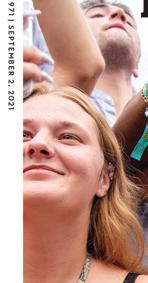

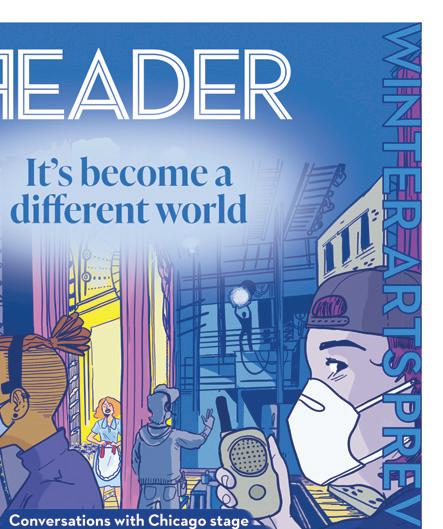




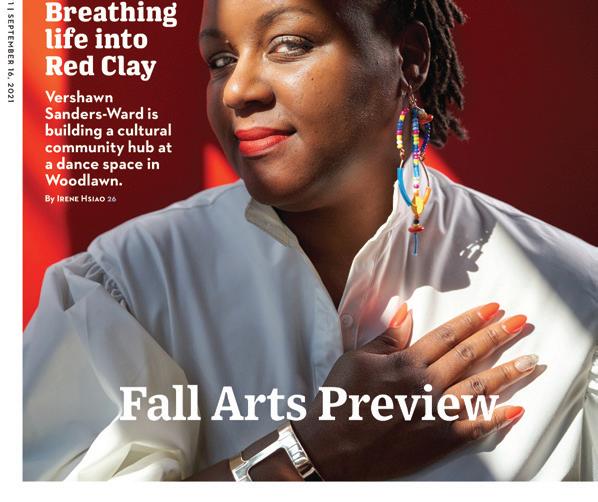

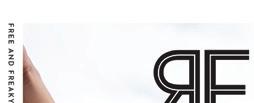










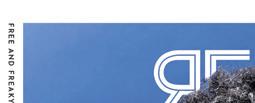



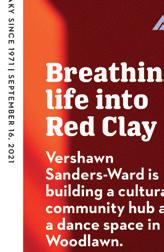










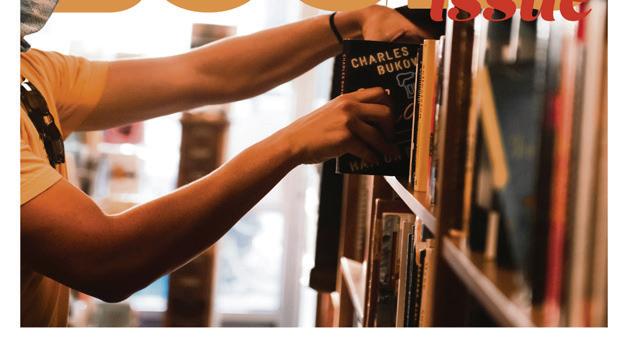
MARCH 31, 2022 - CHICAGO READER 37 2021/22 GRAND BENEFACTORS 2021/22 BENEFACTORS Tickets start at just $20 | steppenwolf.org | 312-335-1650 | | steppenwolf.org/welcomeback KING JAMES NOW THROUGH APRIL 10 By ensemble member RAJIV JOSEPH Directed by Tony Award winner KENNY LEON “LIKELY WILL BE A BIG HIT FOR STEPPENWOLF AND RIGHTLY SO” - CHICAGO TRIBUNE “KING JAMES IS VERY APPEALING, MAXIMALLY RELATABLE… ESPECIALLY BREEZY AND FUN TO WATCH” - CHICAGO SUN-TIMES “SLAM DUNK OF A PLAY… MAGNIFICENT” - THEATERMANIA Providing arts coverage in Chicago since 1971. chicagoreader.com
SPRING THEATER & ARTS PREVIEW
ater would cast a Mexican American girl as Annie, the famously red-haired orphan. Fortunately, she got the role and soon went on to perform in her first professional theater production at American Girl Theater in downtown Chicago. (The venue, located in the basement of the American Girl Michigan Avenue store, ran musicals based on characters in the popular line of dolls; it closed in 2008.)
genres of theater and pop music. “It’s pretty much the dream role that my younger self could have thought of for me,” says Carrillo. However, it would be an agonizingly long wait before this dream came true. After her video audition and initial callback in early 2020, the COVID-19 pandemic shut down theaters across the country, including at Disneyland, where she had just debuted as Elsa in Frozen
Homecoming queen
By EMILY MCCLANATHAN
An all-new cast of queens begins its reign in Chicago with the return of Six , the musical by Toby Marlow and Lucy Moss that transforms the famous wives of King Henry VIII into pop stars. The hit show from the UK had its North American premiere at Chicago Shakespeare Theater in 2019, opened on Broadway in 2021, and launched its North American tour at Broadway in Chicago’s CIBC Theatre this week, where it plays through July 3.
Gabriela Carrillo, who was raised in the Chicago suburbs of Palos Park and Palatine, plays the role of Catherine Parr, the sixth and final queen (or the one who “survived,” per the popular mnemonic device). With a background in both pop music and theater, Carrillo considers it her “dream role” to star in this pop musical and is thrilled to open the tour in Chicago, making a “full circle” return to the city where she got her start as a performer.
Carrillo has connected with her character in several meaningful ways, beginning with the fact that both are writers. “[Parr] was the first English queen to publish a book
under her own name, historically,” she elaborates. As a songwriter, Carrillo relates to this aspect of her character, also noting that she and Parr both tend to be “analyzers.”
“It’s not always that you get to have much in common with characters, and that’s OK, because that leads you through a journey of being able to find ways to relate to them. But there are a lot of parts of me that are very Catherine Parr.”
“ I think [Parr] leads with heart and integrity,” Carrillo adds. “That’s a parallel to something that I’ve done in my life, when I wanted to get into the pop music game— questioning if I was really leading with my morals, leading with my heart, and with what I felt was right.”
C arrillo first performed in a musical at her elementary school and later begged her parents to let her audition for a community theater production of Annie at Cutting Hall Performing Arts Center in Palatine. Her supportive parents helped her prepare for the audition, although Carrillo later learned that her father, who is an immigrant from Mexico, had wondered whether the the-
While attending high school at Woodlands Academy in Lake Forest, Carrillo explored a range of artistic pursuits—orchestra, choir, plays, musicals, and even directing an a cappella group. She also discovered a love of songwriting and would spend hours writing music in a practice room at the school. “Something just lit up within me,” she recalls of her early days as a songwriter. “There was this voice inside me that was saying, ‘This is what you need to do.’”
This newfound calling led her to Berklee College of Music, where she studied songwriting and vocal performance with a minor in drama. “I always knew that I wanted to keep theater and acting in there,” Carrillo says, “but I really had a passion—and have a passion—for songwriting and for pop music. My dream for a long time was to be a pop star.” She began to release original music during college and moved to Los Angeles after graduation to pursue a career in pop music.
A lthough she formed fulfilling professional relationships in LA and “made some music that I’m so proud of,” she began to have doubts after learning more about what it would take to become a pop star. “A lot of it didn’t have to do with the music that I wrote or my talent,” says Carrillo. “A lot of it had to do with . . . putting out music that didn’t feel like it lined up with my integrity.”
“I started to really question, ‘Am I willing to jeopardize my integrity and my artistry, for what—fame? Is that really all that I am looking for?’ And I realized that it wasn’t,” she recalls. Still wanting “to entertain people and share my voice,” Carrillo returned to theater. “Once I started booking theater jobs . . . I remembered why I had loved it so much when I was younger, and it just ignited this passion and this joy inside of me.”
Then, along came an audition notice for Six , a show that exuberantly crosses the
“I was just praying the whole pandemic that they wouldn’t forget about me and that I would still have this opportunity, because it really was one of the lights at the end of the tunnel,” Carrillo recalls. Finally, she heard back from the Six team as theaters began to reopen in 2021. After more Zoom meetings and in-person auditions in Chicago and New York, she was cast as Catherine Parr.
When she called her parents to tell them she would be playing Parr, “we were just giddy,” Carrillo says. “They might have been more eager to hear back than me, because they have really supported me through the journey of being an entertainer.”
An active vlogger, Carrillo is documenting her Six journey on her YouTube channel, under the username “Gabriela Carrillo,” where she shares a behind-the-scenes look at the daily life of a touring actor.

O pening the Six tour in Chicago, where her parents, high school friends, and even several of her elementary school teachers
SIX Through 7/3 : Tue 7: 30 PM, Wed 2 and 7: 30 PM, Thu-Fri 7: 30 PM, Sat 2 and 8 PM, Sun 2 PM; Sun 4/3 and 4/ 10, 2 and 7: 30 PM; Wed 4/6, 7: 30 PM only; CIBC Theatre, 18 W. Monroe, 800 775 2000, broadwayinchicago.com, $ 35 50 -$175 50
will see her perform, “means everything” to Carrillo. “I have dreamt of doing a show in Chicago since I left when I was 17,” she says. “I missed Chicago, and I wanted to find a way to get back and perform there.”
A s for the audiences who come to see Six , “I hope that their spirits are lifted and they leave with a sense of joy,” says Carrillo. “I also hope they leave with the desire to reframe certain narratives that they’ve been told about their lives . . . and to lift each other up—especially young women,” she adds. “Lifting each other up instead of pitting women against each other—I think that’s a wonderful message of the show.” v
38 CHICAGO READER - MARCH 31, 2022 ll
Gabriela Carrillo COURTESY BROADWAY IN CHICAGO
ROCK ’N’ ROLL ROYALTY
Chicago-area actor Gabriela Carrillo returns in Six.
@Emily_221B





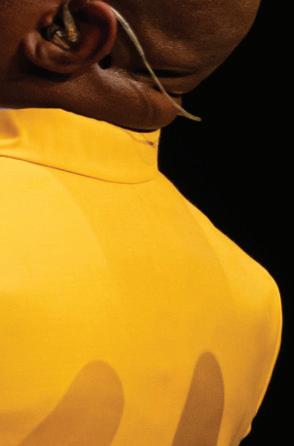




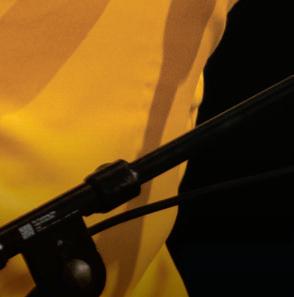

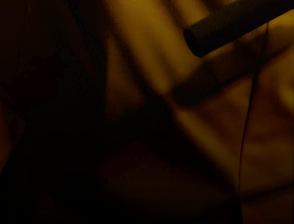















MARCH 31, 2022 - CHICAGO READER 39 Emancipation by Adrian Dunn The Adrian Dunn Singers + Rize Orchestra April 29, 2022 / 7:30PM What does it mean to be Black and free in America in the 21st century? Emancipation seeks the answers to that question through an exploration of love, loss, queerness, Black liberation, and the human experience.
21/22 The Irving Harris Foundation, Joan W. Harris HTP Mainstage Sponsor The Lohengrin Foundation Engagement Presenting Sponsor Corporate Sponsor 312.334.7777 | harristheaterchicago.org | 205 East Randolph Street The Adrian Dunn Singers Family Series April 30, 2022 / 2:00PM
Photo by Todd Rosenberg.
SPRING THEATER & ARTS PREVIEW
‘A lot of us took on breaking because we were missing something from our lives’
Breakers in the city talk about creating community through practice.
By IRENE HSIAO
Feet sizzle and fly like minced onions on a hot pan. Limbs wind into a knot, then spring loose. Fulminant levitation— transformation of momentum into moving sculpture—acrobatic play. When someone falls, it’s kidneys to concrete. Toprocks, footwork, power moves, threading, freezes: infinitely variable elements that throw bodies down to the ground and up to the sky at heartstopping speed, driven only by a human engine.
Breaking began in the Black and Latinx communities of the Bronx in the 1970s as a street dance of resistance, resilience, community, and territory. In parks, in clubs, at parties, and in battles, the art form developed, then exploded worldwide on television and in the movies in the 1980s—seemed to vanish—then reemerged in the aughts on shows like So
You Think You Can Dance and America’s Best Dance Crew . After debuting in the Buenos Aires Youth Olympic Games in 2018, breaking joins surfing, skateboarding, and sport climbing as an Olympic sport in Paris in 2024.
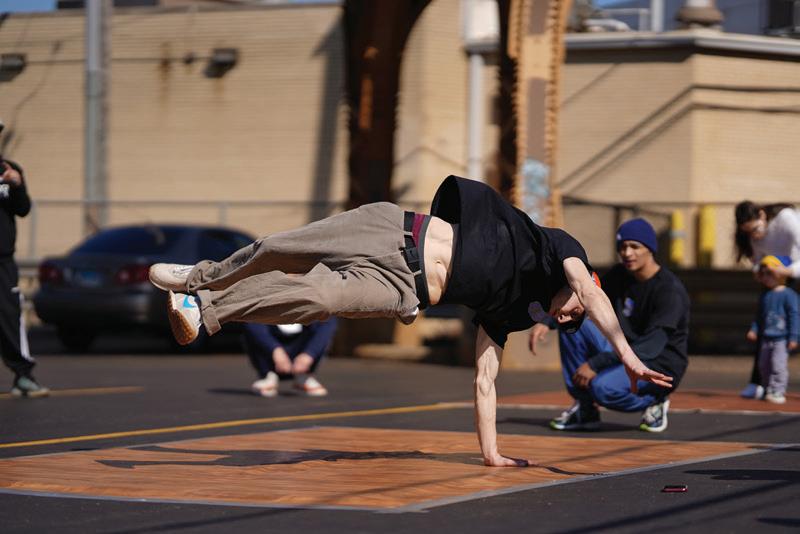
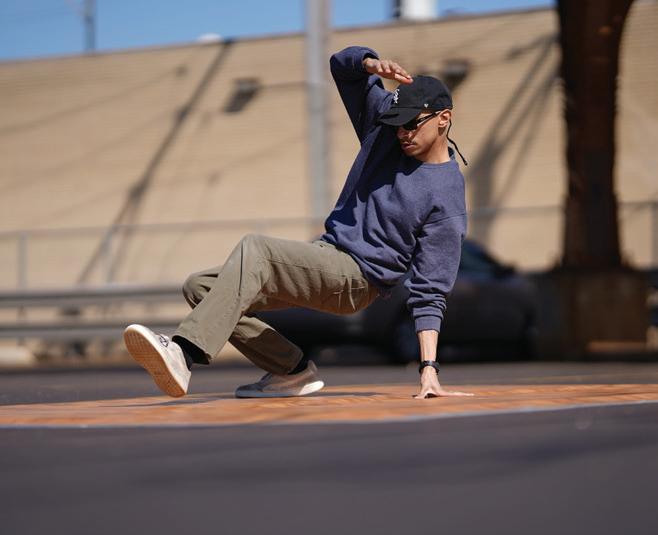
Despite a tumultuous rise and fall in the mainstream, breaking has continued underground from year to year, passed on through VHS, DVD, the Internet, classes, and the old-fashioned way: person-to-person, in practice. In Chicago, open practices—currently regularly held at the Clarendon Park Fieldhouse in Uptown and the Firehouse Community Arts Center in Lawndale, as well as in a photography studio in Blue Island, the 1213 Art Center in Englewood, and at a daycare in Cicero—are where dancers refine their art and build community. In these spaces, everyone is a teacher, and everyone is a student—and the
community that forms reaches far beyond the block, the neighborhood, the city, and even the country. Below are stories of some Chicagoans who have held and transformed the practice in our town.
Angelina “Miss Sweetfeet” Rich-Usher, began open practice at Clarendon Park I grew up watching people break. I used to go to lowrider shows—people drop their cars low to the ground, trick them out, airbrush them. Usually DJs spin, they have a floor, and people will be dancing. I saw some guys dancing and thought, “I want to learn how to do that!” I started trying to mimic them, but they dismissed me as some girl.
One of my friends, Kid Jungle, said, “I’ll teach you.” So he would teach me little things, and I would go home, practice, and bring it
back: “Got it, teach me more!” It was a hunger. He began borrowing space from Kuumba Lynx out of Clarendon Park. He would teach me and a few other ladies there. He teaches a lot, especially kids, so eventually I took over.
I started an all-female practice at Clarendon in 2010. I wanted a safe space where women would feel more empowered. Back in the day there weren’t many girls. When I was practicing, I don’t think there were any. I used to go to Alternatives. It was intimidating to walk into a room full of men. I’m here to practice, but sometimes they don’t take you seriously. You really have to prove yourself. And as a woman, your body’s built differently. Sometimes it’s easier to learn from another woman. When women see me, they think, “If she can dance, then I can dance.”
I had to give up the practice in 2015 because of family issues, but I didn’t want it to end because it was a safe space. I told Metro [Melissa “Metro” Metro] to sign up. It’s nice seeing other women do their thing. “Each one teach one.” That’s my favorite quote.
Sengvilay “Kid Jungle” Aphay, teacher
I was born in Vientiane, Laos. We were refugees after the Vietnam War. I grew up in Rockford in a strict Asian household. My dad was all about study, study, study. He had my life mapped out for me already. He wanted me to join the Air Force, even took me to a recruiter. He didn’t let us go out much.
40 CHICAGO READER - MARCH 31, 2022 ll
DANCE
I saw breaking on TV and taught myself how to do some footwork and toprocks, and in high school, I met some guys who were into breaking, too. We started hanging out and practicing. A lot of people gravitate towards breaking and hip-hop culture because it isn’t about where you came from, just how good you are. A lot of us took on breaking because we were missing something from our lives, and breaking gave us that outlet. I was shy and awkward, and breaking gave me confidence, it gave me my own personality.
I’ve always taught here and there, tips at practice, things like that. I have a friend,
Bravemonk, we used to hang out every day. Some days he’d teach class at a high school, and I’d go with him. I started seeing how he was putting his class together. He showed me how to put together a curriculum, which elevated and manifested me into doing my own.
My class became an all-women’s class—it wasn’t designed to be, I opened it to everybody. I was teaching out of Bravemonk’s apartment at the time, and over time it moved to the Clarendon Park Fieldhouse. Eventually I gave it to Angelina and she carried it on from there. It’s nice when you come in as a woman and see where there are more women involved. It’s a male-dominated dance; it can get intimidating. It was more competitive then; everybody was concerned about getting their own reputation up. I had a di erent goal. I had children young and needed to create some stability. I was more interested in building a program than competing.
OPEN PRACTICES
Clarendon Park Fieldhouse 4501 N. Clarendon information at facebook.com/ groups/164378466949750
Firehouse Community Center 2111 S. Hamlin information at facebook.com/ groups/355536171867510
Blue Island Breakers
12945 S. Western Ave, Blue Island information at facebook.com/ groups/2440796099466592 and www. instagram.com/blueislandbreakers/
UPCOMING EVENTS
The Breaking Program 4 Year Anniversary/Youth Breaking Battle
295 Golf Mill Center, Niles April 16, 4:30-8:30 PM $10 at the door
Writer’s Bench Battle for the Eagle
Illinois Centennial Monument at Kedzie, Milwaukee, and Logan August 7, Noon-8 PM, Free
I did karate for a while at Enso Karate downtown. They go to karate tournaments and developed a nice community. I thought, “This is something we need for breaking.” Most times at schools, kids would do a recital. There was no transition from studio to breaking battles. I wanted to do something only for kids and for everybody in the city teaching kids, something they could work towards, a bridge to kids in other studios and even other states. [From 2014 to 2018] that became the Breaking Dojos Battle.
I’ve been teaching at Latin Street Dance Academy for ten years. The goal of breaking is for dancers to find themselves. You just have to know never to give up, and your skills will eventually shine. One of my biggest classes was 22 toddlers. Parents love seeing their kids come in and leaving happy, tired, sweating. They get a workout.
Melissa “Metro” Metro, hosts open practice at Clarendon Park with Jason “Jay-Spin” Poleon
What they called hip-hop growing up in Chicago was studio dance, choreography. I started breaking in Philly. I was a jazz dance major in college, and Moncell Durden was my teacher. He brought me to clubs and got me into the hip-hop scene. I met Jay [then a dancer with Illstyle & Peace Productions] at a house music party. We hung out for a year, then started dating. I was like, “I can’t be your girlfriend and not know how to 6-step freeze.”
Jay and I took over the Clarendon practice right after we got married. CJ [Williams] had practices at Alternatives Tuesdays and Thursdays. Angie had practices at Clarendon
SPRING THEATER & ARTS PREVIEW
Park on Mondays and Wednesdays. Angie took me in. She said, “I’m hosting female-friendly practices.” She would kick guys out—she’d say, “If you’re not here to share with us, you can’t stay.” There’s never that many bgirls. Sometimes girls will get catty, but Angie was never that way. She was like, “We can’t be battling each other—it’s hard enough with the guys. If your homie gets better than you, it’s going to make you better.” Angie set the vibe for everything. I started breaking with Angie Monday/Wednesday, Jay was practicing with CJ Tuesday/Thursday.
After Alternatives shut down practices, Kuumba Lynx brought CJ and Justin to Clarendon. For a while, it was Monday/Wednesday girls, Tuesday/Thursday guys. I would go on Thursdays, but a lot of girls were not comfortable. Then we lost Wednesday nights to yoga. I was just starting to break—I was like, “I need to learn this!” I basically took over practice so I would have a place to practice.
We were the only ones hosting open practice when we took over. And when I took over from Angie, I said, “We’re all gonna be cool or don’t come. We have a big space; whoever wants to come can come.”
It’s just a space. People need a space to do what they do. We’re coming together as a community to work together.
CJ “Blak Atak” Williams, hosted open practice at Alternatives, Inc. 2002-2012
I started breaking in 1998. I used to do gymnastics, and one of my coaches would show me moves as warm-up skills or messing around on downtime. I always loved it. In high school, I met peers who were more down with hip-hop culture, and I submerged myself—all I did was breakdance and do gra ti. I met my mentor Saul “Spinmaster” Portillo. He and another guy, Raul Gonzalez, really showed me the Chicago breaking scene, the crews, the bboys. They showed me how to breakdance in Chicago, and I never stopped!
When I was 19, I created an after-school program with Justin Grey and Jesse Livingston called Connect Force at Alternatives on Sheridan and Lawrence. From 2002 to 2012, we taught hip-hop arts to youth and helped them with their homework. The last two hours were an open practice.
Hip-hop culture traditionally includes four elements: bboying, graffiti art, DJing, and MCing or rapping. We add a fifth element, knowledge of thyself: how you are internalizing what you’re learning and giving back to your community. You can make your money
and drift o , but it’s important to give back to your community, those before you, and those after you. It’s important to stay rooted.
There should be way more people breakdancing in Chicago, way more women, way more kids. I’ve been breaking for 23 years. For me, it’s not a fad. I’m still going to go when I’m older, even if I’m not dancing, to show up for and support the community.
Joseph “Ca$h Flow Joe” Alfano, host of Blue Island Breakers at Forever Photo Studio in Blue Island
My mom was a high school teacher—she put a catalog of community center classes in front of me and said, “You have to pick one.” There was basketweaving, theater—ooh, breakdancing, let’s do this! Seventeen years later, I still talk to that teacher [Christopher Courtney, artistic director of Culture Shock Chicago] almost every day.
For a long time, I was just taking classes once a week. Then Chris linked me to Alternatives, where I started connecting with the greater scene. I started going to open practice and eventually I moved to the city. Whenever I saw people trying to host, I was there to support. When the 1213 opened in Englewood [1213 W. 63rd Street, hosted by Justin Grey], I was at all the events—and they were my motivation. I was like, “I have a space. I should put resources into making a space of my own.” Blue Island Breakers has been around since October 2019. It is all-inclusive—anybody and everybody can come through. At the end of the day, hip-hop is really about community. There’s not a lot of ways to create a living from breaking. You can teach, or you’re on the Red Bull BC One All Stars traveling the world, and there’s few in between. Some are traveling to compete and maybe win cash, but it’s nothing you can live off of. People have families and bills to pay. It’s tough to be united as a crew when everybody has different backgrounds and struggles.
That was one of my motivations—I never wanted anybody to pay to be at practice, and I’ve been consistent with providing food after practice to make the space more than just dance practice. It’s a space to connect and engage with your community members. I invite my friends—I’m always busy, but you can always catch me at practice. As a host, the satisfaction is helping people. I’ve had plenty of days when my world is crashing and being at practice and being present in the moment, it does me a world of good. That’s my community and my social life.
MARCH 31, 2022 - CHICAGO READER 41
Le : Marco “2Le ” Sepulveda. Right: Bboy Ram1n DUWAYNE PADILLA FOR CHICAGO READER
SPRING THEATER & ARTS PREVIEW
Danny Modest, breaking dad, host of a popup open practice in Cicero
A few classmates were breaking in high school between passing periods, in the hallways, hiding by the auditorium. I would try at home, move furniture around, try in the kitchen. I broke mom’s light fixtures a few times. That was the way to learn back then.
My kids David and Jacob are ten and 11. I introduced them to the art form four years ago. I was their primary teacher at first and taught them fundamentals. In Cicero, we had a rec center in a retired firehouse, and they were offering a breakdancing class! We weren’t used to that back in the day; we would rewind the VHS tapes that we could get our hands on or just try to remember what people did and practice at home.
Marco [Sepulveda], Bboy 2Left, was one of their mentors. Not enough kids were signing up for classes, so they pulled the plug, but he was allowed to go in there and have practice. He said, “As long as you sit here, and we’re not liable for anything, they can practice.” Then the pandemic shut down the firehouse. In those times, we got invites from Chikis and Beest Boy [of the Brickheadz Crew] to start coming through the park, practice by the beach, on the lakefront.
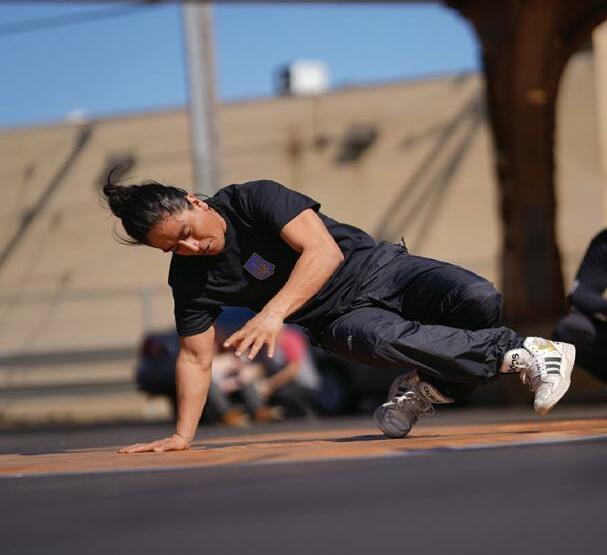
My wife’s mother was working on a home
daycare. The building was up and running, but it would take time to get it going. We needed a spot, so I said, “Would you mind? We’ll clean up!” She said, “As long as this helps my grandkids keep advancing on their craft.” That was incredible. Once I started hosting practice, it was like a thank-you to everyone who helped my kids.
Now I’m going on a ride with them. I haven’t been in the scene for 20 years. Some breakers were just starting then—now they’re just incredible. Hearing their stories, how much they’ve traveled and competed. We were practicing with Bboy Evol [Ernesto Castelo] at Clarendon yesterday—I saw him in his younger stages, we would have house parties, he used to get down—windmills, Supermans. Him giving my kids pointers now is awesome, and his own son is learning.
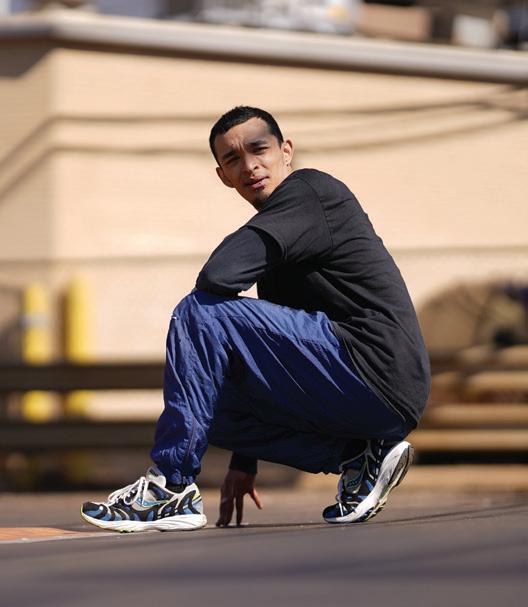
People said “breaking is dead” in the 80s—it never died. It kept going—it’s going to the Olympics. But it doesn’t have to go to the Olympics to be cool. Breakdancing will always be cool. The person who does it is always cool. I’m glad my kids are doing it. I hope people in my family always do it, maybe my kids’ kids or nephews and nieces.
Sergio “Beest Boy” Rodríguez, Brickheadz crewmember, co-organizer of “Stand with Ukraine” with Brickheadz and Project
Logan
I grew up on the south side of Chicago. I started breaking when I was 13 at the University of Hiphop, a community center on 64th and Kedzie. What really got me in was gra ti, because they used to teach all the elements, gra ti, rap, DJ, breaking. I saw breaking there and decided to pick it up. I was inspired by the people around it. There were a lot of gangbangers in my neighborhood. Breaking was an outlet to stay away from negativity. Having those people around shifted me away from that—you can still be cool and not have to do the bad stu .
My teachers were experienced dancers and have been around the world. They carried me under their wing. I stuck with them; they’re my crew now, Brickheadz. My friend Shorty Brick was already in Brickheadz—I saw a video of them winning a competition, and I was like, yo, they’re amazing! The first battle I went to was a Bonnie and Clyde competition. It was really cool to see women doing it, men doing it, man, it’s possible to do it! This was in 2003.
Currently I work for a nonprofit called Opportunities for All, but I’ve been working with the community for years. I started as a youth apprentice for After School Matters when I was 17, then I started teaching at studios, and that’s what got me into teaching at schools. One of my mentors connected me with a
nonprofit. Kids inspire me a lot, their creativity—as you get older you lose that. I push them, they love that—I wish I’d had that when I was a kid. When I started breaking, the first year, I would just sit and watch everybody. I’ve always been shy, but breaking teaches you to break out of that shell, you just gotta stick around with the right people and lose that fear. It’s tapping into yourself and learning to be comfortable with who you are—from there, you’re free.
I went to Ukraine last September to visit a friend. Bboy Ram1n [Ramins Akhundov, originally from Kyiv] was coming to Chicago a lot to work. We linked up at a competition, we clicked, we started hanging out and practicing together. We got really tight, we started traveling to competitions, we became a pretty good team together. I said, “Yo, I want to visit you one day—I want to meet your family.” He invited me out, and I won a competition there—then we went to Denmark to do a two on two. Ramin has been living here for a while. Most of his family is over there fighting. We felt it was our responsibility to do something for him. The best thing we could do is throw an event and fundraise. The hip-hop community is really tight—we’re all about helping each other.
Brickheadz started because one of our crewmembers reached out to someone from a different crew on the south side—it was a north-side, south-side connection. It started getting bigger and bigger, and we started picking people up from different countries. Now we have members from Ukraine, Puerto Rico, Mexico. We had a crewmember from Texas— GpSlick, Gabriel Rosario—he was with us for quite a while and joined the Marines. Now he’s stationed in Japan. He’s been asking us to come visit him.
We want to do more community-oriented things. We want to open a studio, a gym, where we can continue to teach kids because we feel the city needs it. Breaking is in the Olympics now—we can start a place where we can train these kids. We have all the people, we just need the right place. v
42 CHICAGO READER - MARCH 31, 2022 ll
@IreneCHsiao
continued
Le : Israel “Chilango” Carrera. Right: Sergio “Beest Boy” Rodríguez DUWAYNE PADILLA FOR CHICAGO READER
from 41
















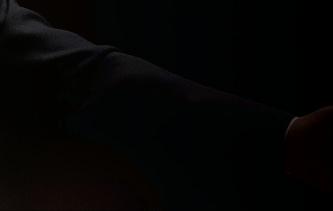










MARCH 31, 2022 - CHICAGO READER 43 APRIL 23 MAY 7 CSO FOR KIDS Once Upon a Symphony: Jack and the Beanstalk Muti Conducts Mazzoli & Mahler with Elīna Garanča SYMPHONY CENTER | 220 S. MICHIGAN AVE. CSO.ORG | 312-294-3000 Artists, prices and programs subject to change. APRIL 2 APRIL 8 APRIL 10 APRIL 20 APRIL 14 –15 MAR 31–APR 5 SPECIAL JAZZ PIANO JAZZ CSO CSO Symphony Ball with Muti & Garanča Dianne Reeves Yuja Wang Redman, Mehldau, McBride, Blade: A MoodSwing Reunion The Firebird Proof of vaccination and photo ID may be required for entry. Visit cso.org/SafeAndSound for details. APRIL 1 CHAMBER Hilary Hahn Muti Conducts Montgomery & Beethoven Pastoral Muti, Andsnes & Bri en Piano Concerto Official Airline of the CSO Maestro Residency Presenter Media Partner These programs are partially supported by a grant from the Illinois Arts Council Agency. Muti Conducts Montgomery & Beethoven Pastoral performances generously sponsored by Mr. and Mrs. Dietrich M. Gross. APRIL 7–12 Riccardo Muti conductor Leif Ove Andsnes piano APRIL 28 – MAY 3 Riccardo Muti conductor Alexander Hanna bass Perfect for kids ages 3–5!
SPRING THEATER & ARTS PREVIEW
DANCING ABOUT ARCHITECTURE
Hedwig Dances returns with FieldTheory
Brutalism and Bauhaus inspire two new pieces.
By NORA PAUL
On an architectural tour last year, Rigoberto Saura settled into the concrete forms of the buildings overlooking the Chicago River. Wrapping around the water, tall brutalist buildings push into the skyline. It was on this tour that Saura heard the phrase “raw concrete.” The piece he created for Hedwig Dances as part of their April program uses that phrase for its title.
Saura began with Hedwig Dances in 2017 as a dancer, instructor, and choreographer. The company is currently in its 37th season under the direction of founder Jan Bartoszek. Hedwig Dances will be performing LightPlay, which Bartoszek created, and Saura’s Raw Concrete under the collective name Field Theory at Ruth Page Center for the Arts on April 8 and 9.
In 1985, Bartoszek directed annual concerts and outreach under the auspices of Urban Gateways, which she formalized to found Hedwig Dances. Bartoszek cultivates an interdisciplinary company, including visual components and original music. The dancers come from diverse cultural and movement backgrounds and are the main collaborators in the creation process of the company’s repertory. With Bartoszek and the choreographers’ guidance, dancers engage with the materials of the piece, such as objects and music, as points of access.
Explains Saura: “Hedwig has its own life there; you can come and touch it and feel like you are part of something . . . here we are equal together and we follow guidance, but we can speak freely and be creative and be
artists, which is sometimes more important than just having a body and dancing.”
This agency attracted Saura to Hedwig Dances. He was born and raised in Cuba. After attending the National University of the Arts in Havana, he was a soloist with Danza Contemporánea of Cuba. Flashes of his life on the island spark in moments in his works. Kaos (2020) was a video-synchronous hybrid piece that he directed virtually around the onset of the pandemic, fi ngering the pulse of that time. Saura references the situation Cuba has been in for years, which necessitates quick adaptation and solutions, ways to heat water or make food.
“I feel like at some point in all of my pieces you can feel that, like fast, you can’t breathe, and you’re overwhelmed, because I grew up in that situation sometimes, so I kind of unintentionally have been seeing that already.”
For Raw Concrete, Saura explains that in the brutalist style, all the architecture is easy to build but di cult to take down. That idea captivated him, and the a ective physicalities of this architectural construction formed the starting point of his research. The creation process with the four dancers, Saura recalls, reflects how “time is very brutal in the situation you see yourself sometimes . . . to experience the moment you’re living; it sometimes feels very heavy.” These principles translate to bodies carrying the weight of others; rigorous and flighty movements also hold a certain gravity.
Bartoszek similarly developed LightPlay from architectural principles. Following Futura (2018), the piece is Bartoszek’s second in a three-part series of works to be inspired by László Moholy-Nagy, who formed “The New Bauhaus,” presently the IIT Institute of Design in Chicago. LightPlay reflects Bartoszek’s interest in using objects.
“I found that I really like having to play with something as a part of the work because I feel like in doing so, I can create these metaphors between the human body and the object,” she explains. LightPlay is in the intersection between movement, light, and shadow. An overhead projector overlays the dancers as they move around the space, and walls skew their images. There is a live-feed birds-eye video camera, and screens lit from behind by a fl ashlight. The third piece, Meta-
mor-phos, will premiere September 2 and 4 at Bauhaus Dessau in Germany. The company will perform Meta-mor-phos in Chicago later in the year.
Maray Gutierrez Ramis, currently an artistic associate of Hedwig, and her husband Victor Alexander, who choreographs for the company, were the first Cuban dancers to join Hedwig. Like Saura, they were former dancers of Danza Contemporánea of Cuba. Other dancers from Cuba who knew Ramis and Alexander have since moved to Chicago and joined the company.
FIELD THEORY
Fri-Sat 4/8-4/9, 7: 30 PM, Ruth Page Center for the Arts, 1016 N. Dearborn, 312 291 8196, hedwigdances.com, $20 $ 45
Over the years, Hedwig’s cohort has included dancers from Taiwan, Australia, Mongolia, Japan, and the Philippines, “but for the past 20 years there has been a very strong Cuban connection,” says Bartoszek. “Initially, I knew the dancers but didn’t know their history in Cuba, so when it became possible to travel to Cuba, we decided to create a dance tour.” Ramis, Alexander, and Hedwig Dances worked with Art Encounter, a nonprofit travel organization, and Copperbridge Foundation, a nonprofit arts organization in Miami.
Hedwig developed a partnership with Danza Abierta, which is now called Mi Compania, through recurring patron visits to Cuba beginning in 2012. Bartoszek and Danza Abierta’s artistic director, Susana Pous, formed a lasting connection that has culminated in collaborative performances in both Cuba and the U.S., including the evening-length piece Trade Winds (2014). Hedwig dancers traveled between Chicago and Cuba to rehearse. The piece premiered in October of 2014 at the Dance Center at Columbia College, and in January of 2015 at the Teatro Nacional de Cuba Sala Avellaneda (National Theatre of Cuba).
The ensemble for Field Theory (Jacob Buerger, Holly Lehnertz, Hannah Marcus, Hanna Swartz, Richard Echevarria, Jessie Gutierrez, and Saura) allows Bartoszek to continue the company’s focus on perspectives of “dancers from di erent backgrounds with di erent experiences,” Bartoszek says, which in turn “adds to the physical conversation that we have. All of those perspectives add to the wholeness of the work.” v
 @noraapaul
@noraapaul
44 CHICAGO READER - MARCH 31, 2022 ll
Hedwig Dances presents LightPlay as part of Field Theory in April. VIN REED





























































































































































































































































































































































































































































































MARCH 31, 2022 - CHICAGO READER 45 Selec t E ssentia Introducing Your favorite strains. Our quality oil. Available at your local dispensary: ials Early Warnings See which artists are coming to Chicago with this essential music calendar of forthcoming shows and concerts—inboxed every Tuesday. KIRK WILLIAMSON chicagoreader.com/newsletters
SPRING THEATER & ARTS PREVIEW
FILM SCREENINGS
Enjoy Ukrainian and Asian American cinema at the Film Center
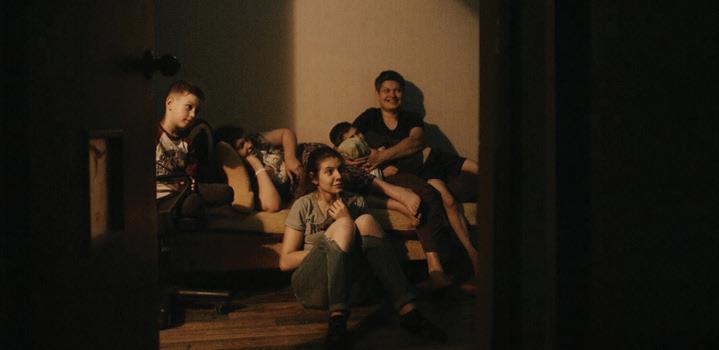
Gene Siskel will screen a wealth of international films this April.
By KATHLEEN SACHS
This spring the Gene Siskel Film Center presents two series of fi lms exploring countries and cultures that are often neglected in popular media. The Ukrainian Cinema series is timely for obvious reasons; through five fi lms, the Film Center endeavors to shed light on the Ukrainian experience, both past and present. Screening through April 7, the series illuminates the role of cinema not only in relating information but in appreciating the lives of others by way of art.
No fi lm embodies these e orts more than Dziga Vertov’s 1929 silent documentary Man with a Movie Camera . Just a little over an hour, it nevertheless towers over fi lm history as an example par excellence of cinema’s ability to communicate in unique and transgressive ways. Though he was born in Poland— then part of imperial Russia—Vertov (whose real name was David Kaufman; the alias he assumed translates approximately to “spinning top” in Ukrainian) made his landmark opus for a Ukrainian fi lm studio and fi lmed it largely in Kyiv and Odessa. It centers on the titular figure, who wanders around filming
the stuff of life, which is made even more sublime by the frenetic and revolutionary editing of Yelizaveta Svilova, also Vertov’s wife.
On April 7, the Chicago Film Society will co-present Mikhail Kaufman’s recently rediscovered silent fi lm In Spring (1929) on 35-millimeter and with live piano accompaniment by David Drazin. Kaufman was Vertov’s brother and the cinematographer of Man with a Movie Camera ; this later fi lm was made after a disagreement between the two. Using spring as its grounding metaphor, Kaufman fi lms life in Kyiv with an eye toward the cycle of sometimes elegiac, sometimes brutal regeneration.
In a roughly translated interview, Kaufman presciently exclaimed about the fi lm and the transformative season that inspired it, the one into which this current struggle will be waged: “By all available means of expression, I tried to convey a violent turning point in nature, spring, sung by many generations of poets in lyrical terms. I did not want to idealize it, because destructive processes also take place in the spring. But man turns out to be stronger than poetry, he can prevent her
UKRAINIAN CINEMA SERIES
Through April 7
ASIAN AMERICAN SHOWCASE
April 1-13
Gene Siskel Film Center, 164 N. State; Film Center members $ 6 per film, general admission $12 per film. siskelfilmcenter.org
whims and correct destruction.”
Two contemporary documentaries, Sergei Loznitsa’s Maidan (2014) and Iryna Tsilyk’s The Earth Is Blue as an Orange (2020), explore recent confl icts in Ukraine. Loznitsa’s staggering testimony bears witness to the Euromaidan protests of late 2013 and early 2014, which resulted in the ousting of then-president Viktor Yanukovych, whose reluctance to sign into an association with the European Union was viewed by dissidents as pro-Russian sentiment. Where Vertov and Kaufman deployed frenetic shooting and editing styles in their depictions of Ukrainian life, Loznitsa opts for long, static wide shots that wholly embody the gradations of the confl ict at hand.
As Vertov sought to create “an authentically international absolute language of cinema,” per the introductory title cards of his city symphony (which makes a cameo in Tsilyk’s film), the resilient family in The Earth Is Blue as an Orange likewise turn to fi lm as a means of representation—and also catharsis. Centering on a young girl who aspires to be a cinematographer, the documentary follows her, her single mother, and three siblings as they make a short fi lm about their experiences during the onset of the war in Donbas following the Revolution of Dignity at the end of the Euromaidan protests in 2014. The melding of Tsilyk’s documentary with her subjects’ film is a generous approach, granting the family co-author status along with the director.
Also playing in the series is Valentyn Vasyanovych’s 2020 film Atlantis , a Stalker-esque speculation on a post-war Ukraine in the not-so-distant future. Naturally the fi lm has emerged as one to watch during the present-day turbulence; such timeliness is eclipsed only by its visual splendor, further reflecting the ability of art to transmit by way of form in addition to content.
In partnership with the Foundation for Asian American Independent Media (FAAIM), the annual Asian American Showcase returns to the big screen with several films from the past two years about Asian American characters and subjects. The showcase takes place between April 1 and 13, with several filmmakers in attendance. Julie Ha and Euguene Yi’s Free Chol Soo Lee (2022) opens the series; the documentary details the plight of the Korean immigrant who, in
1973, was wrongfully convicted of murder in part because white tourists were unable to distinguish one Asian person’s features from another.
Kate Tsang’s Marvelous and the Black Hole (2021) is a charming coming-of-age story in which the troubled young protagonist, Sammy (Miya Cech, one to watch), copes with her mother’s death through magic after forging a heartwarming relationship with an older magician (Rhea Perlman). Brimming with imagination and unafraid of darker themes related to adolescence and death, this is the kind of fi lm cool parents might consider bringing their teenagers to, though it’s perfectly enjoyable for adults as well.
That might not be the case with Debbie Lum’s documentary Try Harder! (2021), which may trigger fl ashbacks to high school and the grueling college admissions process. Set at a top-ranked public high school in San Francisco, the film explores such issues as the stress put on students during said process and the intersectionality of how this affects kids from different backgrounds, including the children of immigrants, for whom achievement is often a measure of their family’s success in a new country.
The Kartemquin-produced breakout hit Finding Yingying (2020) is a fresh but still heartbreaking take on the true-crime documentary format, as director Jiayan “Jenny” Shi (who will be in attendance at the screening) had a somewhat personal connection to the crime it documents, the brutal 2017 murder of Chinese scholar Yingying Zhang at the University of Illinois at Urbana–Champaign. Shi also includes snippets from Yingying’s diaries, which serve to construct her as a person rather than just a victim.
Also screening in the showcase are a collection of short films as part of a program called “Asian American Shorts: Resilience”; Ann Kaneko’s 2021 documentary Manzanar, Diverted: When Water Becomes Dust, which explores the role of Japanese American women along with other cultural and activist groups in defending the water supply on California’s Indigenous land; Chris Chan Lee’s Silent River (2021), a slow-burn sci-fi trading in questions of being and identity; Patricio Ginelsa’s Lumpia with a Vengeance (2020), the sequel to the 2003 fi lm Lumpia, a cult classic among the Filipino American community; and the closing night fi lm, Tom Huang’s Dealing with Dad (2022), about adult siblings who return home to contend with their depressed father. v
46 CHICAGO READER - MARCH 31, 2022 ll
The Earth Is Blue as an Orange ALBATRÓS COMMUNICÓS
April 21-May 1
Landmark’s Century Centre Cinema, ChiTown Movies drive-in, Instituto Cervantes; $10 -$100. chicagolatinofilmfestival.org
SPRING THEATER & ARTS PREVIEW
any other sport, boxing confronts aspects of the athletes’ heritage, here focusing on the contentious dynamic between the Los Angeles-born De La Hoya and the Mexican-born Chávez as it relates to their respective backgrounds.
In Federico Adorno’s Boreal (2021), three men are tasked with building their boss a fence in a remote location in the Paraguayan Chaco, where they’re left for weeks at a time with little information, a situation that recalls Samuel Beckett’s Waiting for Godot. Celina Escher’s 2021 documentary Fly So Far also covers a long period of time without resolution; the fi lm is about a Salvadoran woman named Teodora Vásquez who served nine years of a 30-year sentence for murder after her baby was stillborn.
Too many incredible Latino films for one eager critic
By KATHLEEN SACHS
The Chicago Latino Film Festival poses a problem—a good problem, but a problem nevertheless. There are simply too many interesting programs to see, and as any cinephile is loath to admit, we’re but singular bodies unable to be in more than one place at the same time.
This year’s edition presents the same dilemma, but, as a holdover from deep pandemic years, select fi lms will be available to rent and stream online, thus allowing for some flexibility. (Note that the virtual options are available to view in blocks: from April 22 to 26; from April 27 to May 1; and from April 30 to May 1.)
In-person screenings will take place at
three venues: Landmark’s Century Centre Cinema, the ChiTown Movies drive-in, and Instituto Cervantes downtown. The opening night event, a drive-in screening of Panamanian director Abner Benaim’s Plaza Catedral (2021), screens at ChiTown Movies on Thursday, April 21 at 7:30 PM. In the fi lm, a wellto-do real estate agent whose young son was killed in a freak accident begins looking after a young boy from the streets.
French illustrator Aurel brings to life the story of Catalan cartoonist Josep Bartolí in the animated fi lm Josep (2020), which spans the artist’s internment in a concentration camp during the Spanish Civil War and his several-year love affair with artist Frida Kahlo. Most feature presentations include an

accompanying short fi lm; with Josep screens Chilean fi lmmakers Cristóbal León and Joaquín Cociña’s The Bones , purporting to be a 1901 silent fi lm “rediscovered” in the year 2023. This eerie black-and-white stop-motion animation fi nds a young woman evoking the spirits of two figures from Chilean history (one of whom the real-life girl was in a relationship with at the age of 15) instrumental in originating and, later, revising the country’s constitution.
Desperate Housewives star Eva Longoria Bastón takes on the compelling fight, both in and out of the ring, between boxing superstars Oscar De La Hoya and Julio César Chávez in La Guerra Civil (2022). The documentary makes the case that, more than
Internalized misogyny can be monstrous, as reflected in Brazilian writer-director Anita Rocha da Silveira’s Medusa (2021), wherein groups of pious young women attack other women whom they deem to be promiscuous or otherwise sinful. One of the attackers changes her tune when she’s targeted herself, discovering the power inherent to those characteristics she once derided. Hallucinatory visuals reminiscent of Dario Argento (whom Rocha da Silveira has cited as an influence) meet plot mechanics similar to those in Carrie, with musical elements also thrown into the mix, resulting in a transgressive blend that targets outdated mores.
Cinephiles will especially enjoy Javier Espada’s documentary Buñuel, a Surrealist Filmmaker (2021), which is one of the special screenings taking place at the Instituto Cervantes. The closing night film, Chilean director Francisca Alegría’s The Cow Who Sang a Song into the Future, which screens at the ChiTown Movies drive-in, is not surrealistic so much as it is magical realist in its consideration of ecological issues vis-à-vis its central narrative focused on a dysfunctional family.
Above are but a smattering of the films available to watch in person or virtually at the Chicago Latino Film Festival; in addition to the obvious ones, categories delineated by the festival include animation, experimental, fantasy, horror, LGBTQ+, musicals, sci-fi , and thrillers. Check the festival website (chicago latinofi lmfestival.org) for more information about what’s playing, how and where to view the fi lms, and ticketing. v
MARCH 31, 2022 - CHICAGO READER 47
Josep LES FILMS D’ICI MÉDITERRANÉE
FILM FESTIVAL
The hybrid 38th iteration of the Chicago Latino Film Festival will take place April 21-May 1.
CHICAGO LATINO FILM FESTIVAL
THEATER
Elise Malary
At every opportunity, Elise urged allies to welcome her Trans community, and most importantly, commit to #HireTransNow. #HireTransNow is the initiative Elise championed at CTC that supports organizations in recruiting Trans job candidates and implementing Transaffirming hiring, onboarding, and accountability practices.
Honor Elise and the work she cared so deeply about. Embrace her call to action. Sign your workplace onto #HireTransNow today.
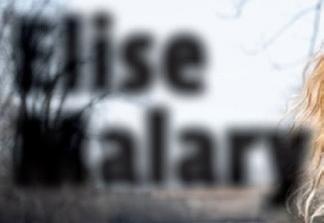
Elise recruited over 50 employers to #HireTransNow and inspired many hiring managers to want to employ Black Trans workers.
Elise’s passion about employment was rooted in her belief that economic justice is essential for Trans liberation. She saw safe, affirming, and well-paying jobs as the most pragmatic path towards uplifting her Trans sisters and ensuring the Trans community has access to healthcare, safe housing, and life beyond survival.
We often don’t consider someone’s legacy until they are gone. While we mourn, Elise’s presence, passion for economic justice, and nack for calling in allies and embodying our collective’s FUBUWY (For Us By Us With You) principle will continue to inspire those of us she has left behind.
Chicago Therapy Collective promotes city-wide accountability and action to alleviate LGBTQIA2S+ mental health disparities. Its members facilitate personal healing and cultural transformation through education, therapy, advocacy, and the arts.




OPENING

Laced has echoes of Stonewall and Pulse
But About Face’s world premiere is light on plot.
Sam Mueller’s Laced lives in the shadow of the Pulse nightclub mass shooting, but it is rooted in a club that preceded Pulse by several generations: Stonewall. Through Mueller’s monologue-dependent script, About Face Theatre creates a contemporary story that also gives voice to the history that helped forge it. In director Lexi Saunders’s raw, emotive production, Audra (Mariah Copeland), Minnow (Daniela Martinez), and Cat (Collin Quinn Rice) work at Maggie’s, a Florida nightclub that’s a celebrated safe space for its queer clientele. The story unfolds in the wake of the June 12, 2016, shootings at Orlando’s Pulse nightclub, where 49 people were killed and another 53 injured in the second-deadliest mass shooting in U.S. history. (The first is the 2017 Las Vegas Mandalay Bay massacre.)
A er Maggie’s is vandalized—scrawls of hate speech sprayed on the walls, broken glass and debris littering the floor—the tight-knit trio recalls the previous night’s revelries in minute detail, hoping they’ll remember something that could shed light on who vandalized their club.
Mueller’s script pacing slows when it needn’t, thanks to a few unnecessarily repetitive silent scenes that punctuate the flashbacks. But the sense of sacred community that defines Maggie’s is never in doubt, from a midnight crush that has the bartenders moving in tandem like a single, efficient organism to the salute to Marsha P.

Johnson and Sylvia Rivera (each given the ultimate reverence in that they’re mentioned only by first name, the assumption being these women are as familiar to everyone as Cher or Jesus).
The structure allows each character to reflect in depth on their own personal terrors and triumphs, making Laced feel like a confessional. There’s not a lot of plot here, but Saunders’s earnest cast captures raw vulnerability and exhausted, angry resilience in equal measure.
—CATEY SULLIVAN LACED Through 4/17: Thu-Sat 7:30 PM, Sun 3 PM; Den Theatre, 1331 N. Milwaukee, 773-697-3830, aboutfacetheatre.com, $5-$35.
R Space Mystery
Otherworld’s Murder on Horizon is an interactive whodunit.
In Otherworld Theatre Company’s Murder on Horizon: An Immersive Sci-Fi Noir, the cast and crew have devised an immaculate hyperspace straight out of a video game. The story begins when audiences step inside the theater, and the ensemble welcomes them into a new world. They’ve been transported onto the space station Horizon, situated in a distant future where humans are technologically modified to reach peak performance. A er interacting with several fantastical inhabitants, they find they’re part of Detective Symin Stone’s (Michael Darmon) investigative team, who have been called to Horizon to solve the murder of cutting-edge scientist Val Tramel (Taylor Fryza).
The attention to detail behind each element of the Horizon universe is superb. The ensemble, under the direction of Otherworld artistic director Tiffany
48 CHICAGO READER - MARCH 31, 2022 ll
We continue to mourn the loss of our Board Vice President,
Elise was kind, joyous, and tenacious. She spoke with intention and directness. Her ask of her northside community was clear:
“I’m going to keep it 100%, we need our white, cisgender allies to step up.”
Keane Schaefer, has created fully realized characters and does an excellent job of displaying their desires, eccentricities, and relationship to the case at each point of the show. The story is well-paced as the detective leads the team through the space station’s bar, lab, and greenhouse that look like they were pulled from a science fiction film. Each space serves the plot well and enhances the suspect’s interests as the detective completes interviews with each one. Since the characters’ placement in the world feels authentic, and the mission remains clear, the stakes feel high, and the audience involvement feels meaningful.
invoking Hillbilly Elegy stereotypes. And though the conclusion feels abrupt and not wholly earned, the pain and struggle of both sisters comes through with sharp poignancy in this well-acted production. —KERRY REID SPAY Through 4/17: Thu-Fri 8 PM, Sat 4 and 8 PM; also Wed 4/6 and 4/13, 8 PM and Sun 4/3 and 4/17, 3 PM; Sat 4/9 and 4/16, 4 PM only; Rivendell Theatre, 5779 N. Clark, 773-334-7728, rivendelltheatre.org, $35 ($15 students, educators, military, industry; $25 seniors and neighbors). Postshow town halls 4/9 and 4/16, 4 PM.
RSweat, tears, and blood
Paramount opens its new Copley Theatre with a stellar revival.
—KATIE POWERS
Each performance is limited to only eight audience members, who are up and working for nearly the entire 90-minute runtime. Everyone has the opportunity to play an active role in the story if they choose. A willingness to embrace the intrigue and jump into the action certainly levels up the experience.
MURDER ON HORIZON: AN IMMERSIVE SCI-FI NOIR

Through 5/1: Thu 7 PM, Fri 7 and 9:30 PM, Sat 5, 7:30, and 10 PM, Sun 2 PM; Otherworld Theatre, 3914 N. Clark, otherworldtheatre.org, $50 adult, $24 children up to 16.
R West Virginia woes
The opioid epidemic comes into focus in Rivendell’s Spay
Williamson, West Virginia, is in the heart of Hatfield-McCoy history, but the conflict driving apart a family in Madison Fiedler’s Spay, now in a world premiere at Rivendell under Georgette Verdin’s direction, is rooted in opioids, not moonshine. Kindergarten teacher Harper (Krystel McNeil) has just brought home her half-sister Noah (Rae Gray) from the hospital, where she nearly died a er OD’ing at a school baseball game. Harper is also the guardian of Noah’s son, and if Noah ever wants to spend time with her kid again, she’s going to have to clean up her act. Not easy when boyfriend Jackson (Spencer Huffman) is also her dealer (but he promises he gets her the “clean” stuff ). And when your town is nicknamed “Pilliamson.”
Enter Aubrey (Tara Mallen), a stranger from “Project Protection” who promises “resources” to help the family. But as the title suggests, that help comes with a very large condition about Noah’s future fertility.
Staged on a comfortably cluttered and intimate set designed by Lindsay Mummert, Fiedler’s play largely succeeds at creating a framework for two women’s domestic conflicts arising from a larger national problem (their mother became addicted and OD’d a er a car accident) that nobody seems to know how to address successfully. This makes it a little easier to believe that Mallen’s Aubrey and her offer could find a toehold in Harper’s house. Fiedler’s script and Verdin’s cast avoid
Lynn Nottage’s gripping drama Sweat launches a new direction for Aurora’s Paramount Theater, a 1,000-plus seat, 87-year-old Versailles-on-acid space known for award-winning musicals. Directed by Andrea J. Dymond, Sweat is the first production in the new Copley Theatre, a minimalist steel-and-glass black box across the street from the larger venue. Dymond’s airtight ensemble makes the most of the gleaming new space, delivering an all-too-familiar look at the violent intersection of racism and recession.





Set in Reading, Pennsylvania, between 2000 and 2008, Sweat lets you know up front that something terrible has happened in the bar where most of the action takes place. Flitting between years, each scene provides a piece in a tantalizing puzzle eventually ruptured by violence. Nottage’s white, working-class characters provide vivid, eerily specific foreshadowing of the MAGA/white supremacist movement exponentially emboldened under the 45th president.
The plot hinges on the factory where generations of white families have found security, certain that their loyalty would mean a solid income and, eventually, a comfortable retirement. As that security vanishes, the ramifications play out with visceral brutality. The ensemble delivers a long, slow burn that ultimately explodes in David Woolley’s bone-crunching fight choreography. Keep an eye on Jordan Anthony Arredondo as Oscar, a barback who the garrulous regulars ignore, vilify, and ultimately have to reckon with. Linda Gillum is terrifying as Tracey, a worker ripe for far-right radicalization. And in Shariba Rivers’s upwardly mobile Cynthia, Nottage shows how something good—like a promotion—can make a Black woman a target for everybody else who wanted the job (and even those who didn’t).
—CATEY SULLIVAN SWEAT Through 4/24: Wed 1:30 and 7 PM, Thu 7 PM, Fri 8 PM, Sat 2 and 8 PM, Sun 1 and 5:30 PM; Copley Theatre, 8 E. Galena, Aurora, 630-8966666, paramountaurora.com, $67-$74. v


MARCH 31, 2022 - CHICAGO READER 49 THEATER CHICAGO SHAKESPEARE THEATER BEGINS APRIL 22 “ The web of our life is of a mingled yarn, good and ill together ” written by WILLIAM SHAKESPEARE directed by SHANA COOPER TICKETS START AT $ 35 THROUGH MAY 13 Ray and Judy McCaskey LEAD PRODUCTION SPONSOR Lindy and Mike Keiser e Jentes Family e Kenneth C. Gri n Charitable Fund Rita and John Canning Anna and Robert Livingston Carl and Marilynn oma Donna VanEekeren Timothy R. Schwertfeger and Gail Waller e Harold and Mimi Steinberg Charitable Trust Peter and Alicia Pond Burton X. and Sheli Z. Rosenberg MAJOR SEASON SUPPORTERS
Sweat LIZ LAUREN
Find new film reviews every week at chicagoreader.com/movies
who judge him for not fitting in, and Margaret from the ghosts of her past. And in the process, they run toward each other.
NOW PLAYING
RAhed’s Knee
When Israeli filmmaker Nadav Lapid’s proxy, the veteran director Y (Avshalom Pollak), lands in the Aravah desert for a celebration of his career at a remote public library, he’s flush with the anxieties of a censorship battle over a planned biopic on the Palestinian activist Ahed Tamimi, but everything appears under control. It can’t stay that way. The sparseness of these hinterlands registers sonically in the staccato crunch of Y’s shoe soles on tarmac and sand, while Lapid’s trademark close-up work, in the chippy guerilla style of his 2019 Synonyms, makes the whole outdoors claustrophobic. It doesn’t take long for tensions in Y’s position, alongside the reckoning with Israeli state violence that undergirds his whole career, to chain-react.
The sparse crackle of the desert acts like kindling for the movie’s explosive reckonings; Y’s life, as he narrates it to his young librarian liaison Yahalom (Nur Fibak), charts a mounting howl of reckoning over decades of unwashed blood, culminating in a several-minute screed of monologue that is Lapid’s harshest statement yet on the contradictions within his art and the history of his nation. The chagrin of having to go through with Y’s quaint library event once all that fire and fury have hit the screen gives the tail end of the film a delightful bathos. If anything, the story might have gone on longer, as the Tamimi project never entirely takes shape and the powerful forces let loose in Y’s desert epiphany fizzle out by the end credits. But maybe that is simply the desert swallowing all human projects whole. —MAX MALLER 109 min. Gene Siskel Film Center
R The Automat
As a woman of a certain age, I have the great fortune of actually remembering the Automat restaurants, the marvelously entertaining subject of what Mel Brooks has deemed a “meshugganah documentary.” In Lisa Hurwitz’s charming, informative film, the era of the Automat gleams anew, as everyone from Colin Powell to Ruth Bader Ginsburg to Brooks recall their appeal.
For the uninitiated: Walking into an Automat was like walking into a vast, art-deco bank vault, all high ceilings, gleaming bronze, and pewter. Instead of safety-deposit boxes, there were windowed compartments of coconut cream pie, meat loaf, mac and cheese, and chocolate cake, among hundreds of other selections. You’d plug a nickel (or two) into the slot of your choice, remove your food, and join any of the dozens of tables where hundreds of people—from society matrons in furs to down-and-out panhandlers—dined communally.
The Automats have all long since been converted into fast-food joints, but for the first half of the 20th century, they provided good, cheap food to millions—plus five-cent cups of coffee dispensed from the bronzed mouth of spouts shaped like dolphins. Hurwitz tells the story of the Horn & Hardart establishments with wit, panache, and plenty of historical context, using roughly 90 years’ worth of archival footage to illustrate the narrative, which moves from the 1900s through 1991, when the last Automat became a Burger King. Interviewing celebs, laypeople, and Automat scholars (yes, they exist), Hurwitz shows how the restaurants thrived via technology that was a harbinger of cupcake ATMs and fast food. At their peak, the Automat was a brand as familiar to Americans as McDonald’s would eventually
become. And as Brooks explains, the coconut cream pie was both delicious and terrific for smashing into someone’s face. —CATEY SULLIVAN 79 min. AMC Theatres, Landmark Theatres
The Contractor
In Tarik Saleh’s The Contractor, Special Forces operator James Harper (Chris Pine) is forced out of the military when a change in command prevents him from utilizing his less-than-aboveboard medicinal treatments to rehab his lingering injuries. Faced with a loss of income, pension, and benefits, James signs up with a private mercenary group that claims to be in it for more than just money. Right out of the gate the first mission goes horrifically wrong, and James is forced to go on the run to protect his family and try to discover the true motivations of his new employers.
Saleh’s film neither goes above nor beyond in attempting to skirt the line between social message drama and man-with-a-unique-set-of-skills flick. There are some genuinely interesting issues at play in the treatment of veterans of America’s foreign conflicts, and the loneliness of those whose success in conflict doesn’t replicate to life at home, but sadly it largely shunts those aside to create a standard action plot. Family and greed are the two motivating factors character-wise, but only in their most basic senses, as the film stumbles on without investigating with any degree of nuance what leads to or develops from the sacrifices that we make regarding both. Saleh’s directorial decisions are both narratively simplistic yet overcomplicated, leaving little time for characters to develop in any interesting way. On a technical level the choreography of the action sequences is muddled by some bizarre editing choices and lackluster cinematography.
In a crowded field of lone-man operators-againstthe-world action films, The Contractor doesn’t do anything well enough to finish the job. —ADAM MULLINS-KHATIB R, 103 min. AMC Theatres
R Jump, Darling
Humiliation and heartbreak send aspiring drag queen Russell (“Fishy Falters”) to the country, where he finds his grandmother, Margaret, in rapid decline. The two soon develop a renewed bond and an alliance against those who aim to separate them, namely Russell’s busybody mother; she’s suspicious of her son’s intentions and hopes to transition Margaret into hospice care. Both members of this unlikely intergenerational duo are running from something—Russell from those
Refreshingly, Phil Connell’s Jump, Darling breaks from many of the tropes we’ve come to expect from queer storylines. There are no tearful comings-out, no humiliating confessions, no crimes of hate or passion. Russell keeps his love for drag a secret not because he fears retribution, but because he’s been told, like so many creatives before him, that his passion would never develop into a “real” career, and that he would be better off investing in a more stable option (which, in his case, is acting). “I need to [be able to] respect him,” our protagonist’s ex-boyfriend disparages, referring to what he calls Russell’s “gay variety show shit.”
While Russell struggles to realize his dream, Margaret struggles to remember hers. Her memory, oscillating between debilitatingly foggy and touchingly lucid, creates a thoughtful depiction of dementia—it reminds this reviewer how powerful the stories we tell ourselves can be, even when we have nothing le but those same stories.
The late great Cloris Leachman and newcomer Thomas Duplessie shine as the leads in this story of intergenerational trauma, belonging, and transformation. —BROOKS EISENBISE 90 min. Wide release on VOD
Mothering Sunday
In her review of Graham Swi ’s 2016 novel Mothering Sunday, New York Times critic Michiko Kakutani wrote that it felt less “self-consciously literary” than the writer’s previous novels; conversely, the film adaptation—written by Alice Birch (Lady Macbeth, Hulu’s Normal People) and directed by French filmmaker Eva Husson (Girls of the Sun)—feels cinematically mannered, trading in devices that seem designed to elicit wonder. Set on the titular UK holiday, the story revolves around Jane (Odessa Young), an orphaned maid who’s been embroiled in a lengthy affair with the son (Josh O’Connor) of an affluent family. The narrative covers two tragic developments that take place decades apart, resulting in Jane finding her voice as a writer. Lingering amid the a ermath of World War I, which claimed the lives of several sons between Jane’s employers and her lover’s family, and sporadically jumping to Jane’s later years with another paramour, the film attempts a grand statement about the human condition. These may have worked on the page, but onscreen they’re rendered too sentimentally to make a significant impact. There’s a Malickian quality to the film that’s cheesy at moments, and the disjointed chronology is more aggravating than affecting. British heavyweights Colin Firth and Olivia Colman star as Jane’s employers; they give solid performances, but their characters are infected with the same slight dreariness that permeates the film as a whole. —KATHLEEN SACHS R, 104 min. AMC Theatres, Landmark Theatres v
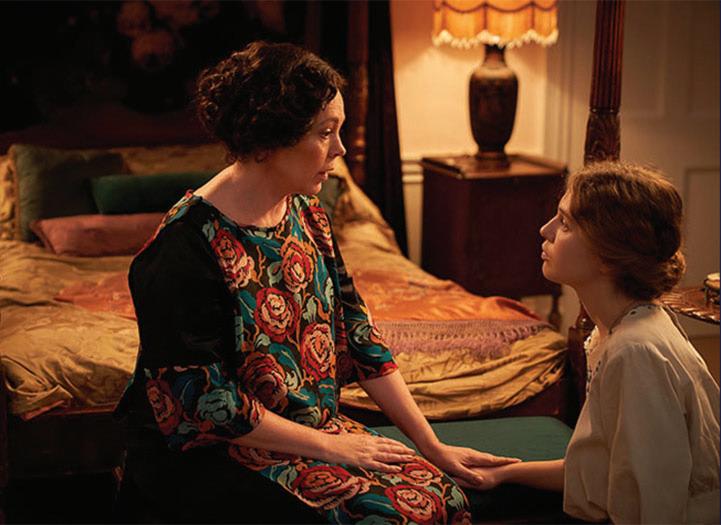
50 CHICAGO READER - MARCH 31, 2022 ll FILM
b ALL AGES N NEW F
R READER RECOMMENDED
Mothering Sunday SONY PICTURES


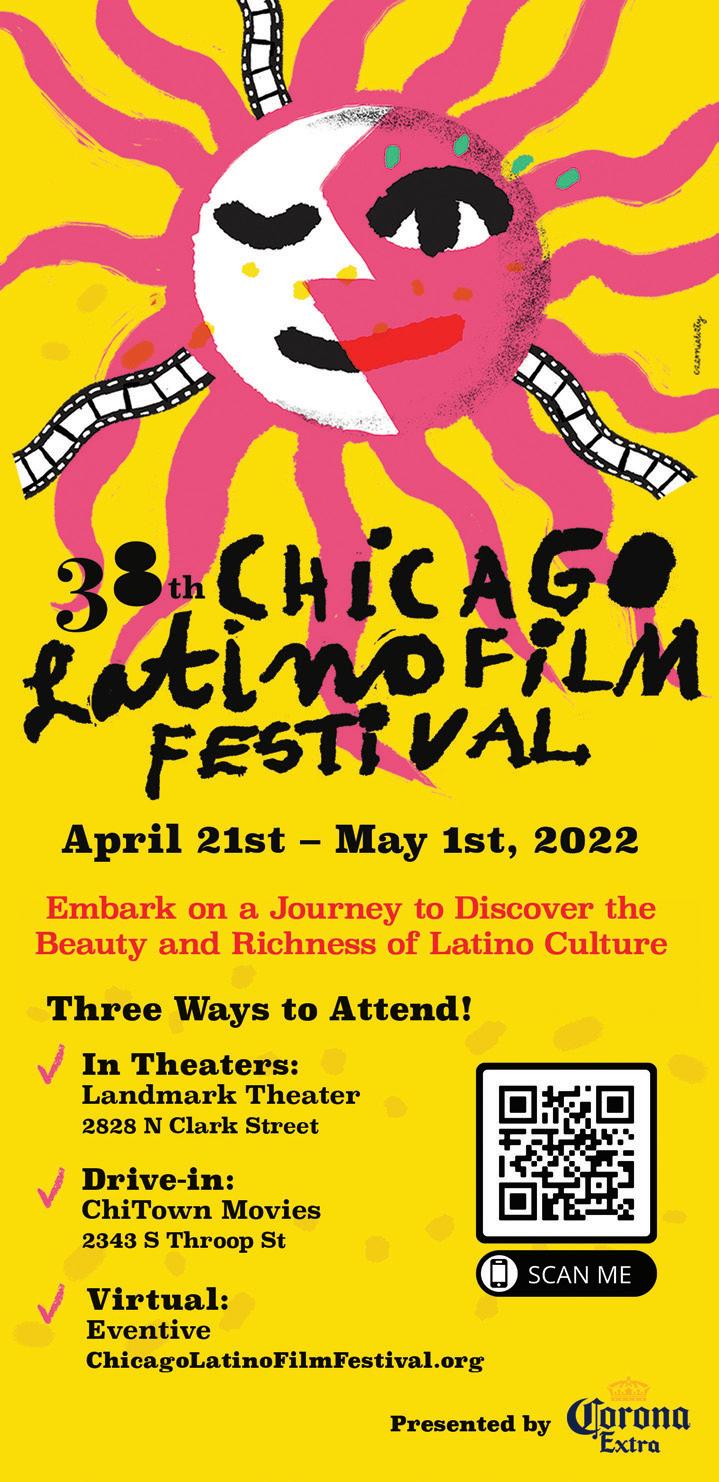










MARCH 31, 2022 - CHICAGO READER 51 164N.STATEST CHICAGO,IL60601 FromdirectorNadavLapid WE'LL SEEYOU ATTHE MOVIES! SISKELFILM CENTER.ORG Opens4/1 Opens4/8 FromdirectorAndreaArnold Never miss a show again. EARLY WARNINGS chicagoreader.com/early
A new retrospective brings Barbie Army back to the front lines
The Chicago garage rockers broke up in obscurity more than 30 years ago, but a German label is giving them a second chance at the audience they deserve.
By JEN B. LARSON
If it weren’t for YouTube algorithms, the music of Barbie Army might’ve vanished like dust in the wind. Like so many underground garage-rock bands, this Chicago group played live constantly but didn’t pay as much attention to releasing recordings—during their lifetime, from 1986 till 1991, they put out one self-titled, self-released seven-inch and a few DIY cassettes that they dubbed by hand to sell at gigs and by mail. Barbie Army could attract crowds, but they had a hard time building momentum. When they broke up, they were still undetected by the masses, even in Chicago.
Thankfully, the Internet has a way of remembering things for us. And because someone uploaded some of Barbie Army’s music to YouTube in the mid-2010s, Berlin-based label No Plan is releasing a collection of recordings made more than 30 years ago by a group nearly 5,000 miles away. Barbies Don’t Bleed: Retrospective 1986-1990, which the label says contains the band’s “whole discography,” comes out on April 1. In May, members of Barbie Army will reunite to celebrate the new record with a show at one of their old haunts, Phyllis’ Musical Inn.
Barbie Army recorded several of the songs
on Barbies Don’t Bleed at Jay’s Garage, run by musician and engineer Jay O’Rourke—the track “Ivan” appears on the 1988 compilation It Came From Jay’s Garage. They worked with engineer Lee Popa (now known as Lee Pope) for several sessions, including the 1990 date at Shadow Productions that produced the A side of their lone seven-inch. (They recorded the B side at Wicker Park studio Idful Music, then just a year or so old and not yet famous.) The two sides of that record showcase different members, though, which was a problem Barbie Army consistently faced: practically every time they put out new music, they had a di erent lineup.
This could make it di cult to sell and promote their releases. Maybe new members weren’t motivated to push a tape on which they hadn’t played; maybe the band had misgivings about selling fans a recording by a lineup that might not sound enough like the show they’d just heard. These factors also made them reluctant to send their work to critics, and Barbie Army didn’t pick up steam in the music press. They wrote fun material with impressive songcraft, and their musicianship was top-notch. But they were never more than a niche band.
In the early 90s, the likes of Liz Phair, Smashing Pumpkins, Urge Overkill, and Veruca Salt were just beginning to distinguish Chicago indie rock from radio drivel. They kicked o a brief period when independent-minded rock artists could reasonably aspire to earn a living in the city, or even get famous—but by then, Barbie Army had called it quits.
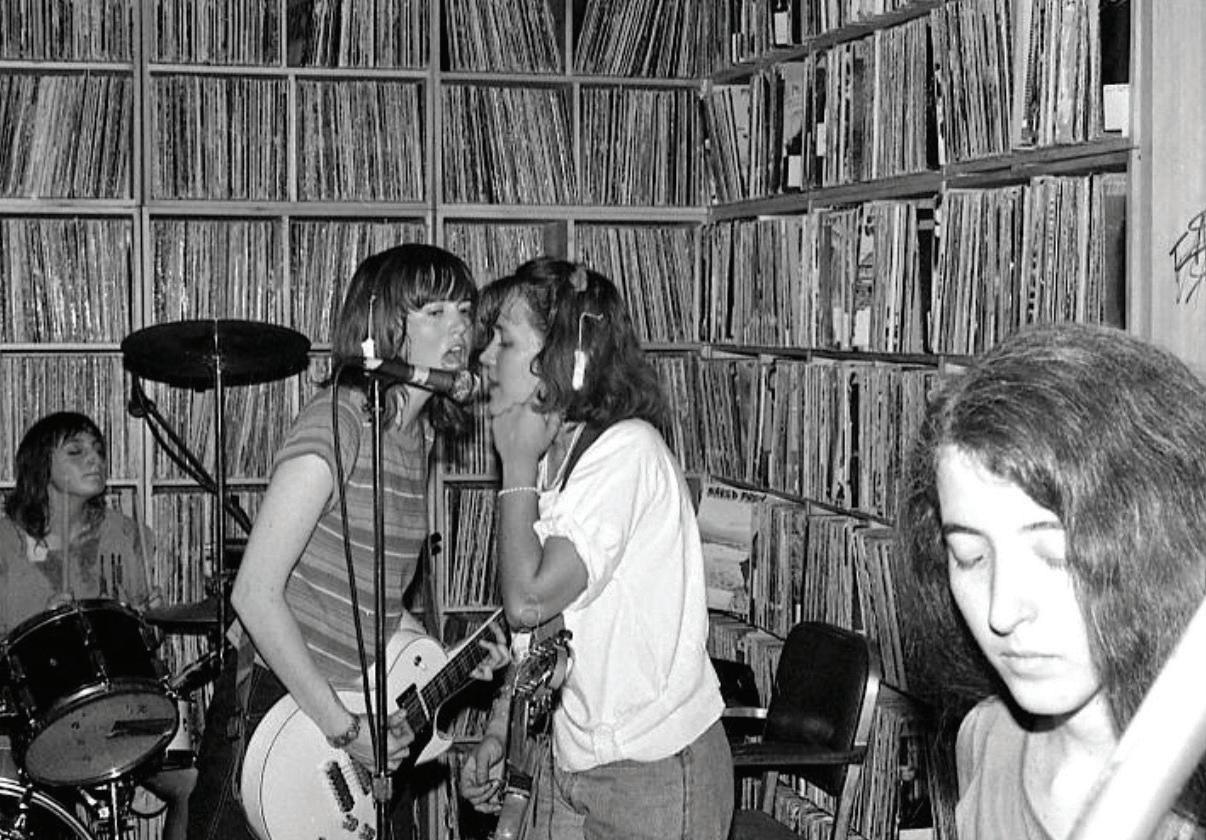
Idiscovered Barbie Army’s music on YouTube in 2017, when their song “Don’t Wait” appeared in my recommendations. It was hosted by the account of someone who went by ThirstyCraig, who I’ve since learned is a sort of anonymous Internet hero to lots of 80s Chicago punks. At that point, Barbie Army had no Web presence at all—they were a mystery to me.
ThirstyCraig had paired the audio with a black-and-white photo of three girls piled on top of one another, sassily rolling their tongues. At the time, I was grieving the breakup of my own garage-rock band Swimsuit Addition. I related to the Barbies, not just because they were a troupe of troublemaking women from Chicago, but also because we had similar styles—a penchant for poppy songs that flirted with chaos—and I felt connected to
their lyrics.
I couldn’t stop singing “Don’t Wait.” I couldn’t get its lyrics out of my head: “If you happen into Standard Liquors, won’t you buy me a bottle of wine? / That dream we shared is fading in the streetlight / And if you happen to think of me, won’t you please do it carefully? / You can’t throw something away that you never had, but you had me.”
BARBIE ARMY, BEASTII
Fri 5/20, 8:30 PM, Phyllis’ Musical Inn, 1800 W. Division, $12. 21+
Much later, when I’d started researching this story, I talked via Zoom with seven former members of Barbie Army and learned that “Don’t Wait” had been written by a friend of the band, a pig farmer and lawyer named Paul Anderson. Paul’s version was much slower and twangier. The Barbies changed a few lyrics (they added the line “You’ve been hanging ’round some pretty places with that girl from Highland Park,” for example), but they honored his vision in their rendition.
The Barbies describe Paul as a songwriting prodigy—they say he constructed great tunes
52 CHICAGO READER - MARCH 31, 2022 ll
Barbie Army play live on the air at WHPK in 1987. Their lineup at the time, from le to right, was Tina Matlock, Jean Lyons, Mary Dean, and Tanya Mushinsky. COURTESY JEAN LOTUS
with heartbreaking lyrics. That the band recognized the brilliance of “Don’t Wait” is important; part of what made Barbie Army so clever was their ear for good material. They covered a lot of songs by well-known artists too, including Billy Bragg’s “New England,” the Stooges’ “Raw Power,” and Jimi Hendrix’s “Fire.”
Over the past eight years, ThirstyCraig has uploaded several of Barbie Army’s songs. Other than tracking down copies of their cassettes or their seven-inch, which have become impossible to find, listening to his channel was the only way to hear the band’s music. As far as I know, it still is the only way—though that will change with the No Plan reissue.
“Craig’s been the keeper of a lot of the Chicago punk-rock scene,” says Barbie Army drummer Tina Matlock. “He squirreled it away for a while and started trickling it out into the universe of the Internet. Luckily for all of us, he did that.”
No Plan label owner Dario “Adam” Adamic also heard Barbie Army for the first time through ThirstyCraig’s channel, but at that point he’d already heard of them. In fact, he’d had their name in the back of his mind for 30 years: in 1990, a year after he moved from Croatia to Italy, he’d discovered a back issue of Maximum Rocknroll that included a 1987 interview with the band. He made a mental note of their name, but he didn’t encounter it again till he was browsing YouTube at the beginning of the pandemic. “I heard ‘Don’t Wait’ and I was blown away!” he says. “I couldn’t believe such a gem was hidden from me for all these years. So I dug more and more and I thought, ‘Wow! What a great band!’”
Adam wanted to do Barbie Army justice and bring their music out on vinyl. He found the band’s cofounders on Facebook and reached out, and luckily one of them responded. “If it wasn’t for [ThirstyCraig’s] channel, who knows if all this would be happening now,” he says. “Their music was just too good to only be a YouTube domain. These are all wonderful compositions, but they’re recorded in a very straightforward way. There’s no pretense, no high-end production, and that only makes it more relatable.”
Barbies Don’t Bleed is a retrospective of 19 Barbie Army songs, all originals, accompanied by an eight-page booklet. They wouldn’t all fit on an LP, so the release comes packaged with a bonus seven-inch.
In the early 80s, the two founding members of Barbie Army were still at Rocky Mountain High School in Fort Collins, Colorado, where they’d become friends. Jean Lyons
(now Lotus) and Mary Dean both had fathers working as professors at Colorado State University—Dan Lyons was in philosophy, and Mary’s dad, James Brinks, was in genetics and veterinary science. In 1982, they arrived together at the University of Chicago, where they’d declare as English majors.
At the U. of C., they joined a cover band called the Sugar Pops, playing bubblegum tunes such as the Archies’ “Sugar, Sugar,” the Hollies’ “Bus Stop,” and the Swingin’ Medallions’ “Double Shot (Of My Baby’s Love).”
“Mary and I have a long history of singing in the subway too,” Jean says.
After two years, Jean dropped out of school and moved to London with her guitar for six months (she’d lived in Canterbury for a stint during high school). She had a work permit for U.S. college students through BUNAC, and when it ran out, she moved back to Chicago and worked as a bike messenger. She’d eventually return to the U. of C. (and graduate in 1988), but before she did, she got involved in the local music scene. In 1985, she started playing in the band Fudgetunnel with her friends Starbuck Avon (then Judy Johnson) and Russ Forster.
Ron Richter, a future friend of Barbie Army, played in Sponge (not to be confused with the 90s Detroit band), who later joined forces with Fudgetunnel to form Spongetunnel. He remembers meeting Jean when his band was booked at the University of Chicago’s Festival of the Arts. “Two strolling minstrels with acoustic guitars approached us—Jean Lyons and Russ Forster,” he says. “We hit it o immediately.”
Jean and Mary, both of whom sang and played guitar, started Barbie Army in 1986 with Starbuck on bass. At the time Jean also edited a poetry magazine at the U. of C. called Vice Versa
One night, the magazine threw a party, and a contributor to Vice Versa named Lorri Jackson dragged her friend Tina Matlock along. (Lorri was already locally famous, and in 1990 she would publish the chapbook My Mouth Is a Hole in My Face shortly before her death from a heroin overdose.) The three Barbie Army bandmates, who’d heard Tina was a good drummer, saw their chance and pounced.
“[They] cornered me on the back steps and were like, ‘You’re gonna play in our band!’” Tina says. “I was 16 at the time. I was running in older-kid circles.”
Tina’s first influence had been a heavy metal band in her neighborhood. She began playing drums when she was 11, learning from another local metal drummer, who charged $5 per hour. Eventually, she convinced her mom
that she needed a kit of her own. “She found a way,” Tina says. “We were living in a basement apartment, and I set it up in the middle of the living room.”
As a teenager, Tina got kicked out of Notre Dame High School for Girls in Chicago. Soon after transferring to Schurz, a public school, she dropped out entirely and ran away from home. “I wandered the streets,” she says. She lived in flophouses all over the city, crashed rent-free above the bar and venue Batteries Not Included, and made friends with collegeage kids. If she knew someone had a drum kit, she’d knock on their door and ask if she could play it. “I was a homeless punk-rock kid,” she says. “I felt like the mascot, because I was a kid and there was some sort of novelty to that.”
In a way, Tina became Barbie Army’s mascot too. “I was taking a photography class, so I have a million black-and-white photos of Tina,” Mary says. “And she was so photogenic, she was on practically every poster we made.”
Barbie Army played poignant garage-rock ditties built from simple chord progressions and piled high with fuzzed-out guitar, hooky vocal harmonies, poppin’ bass lines, and righteous guitar solos. They lit Barbie doll heads on fire onstage. They opposed the tampon tax, calling themselves “tampon tax abolitionists.” They wore crowns of tampons and dangly tampon earrings and hung tampons from their instruments.
Once, before Jean and Mary formed Barbie Army, they attended the U. of C.’s notorious
Flyers for Barbie Army shows during the band’s initial run, including (at lower le ) the all-night cruise in summer 1987 with Rights of the Accused and No Empathy that’s detailed in a long reminiscence posted on their website late last year COURTESY
 JEAN LOTUS
JEAN LOTUS
MARCH 31, 2022 - CHICAGO READER 53
Lascivious Costume Ball wearing dresses made of tampon “chain mail,” while Mary’s boyfriend wore a tampon box as a hat. Another time, a guy came up to Jean because he thought she had a rabbit’s foot. “No, it’s a tampon,” she replied, and he instantly recoiled. “It was a man repeller,” she says.
The band had more going for them than activism and stunts, of course. “Jean’s songwriting in Fudgetunnel carried into the Barbie Army sound,” says Ron Richter. “Mary and Tina were also contributing songs.”
The members all had their own influences and styles, but they came together via their pop sensibilities. “We were always trying to write songs that were catchy,” Jean says. “I was always really into the Beatles and very influenced by Billy Bragg.”
“I grew up on a farm,” Mary says. “I had Melanie records. I liked Karen Carpenter and of course knew Helen Reddy songs. I was more like a country singer. When I was singing, writers would always say, ‘Tammy Wynette fronting the Runaways.’”
Tina often wore AC/DC and Iron Maiden T-shirts in band photos—she considered herself a metal kid until she listened to college radio and discovered punk rock. “It totally blew my baby brain into pieces,” she says.

In 1986 and 1987, Barbie Army were mainstays at north-side establishments such as Phyllis’ Musical Inn, Weeds, and Batteries Not Included. On the south side, they regularly played at the Mexican Patriotic Club. They did small tours of the midwest—Wisconsin and Indiana—and they took two short southern tours with their friends in Spongetunnel and Paul Anderson’s Gram Parsons tribute band, Burning Rain.
Barbie Army’s website, which went live in early December 2021, features a charming, sentimental band story by Jean, illustrated by her daughter Genevieve Lotus. It recounts two days in summer 1987 that at first felt like Barbie Army’s first shot at real success. At the time, they were doing pretty modest business: “We made our own tapes and advertised them in Maximum Rock and Roll,” Jean writes. “We sold about three tapes a month for $3 each via the U.S. mail.”
But it looked like that was about to change. Barbie Army were scheduled to play an allages overnight punk cruise with Chicago punk bands No Empathy and Rights of the Accused. At ten the next morning, they were booked at Navy Pier for an outdoor event called “Halfway to Saint Patrick’s Day.”
“I was 22 years old, and how could Barbie Army not be on the hinge of Chicago punk rock

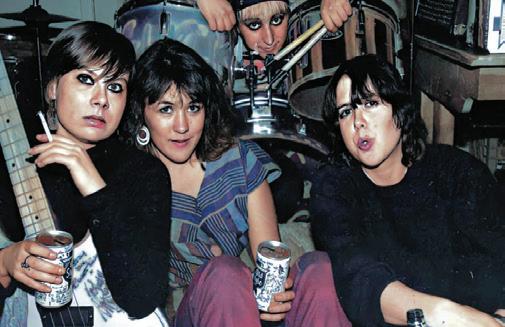
greatness?” Jean writes. “How many other bands in this city were going to play two gigs within 24-hours this weekend? Nobody.”
Needless to say, those gigs did not launch their career.
“But then, on the boat, everyone was throwing up, and for the Halfway to St. Patrick’s Day gig, nobody came to it,” Jean laments. “People actually rented out Navy Pier and nobody came.”
To add insult to injury, at Navy Pier the girls got kicked o the stage after a sound person assumed “Stained but Clean” was a song about abortion. The engineer turned o the microphones while they were playing. “One girl’s craft is another girl’s stain,” they sing. “Wash away, baby, wash away / It’s soaked into the fabric, can you let me explain.”
“There were information wars. We were in an all-girl band. It was this assumption that if you’re an all-female band, you’re a proabortion band,” Mary says. “It’s like being called a communist because you’re teaching English to the poor.”
The band claim the song is about their towels: “We’d have guests over, and when they would take a shower, they would ask for a towel,” Mary explains. “And we would say, ‘It’s stained but clean’—it’s been washed, but it has a stain.”
In 1989 and 1990, Barbie Army played Chicago blues bars, including the New Checkerboard Lounge and the Cuddle Inn on the south side and the Sexy Kitten Lounge on the west side. They advertised their original music as a “Freak Show.”
“It was very surreal,” Jean says. “We never played blues songs. We only played our originals. The guy who was booking us was this
Various Barbie Army lineups, clockwise from upper le : Starbuck Avon (then Judy Johnson), Mary Dean, Tina Matlock, and Jean Lotus (then Jean Lyons) in 1986; Mary, Jean, and Tina in 1986; Alaina Lemon, Tina, Lyn Pusztai, and Jean outside the band’s Pilsen practice space in 1988; Tina, Ellen Phillips, Jean, and Liz Tate in 1990
COURTESY





 JEAN LOTUS
JEAN LOTUS
freaky fellow who made T-shirts for blues musicians. We tried to start an all-ages ‘scene’ at the fabulous Cuddle Inn (54th and Ashland), and it didn’t really work out.”
“We were invading a space we had no business in,” Tina says. “I remember getting heckled, and I was like, ‘We deserve it.’”
“I just remember the emcee would continuously forget our name,” says Liz Tate, who played bass for the band in 1990. “He would just say, ‘Let’s hear it for the queens!’”
“We played some of the cool bars that were chitlin’-circuit throwbacks to the 50s,” Jean says. “They sold hard-boiled eggs and pig-ear sandwiches, and they gave you a beer with a straw. That was a great weird era, and we got to see it up close.”
During this period, Barbie Army endured a lot of internal turmoil—beginning in 1989, their lineup changes reached an almost comical pace. Jean and Tina remained constant, but guitarists and bassists came and went. “They went through a long list of bass players,” Ron recalls. “It seemed like they had a new one every week.”
When Starbuck left, Mary took over on bass, and the group became a trio. Eventually Mary moved to Boston, after which Barbie Army’s bassists included the aforementioned Liz Tate, Lyn Pusztai, Christine “Sixteen” Garcia, Joan Baby, Tanya Mushinsky, and Glynis Johnson from Friends of Betty (Smashing Pumpkins wrote a song called “Glynis” about her death, after she passed away from AIDS complications in 1992).

“I remember a 16-year-old Hispanic girl that played a show with them at China Club,” Ron says. “She was backstage doing her homework
before the show.” That bassist was Christine Garcia, but the band called her “Christine Sixteen.”
“She used to sneak out the window to come play shows, and we would drive her back home to 99th and Exchange in our Dodge Caravan,” Jean says.
In an attempt to solve the bassist problem, Jean and Tina decided to go with a known quantity instead of a stranger with chops. “We had gone through so many bass players that Tina and I were like, ‘Let’s just get a friend and teach them how to play bass,’” Jean says. The two of them talked Lyn Pusztai into it—she had little experience, but she had great stage presence and a cool headless bass.
Guitarists included Debbie Jurek, Alaina Lemon, and Ellen Phillips (of early-90s Chicago outfit Rustbucket), who was friends and roommates with Liz Tate at Northwestern and joined Barbie Army with her.


Despite all these changes, the band continued to gig a lot. “When Liz and I joined, we played all the time,” Ellen says. “We played so many shows in just a few months.”
“Maybe six shows a month,” Liz adds. “Sometimes more than one a week.”


“And when we weren’t playing shows,” Tina says, “we were putting up flyers all over the place for a couple of hours a night.”
Once the band even lost a member in the middle of a concert. “I switched from guitar to bass when Liz quit Barbie Army in between sets at a show at Club Dreamerz in Chicago,” Ellen recalls. “I played bass for the second set.”
Barbie Army’s self-titled seven-inch, with an original and a cover on each side, came out while their personnel were constantly shifting.
54 CHICAGO READER - MARCH 31, 2022 ll
continued
53
from
The A side features songs recorded by Jean, Tina, Liz, and Ellen; on the B side, the lineup is Jean, Tina, and Glynis. The A side opens with the original “Girls of Slender Means,” inspired by the title of a Muriel Spark novella. “We are the girls of slender means,” they sing. “We do not share our lipstick or our men / We serve all day in the canteen / Our purse is empty, but our hips are thin.”
All the lineup changes, compounded by personal factors, contributed to Barbie Army’s demise. They finally disbanded in 1991.

For the reunion show in May, six former members of Barbie Army plan to convene at Phyllis’ Musical Inn—and those are just the ones who’ve confirmed so far. Ellen is flying in from Los Angeles, and Starbuck still lives in Chicago. Alaina is coming from Ann Arbor, and Tina from Madison. Jean and Mary will both be there, of course—they’re back in Fort Collins, Colorado, where they’ve been playing together again (a few years ago, Mary recorded a song Jean cowrote called “Rats on the CTA”). My band Beastii will open.
The show is intended as a one-off, but reunions like this have a tendency to get out of hand. If the musicians have a great time—or if
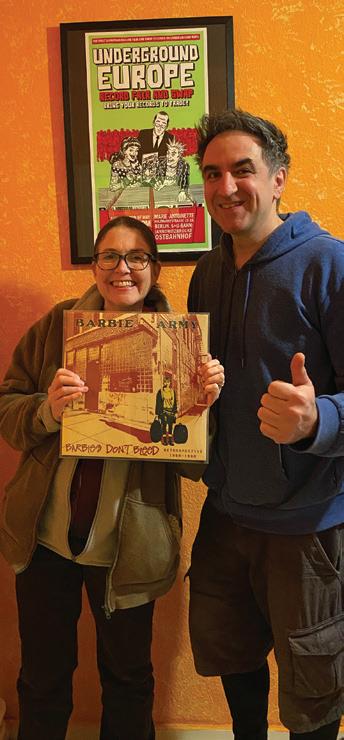


the reissue takes o —then it’s anyone’s guess what else might happen.




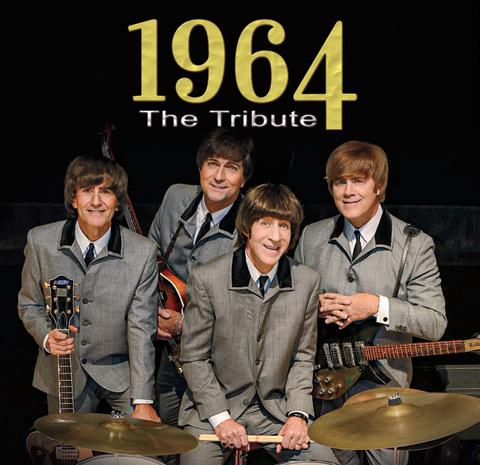
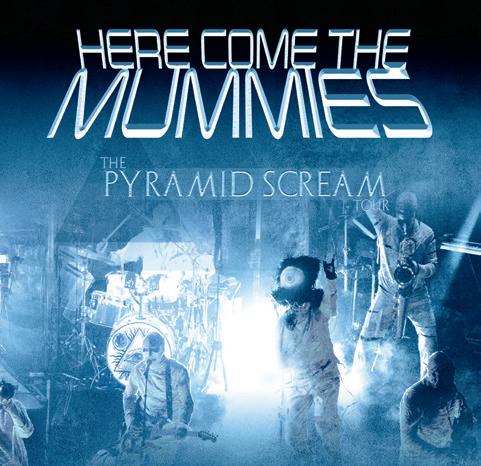
The people who knew Barbie Army back in the day remember the group as entertaining onstage and off. Chicago actress Karen Vaccaro, who’d already won two of her three Je Awards by the time the band formed, considered them friends. For a while she pulled o a shtick as their “manager,” riding around in their white band van to gigs.
“I would sit in the front seat, as the band manager—or this persona of the band manager—who always made sure the girls had a clean change of underwear,” Karen says. “And at the gigs, I would negotiate with the venues. I’d ask, ‘Will you be providing Diet Cokes for all the girls?’ I was like this schoolmarm.” At their shows, Karen remembers, she would dance wildly.
“They were a fun band to see and play shows with,” Ron says. “We didn’t care about making money or ‘making it’ back then. We were just in love with playing shows with our friends and having fun. We played in any weird club or dive bar that would have us, and we loved it!” v @jen_b_larson
MARCH 31, 2022 - CHICAGO READER 55
GENESEE THE SPOTLIGHT IS CLOSER THAN YOU THINK THE 22_0788_Chicago_Reader_Ad_GEN_JT01Mod:March10,202210:37AMPrint:03/14/2210:19:56AMpage1v7 SHOWS YOU WON'T WANT TO MISS! 203 NORTH GENESEE STREET, WAUKEGAN, IL BOX OFFICE HOURS: TUE–FRI 11 AM - 4 PM, SAT 10 AM - 2 PM GENESEETHEATRE.COM TICKETMASTER: 800-982-2787 "Eye in the Sky" and "Games People Play" "Freak Flag" and "Ra Ra Ra" Saturday, April 23 7:30 PM Friday, April 8 8:00 PM Saturday, May 7 7:30 PM "Eight Days a Week" and "I Saw Her Standing There" ALAN PARSONS LIVE PROJECT Jean with Dario “Adam” Adamic of No Plan Records and the Barbie Army release Barbies Don’t Bleed: Retrospective 1986-1990 COURTESY JEAN LOTUS
It can feel quixotic to write about the unjustly obscure. When they pass away, saving them from oblivion becomes even more difficult—and even more urgent.
By JAKE AUSTEN
On December 13, I took a long drive to Des Plaines to pick up relatives of my friend Perry Kanlan, a showbiz- adjacent eccentric known as Dancin’ Man. The time on the road gave me the chance to reflect on the circumstances of my relationship with him. I formally met Perry in 2011, when my friend Lavon Pettis pitched him as a subject for a Reader article, but at that point I’d already been noticing him for years—backstage at a Rudy Ray Moore show in 2002, I mistook him for a vintage-style pimp among the gaggle of gaudily garbed sexagenarians angling for some face time with Dolemite. It seemed I’d known him for longer than a decade, but at the same time I still felt like I’d gone too quickly from interviewing a motormouthed cowboy on the roof of Marina City to bearing the responsibility of helping his family take him o life support.
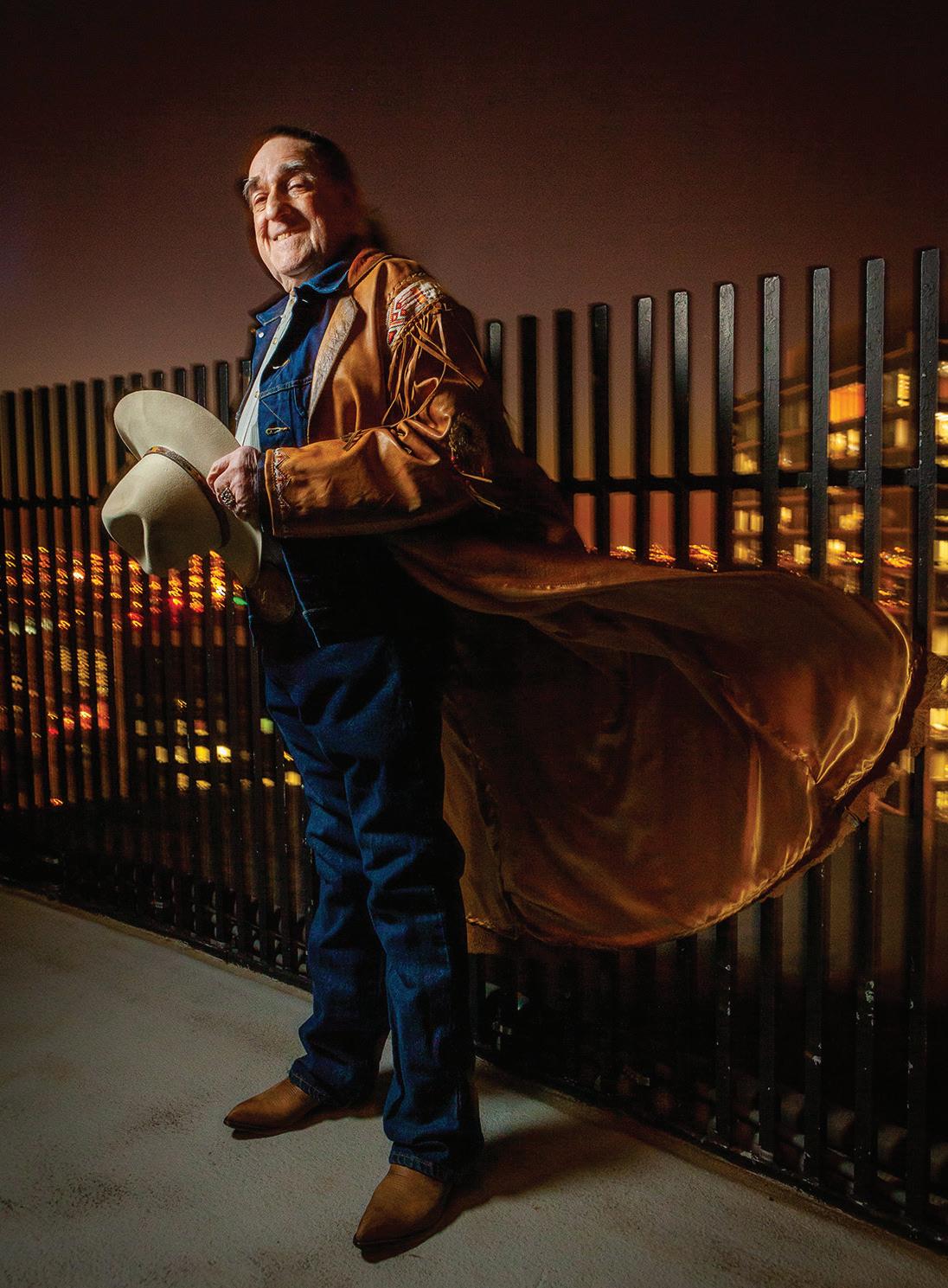
Making friends through work is pretty standard, and as a writer it’s not unusual to keep up with people you profile. And when you connect with a subject in need, it’s reasonable for that person to reach out for help—just as it’s reasonable for writers to impose boundaries.
I sometimes have trouble drawing those lines. Maybe I’d feel di erently if I were John Conroy, changing the lives of Burge policetorture victims, or a journalist at the TRiiBE, amplifying the voices of activists to help them toward their goals. What I o er my subjects is more modest: I share untold stories of unjustly obscure artists. I don’t have the tools or the clout to spark career revivals or improve their financial situations. So if these folks, who I happen to like, call me up for a ride or need help with a doctor’s appointment, that seems fine.
That said, this particular trip felt like a lot.
I told Perry Kanlan’s story in my Reader profile in 2011. He constantly carried a copy of that issue—along with a Walgreens photo envelope filled with snapshots of him with the likes of Michael Jackson, James Brown, and Kathy Sledge—to convince literal gatekeepers at festivals, clubs, and casinos to let him in unticketed. Born in 1943 into a well-o Jewish family on the north side (his uncle owned Ad-
56 CHICAGO READER - MARCH 31, 2022 ll
Perry Kanlan, aka Dancin’ Man, photographed in 2011 atop one of the Marina City towers, where he lived at the time JIM NEWBERRY FOR CHICAGO READER
miral Tool & Die), he soon landed in Bruno Bettelheim’s Orthogenic School for emotionally disturbed children due to his autism and bold behavior. After years of clashing with Bettelheim, teenage Perry ran away, hitchhiking across the country and settling into a cowboy gig on a Wyoming sheep and cattle ranch.
Perry’s family eventually tracked him down, convinced him to return to Chicago, and set him up with a room in Hyde Park. He became fascinated with the music and the women at the nightclubs on the south side, where his acrobatic dancing, wild fashion sense, and fearless lack of boundaries earned him attention. By the mid-60s he’d become Dancin’ Boy, earning modest pay and tips opening for, or jumping onstage with, acts such as the Jackson Five, Curtis Mayfield, and Chaka Khan.
In 1970 he partnered with Phillip “Blue” Weaver, a Black dancer known for spectacular James Brown moves, and they became Night and Day, a top act on the social-club circuit. Kanlan briefly went to Hollywood, where he appeared as a quickly dispatched henchman in
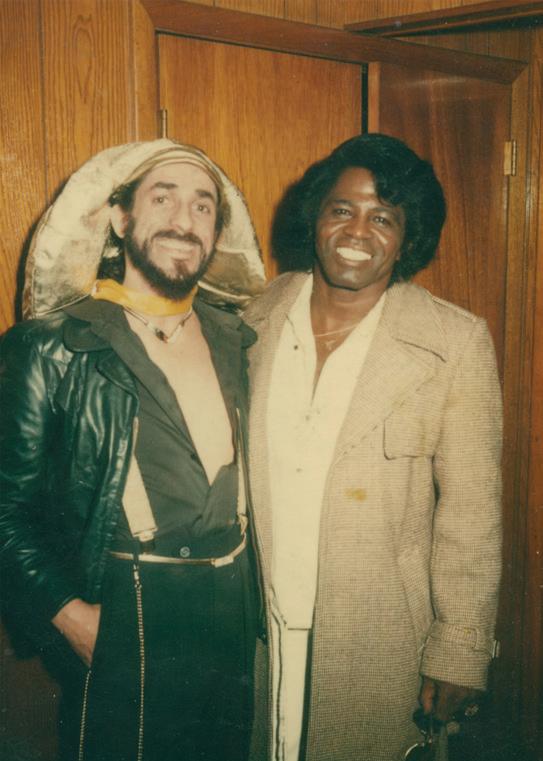
Moore’s 1975 movie Dolemite. Upon returning to Chicago, he drove a cab, mostly to take people (including himself) to clubs—he’d dance until closing, then drive folks home.
Perry received marginal support from his mother and her siblings, and he managed to sublet an apartment on the cheap in the iconic Marina City towers on State Street, filling every inch of his pie-slice-shaped unit with clothing racks and records. He was still living there when I interviewed him in 2011.
In the 21st century Perry lost his gymnastic moves, but he stepped up his fashion game to maintain visibility (and renamed himself Dancin’ Man). By the 2010s his parents’ generation had passed on, and his support dried up. He moved into subsidized housing, scrambling to keep himself in cowboy boots and costume jewelry. But he never stopped being Dancin’ Man, which I know because he frequently needed a ride to a club.

The most interesting thing about Perry, as every associate of his will attest, is that pretty much everything he said, no matter how fan-
tastic, turned out to be true. His cowboy daydreams actually materialized. If he claimed to have met, shared a stage with, or slept with a celebrity, eventually receipts popped up. But that’s not to say Perry didn’t live in a fantasy world. His “career,” especially in latter decades, often consisted of getting onstage uninvited and unpaid at someone else’s show. He knew everyone and would connect artists and venues, promoters and casinos, hustlers and hustlers, often to their benefit—but his belief that these deals would gain him fame or fortune was an illusion.
No one in Perry’s circle shook him into reality, mostly because he surrounded himself with fellow dreamers living on the fringes of showbiz. His good friend Rektify, aka K-Rek (who helped find Perry housing when he was facing the streets), has the surreal claim to fame of being hype man to Flavor Flav. Longtime running buddy Tony Wilson, aka Young James Brown, is a gifted impersonator who’s currently confident about the prospects of his jukebox musical featuring 3D-e ect digital av-
atars of stars (when we last spoke, he was trying to convince his pal O.J. Simpson to appear digitally). And I suppose that as a sporadic music writer, puppeteer, and zine maker, I’m right there with them.
I once accompanied Perry to a psychiatric evaluation. The doctor declared him delusional, concluding that Perry’s true tales of pending meetings with R&B stars were made-up. But as badly as he misread the symptoms, his diagnosis was spot-on.
In December, when I arrived at the longtime home of Perry’s sister, Laurel Phillips, and her 50-year-old son, Adam, I pulled up alongside a dilapidated Mustang GT and waited for them to come out.
I stayed outside because they’d said the home was cluttered, but it had looked fine years earlier, when I’d visited to help Laurel with Perry’s medical paperwork. That previous trip had been the first time I’d met Adam, but that hadn’t stopped him from greeting me loudly and warmly when I walked in. He was shirtless and cooking a single crudely peeled but otherwise uncut potato in a frying pan as if it were the last food in the house, creating a jarring contrast between his mile-wide grin and the Great Depression vibe of his culinary endeavor. The small apartment contained at least two tabletop arcade video games, which along with the Mustang were the fruits of a long-squandered settlement from one of the two times Adam had been severely injured as a pedestrian by a drunk driver.
Adam was just as upbeat on the drive to the hospital to speak with Perry’s doctor. He and Laurel aren’t exactly housebound (they frequently visit nearby casual dining spots, and can hold forth endlessly on the magic of Golden Corral or the Olive Garden), but since the Mustang’s demise they rarely leave their suburb. Laurel had been the point person for all Perry’s medical matters, but in the four months her brother had been hospitalized in Chicago, she hadn’t been into the city.
As I drove south on I-90, the mother-andson duo were like wide-eyed tourists, marveling at digital highway signs, rejoicing at classic IHOP architecture, and booing any antenna they suspected of spreading 5G. (Like Perry, they’re wary of cell phones and don’t use computers or email.) Adam, like Perry, talks nonstop in a loud, bold voice, jokingly pining for the days of video arcades, hair metal, and Kentucky Fried Chicken signs with spinning buckets, and his mom cosigns it all.
It’s nice to see two people get along so well. They bounce off each other like a comedy team, and their best shtick is their sudden
MARCH 31, 2022 - CHICAGO READER 57
Perry Kanlan in action (le ) and posing with James Brown. Like most of the photos from Perry’s collection, these are undated, but the white suit looks like something he might’ve bought when Saturday Night Fever became a hit in 1977. COURTESY JAKE AUSTEN / FROM THE COLLECTION OF PERRY KANLAN
continued from 57
swings from nihilistic kvetching to sunny optimism (their DJ neighbor terrorizes them with loud music . . . but he’s so talented!). Their COVID commentary during the drive is another perfect example:
Adam: All this because someone ate a bat. . . .
Laurel: C’mon, it was from a Chinese lab!
Adam: China is gonna get us all—they’re so bad.
Laurel: But so smart.
Adam: Yeah, and they do manufacture parts for my video games. You gotta love ’em!
We got to Uptown and parked outside Weiss Memorial Hospital, where Adam was born and where Perry now lay. I was concerned for Adam on the walk, because despite the cold he was in the same outfit I’d usually seen him wearing: a Khalil Mack Bears jersey he’d gotten on clearance, baggy black gym shorts, and no jacket. But he insisted he was fine, and we focused our attention on the task at hand.

Perry, who’d been using a walker since his years of leaps and splits had caught up with him, had been found unconscious in his apartment in August, his weight dwindled to a number no adult human’s ever should. He’d been diagnosed with cancer, hospitalized for months, and unresponsive for weeks. Today the doctor needed Laurel to decide if Weiss should continue measures to prolong his life artificially or send him to hospice. The doctor spoke kindly and calmly, making it clear that he would abide by Laurel’s choice.
Because of COVID, only one of us was al-
lowed to visit Perry at a time. Because of a medical complication, we could only see him through a window. Laurel went first while still weighing her decision. I went next. I had visited Perry once in the hospital when he was still alert, and it hadn’t been pretty. As I’d entered, nurses were giving him a sponge bath, and his emaciated body was more crooked than ever. I’d stayed an hour, though it was hard to spark a conversation. Perry was in a bad mood, uncommunicative, and in physical pain. But he was still Dancin’ Man. When an ad with Cedric the Entertainer came on the TV, Perry perked up, boasting about meeting him.
Eight weeks later, I watched him through the glass, Perry center stage again, facing the window in the hospital-bed equivalent of sitting up. He looked peaceful. And just as on my earlier visit, his hair looked incredible. Perry’s flowing raven locks looked like they belonged on a cover model for a romance novel, with not a touch of gray and not a strand out of place. I suppose it’s possible that the hospital has a beautician touching up coma patients for visits, but it’s equally likely that Perry just magically looked good whenever the spotlight fell on him.
When I emerged from my visit, Laurel had made her decision. After signing some papers, I took her and Adam back toward their home. The ride was kind of beautiful. The Dancin’ Man’s sister began to remember vivid details of her childhood with Perry. She recalled his love of trains (he’d sometimes convince conductors to let him operate the controls); his glorious moments of defiance; his genius for navigating the country as a penniless teen
using charm as currency. In these memories, she mostly seemed to find peace, but her mood turned when she recalled his di culties at the Orthogenic School.
Laurel’s take on Dr. Bettelheim and the O-School, like Perry’s sense of reality, seems accurate but not strictly factual. She said Bettelheim had committed suicide after being outed as a fraud. But revelations about his faked credentials came out mostly after his death in 1990 at age 86; though he did commit suicide, he was likely motivated by ailing health.
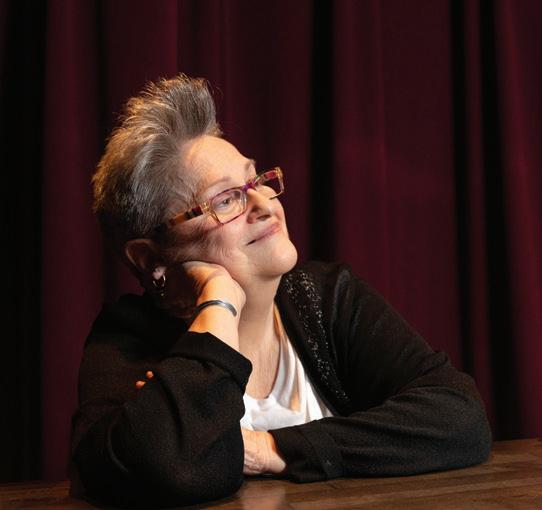
Laurel believes that Bettelheim’s experience as a Holocaust camp survivor led him to run his school like a Nazi concentration camp. Former pupils have recounted harsh and abusive treatment, including writer Tom Wallace Lyons (his 1983 novel about it, The Pelican and After , included a roommate character based on Perry) and the anonymous author of a convincing letter to the editor that the Reader ran in 1990. But the Nazi comparison seems like a stretch—and even Lyons dedicated his book to Bettelheim “with gratitude and a ection.”
Laurel also says Bettelheim was terrible to her mother, which I have no trouble believing. A foundational element of his philosophy was that emotionally cold “refrigerator moms” were the cause of autism.
We stopped at Outback Steakhouse for lunch. Watching Adam interact with the server was something of a revelation. Like Perry, Laurel and her son have an unusual energy that people react to positively. Adam should be a restaurant server’s nightmare: he’s loud, he barks repetitive jokes, and he makes a mess
eating with his fingers. But everywhere I went with him and his mom, the sta lit up in their presence.
A couple weeks earlier, when we’d visited the Zelda Ormes Apartments where Perry had lived, looking for important papers and a Rubik’s Cube pendant that Adam coveted, it was an explosion of positivity. The building’s supervisor loved Laurel’s haircut, and Adam complimented the assistant on her resemblance to TV reporter Dorothy Tucker. There were hugs all around. They charmed the building’s custodian as we surveyed Perry’s disaster of an apartment. Perry had worn holes in the upholstery of his couch by sleeping on it, because his bedroom was stu ed floor-toceiling with outfits. His living room was filled with a thousand records, though he’d pared that collection down dramatically—it was less than half the size it’d been when his belongings were in my basement after his eviction from Marina City.
Shortly after Perry passed away, it was another lovefest when we visited Alcala’s, the western-wear superstore on Chicago Avenue where Perry had spent so much time and money. Robert Alcala treated Laurel like a long-lost friend. We visited because Alcala’s, amazingly, still has a layaway program in the 21st century. Perry had so many items on layaway, now never to be bought, that the shop returned more than $500 to the family.
Some doctors have told Adam that he’d suffered brain damage from his accidents. He always seems sharp, though, and his obsessions and behavior feel eerily similar to Perry’s. Adam has a penchant for delivering the day’s weather report in a lengthy spill of meteorologist jargon that recalls Perry on a verbal roll.
Adam knows he’s a charmer, and he boasts that he can win anyone over. This skill set embroiled him in one of the oddest chapters in the Dancin’ Man saga that I was around to witness.
A bombshell decades Perry’s junior had moved into his bed, though he was the opposite of a sugar daddy—he was penniless, squatting at Marina, and hoping for a miracle to pay his back rent. Soon after moving in, the seductress introduced Perry to a gentleman who paid some of that back rent and promised riches—in exchange, he wanted Perry to connect him to his famous friends, to whom
58 CHICAGO READER - MARCH 31, 2022 ll
Perry Kanlan’s sister, Laurel Phillips, and her 50-year-old son, Adam, at a memorial for Perry held at the Promontory on Monday, February 28 GONZALO GUZMAN FOR CHICAGO READER

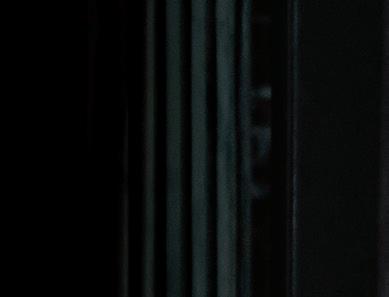
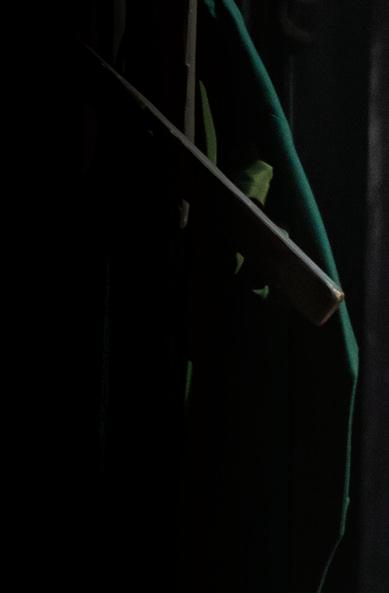

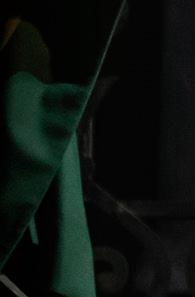


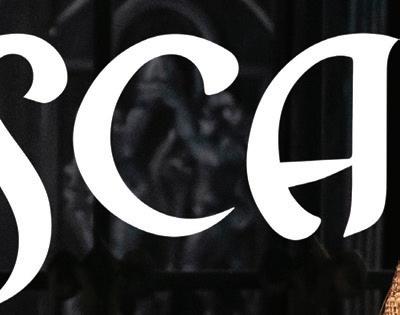
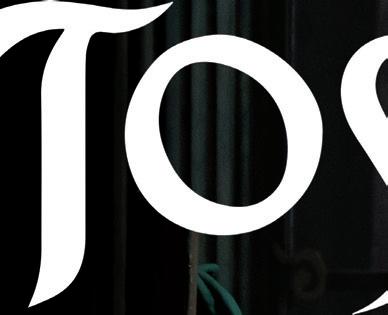


MARCH 31, 2022 - CHICAGO READER 59 3 performances remain through April 10 She’ll stop at nothing for love. Buy your tickets today lyricopera.org/tosca PUCCINI “ moving ” Chicago Tribune Newcity “ thrilling ” Chicago Sun-Times Lyric Opera of Chicago thanks its O cial Airline, American Airlines
Season Sponsor
Photo: Todd Rosenberg
he would pitch a pyramid investment scheme that involved (I believe) a Christmas-themed animal movie. After Perry’s showbiz cohort proved too savvy for that pitch, things got even shadier. The interloper convinced Adam to use his people powers to entice the Phillipses’ broke neighbors to blow their savings on the scheme. It was pretty jarring to hear Adam recall a former friend’s downfall in his signature upbeat voice: “Ah, his marriage was going to end anyways.”
Perry passed away in hospice on Christmas Eve. He was 78. Jewish aid organization the Ark, which hosted the Passover seders he attended, arranged his burial. By that time, though, things had fallen apart at the Phillips home. Both Laurel and Adam had contracted COVID, and Adam was hospitalized with life-threatening heart damage. Laurel’s case was less severe, but she’d become incapacitated after a dolly of milk crates fell on her at a Walgreens. Rabbi Shlomo Tenenbaum at the Ark had to reach me through the Reader to get in touch with the family. I connected them, but despite Jewish tradition—which calls for no embalming and a quick funeral—the graveside service had to wait until the Phillipses recovered.
On January 18, I picked up the pair to take them to Waldheim Cemetery in Forest Park, where Perry and Laurel’s mother is also buried. I’d half-joked with Adam the night before that he should wear his best shorts, and he answered seriously that he only had shorts. When I showed up, the only modification he’d made to his uniform was a thin winter coat and a custom T-shirt made by a neighbor that featured Jim Newberry’s beautiful Reader cover portrait of Perry. Laurel wore the same shirt, easily visible because the only coat she owned would not zip. Fortunately the weather cooperated—as Adam put it, it was “partly sunny, mild and balmy in the 40s, with cloud-filtered sun.”
Moments after the cemetery clerk gave us directions to the plot, a gleaming 2022 Lincoln MKZ Hybrid pulled up. The clerk told the driver to follow us. At the gravesite, Laurel was overwhelmed to be reunited with a long-lost cousin who’d seen the funeral notice. While they embraced, the door to the Lincoln swung open and Charles Reynolds emerged from the car in a Black Diamond mink coat and a leather Louis Vuitton COVID mask.
In recent years Charles had been Perry’s first call when he needed a ride or had a scheme. The two had become close, bonding over their mutual love of western wear, R&B,


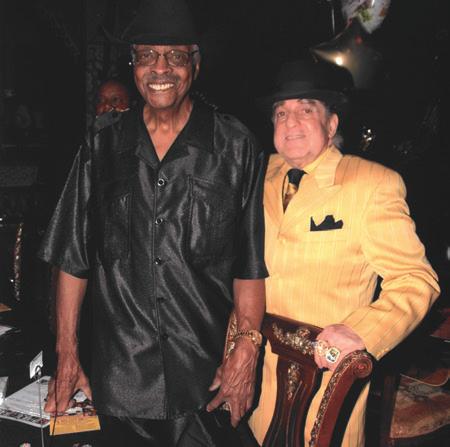
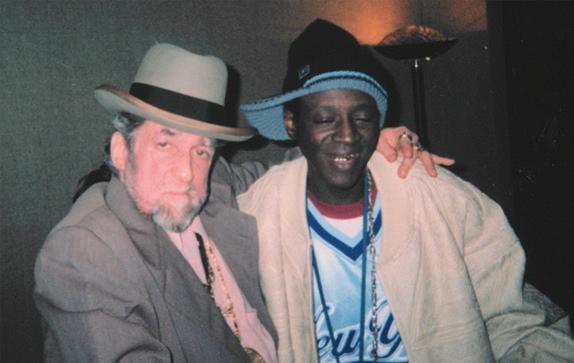
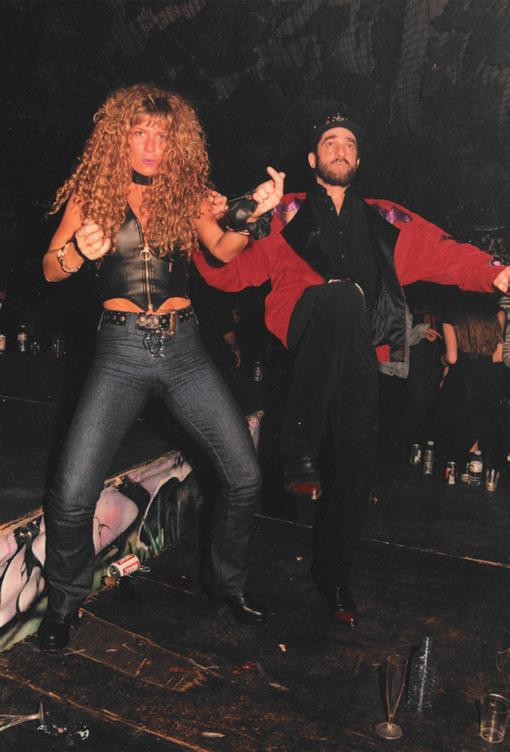
60 CHICAGO READER - MARCH 31, 2022 ll
continued
58
from
Clockwise from upper le : Perry Kanlan with Tito Jackson, Jackson family matriarch Katherine, and his friend Rektify; with an unidentifi ed dancer; with legendary radio DJ Herb Kent, the Cool Gent; with George Clinton; and with Flavor Flav
COURTESY JAKE AUSTEN / FROM THE COLLECTION OF PERRY KANLAN









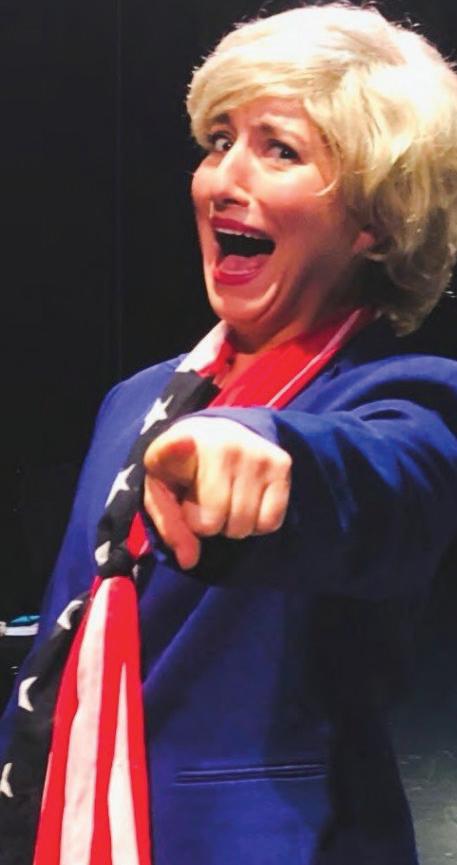

MARCH 31, 2022 - CHICAGO READER 61 SEASON SPONSOR 847.673.6300 NorthShoreCenter.org NORTH SHORE CENTER FOR THE PERFORMING ARTS IN SKOKIE NORTH SHORE CENTER FOR THE PERFORMING ARTS IN SKOKIE AN EVENING WITH LINDSEY BUCKINGHAM THU, APR 21 The Rock and Roll Hall of Fame former lead guitarist and singer of Fleetwood Mac gives an intimate concert. JESSE
FRI, APR 01 Virtuosic flamenco guitar with jazz, rock, rumba, gypsy, tango, salsa, and other forms of world music. RYAN HAMILTON FRI, MAY 13 A hilarious clean comic that is one of Rolling Stone’s Five Comics to Watch. DC’S REFLECTING FOOLS A Peaceful Transfer of Comedy from The Capitol Steps APR 8-10 Let’s Build Back Buffoonery! The stairway to heavenly political satire continues upward.
COOK
and Dancin’ Man’s one-sided stories. Because so many of the characters in Dancin’ Man’s orbit live in aspirational realities, I made the call to never research his background, but Charles (aka Sir Charles) seemed to have more resources than the rest of the crew. I knew he had something to do with concert promotion and had a notion of involvement in on-air radio; he’s spoken of handling transportation for Tyler Perry’s Atlanta productions. Charles also works at Taylor Funeral Home.
As Charles offered the family his condolences in a golden broadcaster’s voice, Rabbi Shlomo took me aside. He explained that he’d read my Reader article, and that while he was sorry he’d never met Perry, he felt like he knew him. He asked if I’d written the recent Reader story about Chicago hip-hop veteran P-Lee Fresh (that was Leor Galil’s work). The previous week he’d presided over Fresh’s funeral.
Because only five mourners were present (excluding the rabbi and Susan Winkelstein from Chicago Jewish Funerals), I was by default a pallbearer, helping carry the cardboard box bearing my friend’s alarmingly light body. The top of the box identified its contents with one of those Avery label stickers you can run through an o ce printer, and I thought Perry would’ve been pleased that it said “Dancin’ Man.” Remnants of snow were melting atop the wet soil, and my dress shoes sank deep into mud as we approached the grave. As the groundskeepers began lowering the casket, Charles asked them to pause. He went graveside, took out his phone, and seemed to start a stream via Facebook Live. Though the rest of us were 15 feet away, I could make out what he was saying: he was delivering a stage intro for Dancin’ Man’s last show.
“Ladies and gentlemen, you could have been anywhere in the world right now, but I thank God for you being here with us at the gravesite of our dear friend and brother, known worldwide for his God-given talent in dancing and his flair for dressing. You would know him as . . . Dancin’ Man!”

The rabbi said prayers, and everyone o ered remarks. We cut short Adam’s thoughts on the recent closure of Gullivers Pizza by promising to gather at the cemetery-adjacent Portillo’s after the service. Laurel focused, with tangible bitterness, on the family members who’d cut Perry o , but she poignantly concluded that they’d missed so much by not understanding what was special about her brother.
Charles told a story about Perry asking for a delivery of socks and toiletries, even though Charles was scheduled to fly that day to a meeting with Sean Combs. When he pulled
up, Dancin’ Man was waiting curbside, as he had perhaps been for hours, and insisted on getting in the car and accompanying Charles on his trip (thus the toiletries). Since the flight was private, Perry didn’t need a ticket, but when they arrived at the meeting Charles was anxious about his friend’s lack of credentials. As Charles left Perry with security to try to make arrangements, the Dancin’ Man was, as always, recognized and briskly ushered in.
Rabbi Shlomo concluded the service by recalling that as he was preparing his remarks the previous evening, he’d received a check-in call, apropos of nothing, from his friend Ruby Harris, aka the King of the Blues Violin. They’d been bandmates, playing klezmer at weddings, but due to the pandemic it had been more than a year since they’d played and months since they’d spoken. When the rabbi mentioned that he was eulogizing Perry, Harris lit up, recalling the times he’d driven Dancin’ Man home after blues gigs at the Joynt and the Redhead Piano Bar. That coincidence was too much for Laurel, who burst into joyous tears, rejoicing in “this miracle!”
There was one more surprise before we headed out to track mud into Portillo’s. Charles went to his car, disappeared behind the open trunk, and emerged wearing a magnificent lime-green ostrich-leather threequarter-length coat with seafoam-green fox-fur accents and voluminous fur lapels (that converted into a hood). The coat, he
explained, was supposed to have been Dancin’ Man’s Christmas present. Perry had put it on layaway ages ago, and Charles had paid the balance to surprise his friend. When Dancin’ Man didn’t make it to Christmas, Charles decided to honor him by wearing it after the burial, keeping it on for the rest of the day. Sir Charles changed to a matching mask, and we went to remember our fallen comrade over dipped Italian beefs.
Iended up cleaning out Perry’s apartment mostly by myself, partly out of practicality (the cramped home would not accommodate a crew) and partly out of stupidity. My major miscalculation was that I’d seen the pared-down record collection and assumed Perry had also cut back on clothing. In fact, his closets, racks, and drawers burst with more fab fashions than ever.
I found more than 100 pairs of ornate cowboy boots, in almost as many colors, materials (there was lots of snakeskin), and sizes. (“If he liked a boot that was too big, he’d stu the toe,” Alcala told me.) Perry’s costume jewelry was stored in individual plastic bags and kept in drawers according to a filing system beyond my comprehension: pendants, rings, watches, and belt buckles, variously studded with plastic diamonds and shaped like guns he’d never held, logos of teams he’d never rooted for, or the trappings of gambling games he’d never played. I tried to put them all in one large
canvas bag, but I could barely lift it. After I divided the booty into three containers, they easily weighed 25 pounds each. I can’t even guess at the number of suits, dusters, pairs of crisp jeans, cowboy shirts, and colorful 90s-style leather jackets that had overtaken his nonfunctioning bedroom.
When packing up Perry’s records, I realized he had consolidated judiciously. Though he’d owned stacks of 70s, 80s, and 90s soul and dance records, those were gone. All that remained were classical and soundtrack recordings. The classical LPs were meticulously sorted by composers, and the soundtracks were even more artfully arranged—not only by genre (sci-fi, comedy, et cetera) but also chronologically within each genre (particularly impressive was a near-complete run of James Bond vinyl in order of release). I knew Perry had liked to watch old movies (he’d been excited when Jackie Stewart, my wife at the time, began hosting silent films on TCM), but I’d never heard him play a record.
The way those records were organized made me reassess my assumptions about the solitary time of Perry Kanlan. On occasion, he must have put on his favorite opera or Morricone score, enjoying the artistry in a way I’d never seen him do at a concert—on those occasions, he was always laser focused on getting onstage.
I pulled out some Mel Brooks records for my son, an LP of an I Love Lucy radio show for
62 CHICAGO READER - MARCH 31, 2022 ll
continued
60
from
When Kathy Sledge of Sister Sledge played Market Days in 2009, Perry Kanlan joined her onstage. COURTESY JAKE AUSTEN / FROM THE COLLECTION OF PERRY KANLAN
For Chicago Fire stylist Steykine Wills, the main job is about helping to build characters
By Matt Simonette
Chicagoan Steykine Wills, a hair stylist who works full-time for the locally-produced television drama Chicago Fire, sees helping to create characters as a central part of her job.

“Depending on if a character appears disheveled, for example, we have to make them appear that way,” Wills explained. “We have to read the script and make sure that the hair coincides with what the character has going on.”
Wills grew up on Chicago’s South Side, and is a graduate of Myra Bradwell School of Excellence, Simeon Vocational High School and McCoy Barber College. She had long wanted to use her skills in the lm and television industry.
“I had always been interested in doing it—I just didn’t know how to do it,” Wills said. “ ere were no programs to show you how to get in.”
But a coworker began working in local lm and television productions and, in 2018, referred Wills to a department head for the HBO series Lovecra Country
“From there, I just started building relationships and just started getting callbacks and people asking me to work for them,” she said.
Wills worked steadily on a number of local productions, among them Chicago P.D. and season 4 of Fargo. But then the COVID-19 pandemic hit Chicago, and her work ceased on March 12, 2020.
“Two weeks ended up being six months,” she said. “I was o for those six
months, just sitting around. But then I started doing online classes, trying to keep up with work, learning di erent things and doing classes to occupy my time. It was okay, but a little depressing.”
She was brought back to nish up the lming for Fargo, which halted mid-production, and then, in March 2021, landed a full-time position with Chicago Fire
Most days, Wills is now assigned a di erent actor to work with. She’ll prepare their hair ahead of shooting, then later go with them to the set and help look a er them to keep up with the continuity of their scene over the course of shooting.
“So for example, if we have someone with long hair, we have to make sure it’s in the same position,” she said. “So we watch the monitor via our iPads and make sure that everything looks the same.”
She said that she was “ecstatic” when she was voted into International Alliance of eatrical Stage Employees (IATSE) Local 476.
“I hear a lot of stories about people who were trying to get into their union for years, but it only took me a year,” Wills said. “I remember the day. I was riding my bike by the lake and I got a call, and they said, ‘We want to vote you in.’ I was so excited.”
For those looking for a path forward doing hair styling for lm and television production, she advises, “Make sure this is something you really want to do. It’s di erent from being in a salon. You have to dedicate yourself to learning all you can learn… Try to get all of the knowledge that you can before you even get into the business. It’s about a lot more than doing hair— it’s about learning what goes on a set and learning the set lingo. e most important thing is to do your research.”
Launched in late 2021—with a second round of applications opening this summer—the Chicago Made workforce development program o ers job training and placement to Chicago residents ages 24–50, primarily from underserved areas, to help meet the industry’s increasing demand for skilled workers. e program is an initiative by the Chicago Film O ce at the Department of Cultural A airs and Special Events (DCASE) and the XDTECH consultancy.
NBC Universal, Net ix, e Walt Disney Company and Warner Media provide on-set training for the program. A number of local rms and organizations, as well as unions IATSE Local 476 and Local 600, have provided support as well.
A record 15 productions lmed in Chicago in summer 2021, bringing with them nearly $700 million in economic impact. e Chicago Made program links projects such as those with workers from across the city.
SPONSORED ADVERTISEMENT
This series, from the Department of Cultural Affairs and Special Events (DCASE), asks Chicagoans in the film industry to share their experiences. Learn more at ChicagoMade.us and join the conversation on social media using #ChicagoMade.
MARCH 31, 2022 - CHICAGO READER 63
my daughter, and some early Black cinema soundtracks for Jackie, then loaded 19 punishingly heavy boxes into a truck. Eventually I sold the haul to Dusty Groove.
Charles and his funeral-home teammate Benny helped haul the rest of Perry’s massive collection of stu to a storage space Charles had rented, where it would stay until his wife could figure out how to donate everything. Out of respect for Dancin’ Man, Charles paid Laurel for dozens of boxes of clothing he did not want, to keep his friend’s beloved vines from ending up in a dumpster. Laurel and Adam didn’t have room to keep much—though they did take the Rubik’s Cube pendant, which had eluded us in December but which I’d luckily found.
Between Charles’s purchases, the proceeds from my trip to Dusty Groove, and the layaway refunds, the Phillipses got a modest but respectable amount of money. If Alcala’s bought back boots, or if CHA apartments allowed estate sales, or if the Phillipses had been able to sell things through eBay or on consignment in vintage shops, it might’ve been more. Still, it was nice that perennially broke Perry had managed to leave a small inheritance to the relatives who loved him most.
My main focus in cleaning out Perry’s home was to make sure his photos were preserved. I was thinking about other Chicago stories—Henry Darger’s paintings being discovered just before his death, or Vivian Maier’s negatives being rescued from the trash—but this one had a major difference. Perry’s photos were his most valued possessions, but by the standards of capitalism they’re worthless. These poorly composed, cheaply processed snapshots couldn’t be less like Maier’s revered work, and there will be no fights over their ownership. A beautiful co ee-table book of Perry’s photos would be fascinating, but it’d break even at best. If a gallery wanted to exhibit Dancin’ Man’s photos, it’d be cool, but there’d be nothing to sell, no money to be made.
Investment value isn’t the only reason to preserve something, though, and Perry’s photos should be archived somewhere—not only because they were important to him but also because he was an important artist. His art was dressing up in brilliant, magnificent outfits, dancing until no part of his body worked, and stealing the show from some of
the greatest performers in history. Like Christo’s lithographs of his diagrams for wrapped monuments or Vito Acconci’s ink prints of the bites he inflicted on himself, these crappy photos are not Perry’s art, but they represent his art. Perhaps more than my Reader articles or the fallible memories of the other people who knew him, they may be what keeps his art alive.
On February 28, Perry’s birthday, there was a low-key memorial at the Promontory, the music venue where I work. Charles bought food, and I scanned and edited about 400 of the photos (maybe a quarter of the total) for a lengthy slideshow. People could have a few drinks and share stories.
erson, the Reckless Records clerks, Screamin’ Rachael, the Underground Wonder Bar team. I could only do so much, though. When Blue and Young James Brown (aka Tony Wilson) showed up early and chided me for not personally inviting them, I felt I’d reached my Dancin’ Man limit. But when Wilson programmed the scrolling disco LED display on his COVID mask to thank all the attendees and Robert Alcala started passing out tiny cowboy hats, everything seemed right in Perry World.
Lavon Pettis and Young James Brown opened the service with a skit about trying to have a conversation with Dancin’ Man while he endlessly rambled on about Lola Falana and Kathy Sledge. Then the mourners took turns endlessly rambling on—but in a good way.
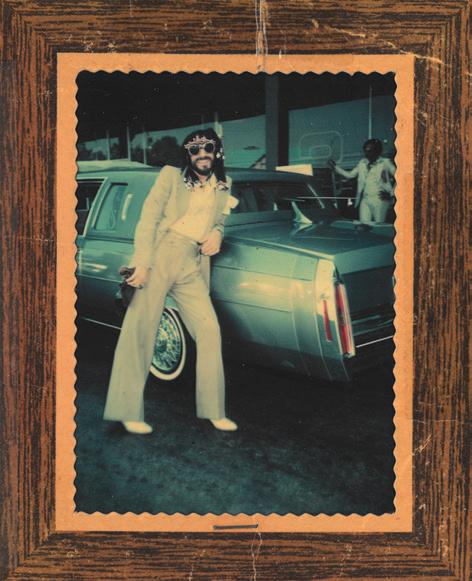
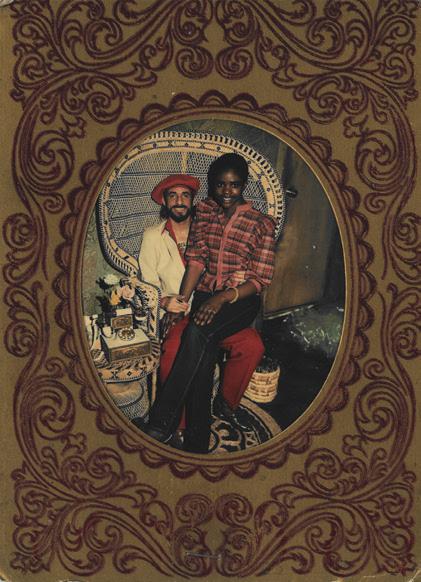
chitlin’ circuit the two of them had survived. Charles Reynolds, with his funeral-home background, was reverent and dignified. And Robert Alcala recalled how Perry’s informal salesman job (breathlessly talking customers into buying boots and jeans in exchange for store credit) made him one of the most beloved figures in the store’s long history.
But nothing in the Extended Dancin’ Man Universe stays normal for long. After the speeches a group of memorial crashers came in, happy to find a bar serving on a Monday. Considering how close Charles and Perry had been recently, he was unsurprisingly keyed-up emotionally, and that may account for what happened when he thought one of the crashers was looking funny at his wife. An explosion of cursing and threats filled the room, and he had to be held back. Charles has told tales of keeping the peace at funerals for slain gang members, so his outburst surprised me, but cooler heads prevailed and the potential repast brawl evaporated.
The scanning was a beast, because I was anxious about finding the best images. I hit pay dirt when I opened a black plastic bag whose neck had been twisted so many times that I just knew its contents were extra important. It held Perry’s only childhood photo and the jewels of his collection—Polaroids from the early 70s, taken by club photographers, of Perry and a parade of stunning women. I’d delegated the task of inviting memorial guests to Laurel and to friends of Perry’s I knew, but as I scanned the photos, I saw so many people I wished I’d had time to contact and add to the list—Tina Turner impersonator Dorothy Rob-
Laurel shared countless anecdotes about her childhood with Perry, railed against Bettelheim, and reminded everyone how special her brother had been. Pettis pointed out that Dancin’ Man’s ability to connect people, even though it never lifted him to where he wanted to go, made money for her and a lot of other folks. And best of all, Blue, who refused to acknowledge that Perry had ever graduated from the name Dancin’ Boy, told long, detailed stories about performances, encounters with stars (including funny memories of James Brown and Joe Tex), sexual conquests, paydays, and a treacherous tour of the southern
That drama was in notable contrast to the serenity of an hour before. Rabbi Shlomo, coming to pay respects to a man he’d never met and in some ways knew only through the Reader , turned away from the dais to admire the photos of Perry Kanlan doing the worm at Market Days, charming a 70s flamenco dancer with his moves and his Travolta suit, and riding a horse into the sunset. After moments of silence he said earnestly that these photos should be in the Motown Museum or the Rock & Roll Hall of Fame. Another attendee told the family that a statue of Dancin’ Man would be erected at the DuSable Museum.
Those things will not happen. But I did buy some sturdy boxes to preserve the photos. I will continue to scan a few envelopes full of pictures each week until I get through the whole pile. And I will work to make sure they get into an archive somewhere.
And at that point, I guess, I’ll have answered the last of my friend’s many calls. And though it has definitely felt like a lot, it’s been worth it. v
64 CHICAGO READER - MARCH 31, 2022 ll
@JAKEandRATSO continued from 62
Vintage snapshots of Perry Kanlan, including one in the sort of peacock wicker chair that o en served as a nightclub photo booth COURTESY JAKE AUSTEN / FROM THE COLLECTION OF PERRY KANLAN



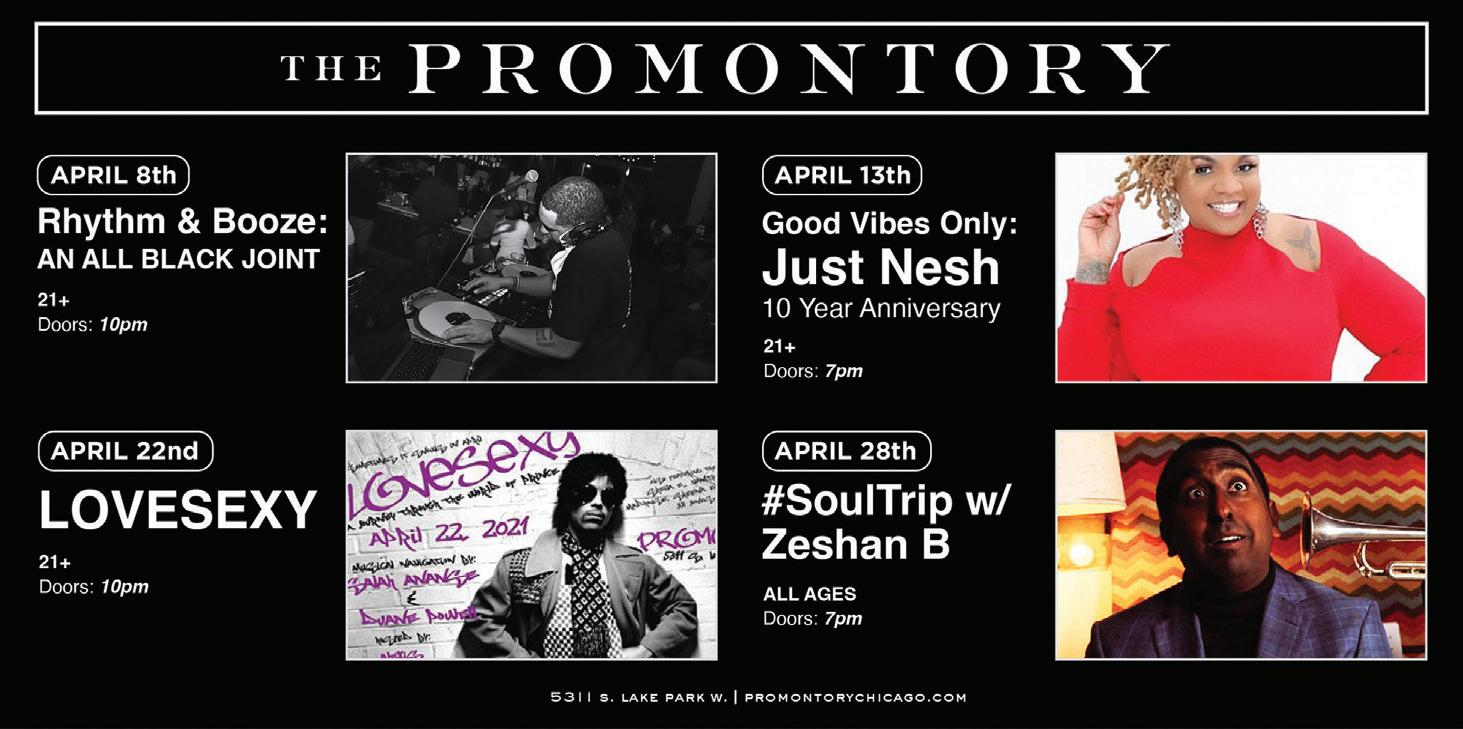
MARCH 31, 2022 - CHICAGO READER 65 4~4 SAT CHRIS RENZEMA antoine bradford 4~11 MON ALARM WILL SOUND 4~6 WED WE WERE PROMISED JETPACKS weaker friends 4~12 TUE TOM ODELL 4~7 THU ALTIN GÜN pachyman PRESENTED BY 4~21 THU MOONCHILD sofiya ballin, austin antoine 4~10 SUN WATCHHOUSE erin rae 5~1 SUN PEDRO THE LION oceanator 4~9 SAT HURRAY FOR THE RIFF RAFF anjimile 4~23 SAT TYPHOON carm 5~3 TUE THE CAROUSEL TOUR ft. anthony green, tim kasher, & mikey erg 5~7 SAT ALEX CAMERON aoife nessa frances THE MAVERICKS EN ESPA Ñ OL WORLD TOUR 5~5 5~6 FRI 4~22 LEE FIELDS kendra morris FRI 4~15 CITIZEN COPE MON 5~9 HELADO NEGRO PRESENTED BY COMING SOON TO THALIA HALL SIGN UP FOR OUR WEEKLY NEWSLETTER AT THALIAHALLCHICAGO.COM
Recommended and notable shows and releases with critics’ insights for the week of
MUSIC
PICK OF THE WEEK
Wayfaring return after three years with a new set of spiritually informed folk jazz

WAYFARING, SARAH CLAUSEN
Sat 4/9, 8:30 PM, Constellation, 3111 N. Western, $15, $5 streaming. 18+
JAMES FALZONE’S MUSIC HAS always spanned aesthetics. The Chicago native, who plays clarinets, shruti box, and percussion, has led and participated in ensembles that create various combinations of jazz, classical, and Arabic traditional music; he’s also served as an instructor at Columbia College and as music director of Grace Chicago Church. In 2016, he moved to Seattle to become chair of music at Cornish College of the Arts, an institution that has long included experimental and creative jazz musicians in its faculty, but he’s sustained relationships with some of his Chicago associates. One of them is bassist and vocalist Katie Ernst, his partner in the duo Wayfaring. While they’re of di erent generations, they’re otherwise kindred spirits. She’s music director for Wheaton College’s jazz band and for Grace Presbyterian Church in Winnetka, and she plays in jazz trio Twin Talk; she’s also been a regular participant in Ted Sirota’s Wednesday Night Jazz Fellowship, a jam session at the Hungry Brain. On Wayfaring’s 2017 album, I Move, You Move (Allos Documents), Falzone and Ernst’s shared a nity for poetic distillation manifests itself in more than one way: it’s audible instrumentally in a numbered sequence of intricate miniatures entitled “Tanka,” and it appears vocally in their treatment of Thomas Merton’s poem “In Silence,” as Falzone delivers an earnest recitation and Ernst’s singing makes the same words take flight. On the traditional spirituals “Nobody’s Fault but Mine” and “Wayfaring Stranger,” Ernst’s yearning vocals alternate with instrumental passages that recall the folk-tinged work of Jimmy Giu re. For the first time since 2019, the duo are reuniting at Constellation—the site of their first concert—in order to work on new material. According to Falzone, their set will include original compositions, old hymns and ballads, and tunes by Giu re and fellow jazz clarinetist John Carter. Saxophonist Sarah Clausen opens. —BILL MEYER
CONCERT PREVIEWS THURSDAY31
Uma Bloo Bridey and Brigid Broderick open. 9:30 PM, Hideout, $12, 1354 W. Wabansia. 21+
Before Chicago singer-guitarist Molly Madden began performing indie-rock songs as Uma Bloo in 2016, she used that stage name as a burlesque performer. As she told Tribune critic Britt Julious in 2020, burlesque provided her an outlet to explore complex emotions while giving her a confidence she hadn’t felt growing up in a devout Catholic household. These days Madden has a full band, and she’s just released a new Uma Bloo album, Don’t Drive Into the Smoke (Earth Libraries). Madden’s songwriting has burlesque’s flair for the dramatic gesture, and her somber electric guitar casts a spotlight on her voluptuous voice. She’s a careful singer, and o en drapes her tender, intimate lyrics over the music as gently as she might make a bed. Her bandmates employ a variety of styles that bring out the color and dimension in her performances, moving among arty synth sounds, alt-country, and indie rock. On “To Be Vast,” echoing snare drum and a smidgen of slide guitar enrich Madden’s languid singing with a dusky, golden swagger. And no matter what stylistic direction each song takes, Madden makes it clear that the stage belongs to her.
—LEOR GALIL
Summer Walker See also Fri 4/1. No1-Noah and Marvxxl open. 7 PM, Aragon Ballroom, 1106 W. Lawrence, $69.50. b
After the breakout success of Summer Walker’s 2019 debut album, Over It, the Atlanta singersongwriter continued its saga of betrayals and learned lessons with their 2021 follow-up, Still Over It (LVRN/Interscope). The cleaning technician turned songbird fearlessly plumbs the truth in every heartbreak through somber, grappling melodies. On their second album, they continue this approach while sprinkling in more upbeat tracks, such as “Ex for a Reason” (featuring JT of the City Girls) and “4th Baby Mama (Prelude).”
Walker shared a message on Apple Music upon the release of Still Over It last November: “Take this opportunity to learn from my mistakes,” they said. “You don’t have to guess if something is love. Love is shown through actions.” This perfectly sums up the insights you can gain from loving hard without bounds, as Walker expresses in their music. Throughout the record, Walker boldly owns the missteps they’ve made trying to make their relationships work, even acknowledging when they’ve traveled down the wrong roads; on “Circus,” they describe feeling out of control as they chase a lover who doesn’t reciprocate. Still Over It seems largely inspired by their public 2021 breakup with producer London on da Track, who produced much of the material on Walker’s two albums and is the father of their young child. But even though Walker sings from personal experience, their music continues to feel like a universal Band-Aid for the love woes that inevitably find us all. With their transparent lyrics— and with contributions from Cardi B on album opener “Bitter” and fellow Atlanta native Ciara in “Cia-
66 CHICAGO READER - MARCH 31, 2022 ll
31
March
b ALL AGES F
Katie Ernst and James Falzone of Wayfaring DAN MOHR
ra’s Prayer”—Walker taps into something relatable to people from all walks of life, no matter their status. Tickets for this show sold so quickly that Walker added a date on April 1. They’re sure to comfort and relax their audience, while reminding them that even though the pain of heartbreak feels individual, it’s an experience we all share and has the power to bring us closer together.
—JANAYA GREENE
FRIDAY1
Greyboy Allstars 8 PM, Park West, 322 W. Armitage, $30. 18+
The Greyboy Allstars are a bunch of rare-groove re-creationists from San Diego focused on mining soul, funk, and anything else with a deep pocket. Since forming in 1993, the group have consistently toured and put out six records and a couple soundtracks, but they spent the early months of the pandemic cloistered like the rest of us. While the group was sidelined from their usual routine, they decided to work up a bunch of their favorite tunes (originals as well as covers) and perform them in the studio for a contingent of remote fans. The resulting streaming series, titled Soul Dream, later turned out to be a preview of their current tour, and the best of the covers they performed eventually became their sixth album, Get a Job: Music From the Original Broadcast Series Soul Dream. These ten tunes offer a cascading look at the group’s influences, which run the gamut from pop staples to lesser-known personal picks, and each is embedded with at least a glimmer of the kind of funk that the Allstars expand upon. The band take on “I’ve Known Rivers” by saxophonist Gary Bartz, in an acknowledgement of jazz’s foundational place in the Allstars’ sound; Bartz himself is such an influence on members of the group that keyboardist Robert Walter invited him to collaborate on his first solo album, 1996’s Spirit of ’70, which was reissued last year. There’s also a version of “Jug Eyes” by Chicago-born saxophonist Gene
Ammons, on which the band revel in the vernacular bounce of his work and split solos between Karl Denson on sax and Elgin Park on guitar. The Allstars further solidify their jazz-world credentials with a cover of “Play It Back” by organist Dr. Lonnie Smith, and they also manage to inject a fair amount of personality into a rock song that’s been recorded by so many artists over the years it didn’t really need to be done again: the Beatles’ “Taxman.” The eclectic reworkings on Get a Job speak to the Greyboy Allstars’ studious approach and their ability to retrofit just about any tune to sound like something of their own making. —DAVE CANTOR
summer Walker See Thu 3/31. No1-Noah and Marvxxl open. 8 PM, Aragon Ballroom, 1106 W. Lawrence, $69.50. b
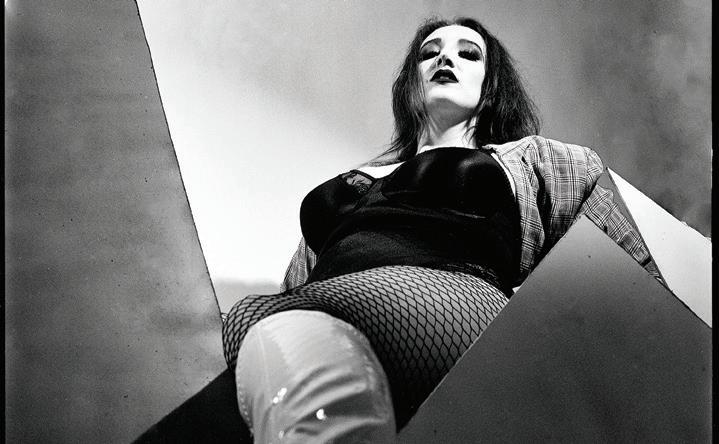
MONDAY4
Sons of Kemet Angel Bat Dawid opens. 8 PM, Lincoln Hall, 2424 N. Lincoln, $30, $25 in advance. 18+
Barbadian-British reedist Shabaka Hutchings can’t contain his creativity within a single group—right now he has three. His most expansive is Shabaka & the Ancestors, a sextext featuring several South African musicians rooted in Johannesburg’s freewheeling jazz scene. His tightest, the three-man the Comet Is Coming, brings the same spiritual profundity within a harder-rocking, more synth-saturated context. In the middle is Sons of Kemet, which has been one of the most paradigm- busting groups in contemporary jazz for more than a decade. The group’s music is immediately recognizable for its bass-heavy instrumentation: tenor sax or clarinet (Hutchings), two dueling drum kits (Tom Skinner and Eddie Hick, the latter of whom came aboard with 2018’s Your Queen Is a Reptile ), and a tuba whose bass lines sound as hefty as anything pumped
through a subwoofer (the indomitable Theon Cross, who joined the group for its second album, 2015’s Lest We Forget What We Came Here to Do).
The Sons’ April 4 show at Lincoln Hall is the quartet’s first local appearance since the release of last year’s Black to the Future (Impulse!). That album extends the distinctive sound of the Sons’ 2013 debut, Burn, where the group whittles down West African and Caribbean dance rhythms into sharp points that needle their way into the folds of your brain. Hutchings’s pocket-size melodies are a constant, emerging straight from the grooves and remaining inseparable from them. But Black to the Future centers text far more than prior releases, which treated verse as largely peripheral to the music. Here, original poems turbo-boost the Sons’ uncompromisingly revolutionary fervor. Sons of Kemet reunite with poet Joshua Idehen for a searing album prelude (“Field Negus”) and postlude (“Black”). Later, they tap Moor Mother of Phillybased free-jazz ensemble Irreversible Entanglements for “Pick Up Your Burning Cross,” which might be the album’s most irrepressible track, and collaborate with grime spoken-word artist Kojey Radical on “Hustle,” a close second (Kojey just released a scintillating debut album, Reason to Smile ). The keening vocals of Angel Bat Dawid set the stage for “Burning Cross,” and the Chicago composer and multi- instrumentalist will open this show. Her all-woman trio, Sistazz of the Nitty Gritty, are slated to release their debut on local label International Anthem at a to-be- determined date. —HANNAH
EDGAR
THURSDAY7
Axons Shannon Candy and Deep Fake open. 9:30 PM, Hideout, 1354 W. Wabansia, $12. 21+
One of the most remarkable things about Chicago is its complex relationship with crime. The criminaljustice and court system is o en so flawed, discrimi-

natory, and unjust that it can seem as harmful as the crimes it seeks to control. For more than a century we’ve also had an entire industry dedicated to sensationalizing and mythologizing Mafia figures, bank robbers, gang leaders, and serial killers. None of these institutions appears to care much about the suffering involved, especially that of violent criminals or people brutalized by the system itself—and that’s even more true when those people are one and the same. If anyone can find empathy for them, it might be Adele Nicholas, a local civil-rights lawyer and activist (she’s worked extensively in support of the Chicago Community Bond Fund) who’s also front woman of indie-rock trio Axons. The group’s upcoming release, I Object to Everything, is based on one of the city’s most astonishing incidents (criminal or otherwise) in recent memory: one night in December 2012, Joseph “Jose” Banks and Kenneth Conley, two federal prisoners awaiting sentencing for bank robbery, escaped out a window at downtown’s Metropolitan Correctional Center and rappelled 17 stories to the ground on a rope made of bedsheets and dental floss. They were eventually recaptured.
The audaciousness of that feat aside, it brings up questions about what it must be like inside American jails and prisons for a potentially suicidal mission to look like a better option. With tenderness and open eyes, Axons explore the events surrounding the escape and look at the damaged, dangerous men who lived to tell their story. That respect for everyone’s humanity rings clear throughout I Object to Everything , even when the songs touch on the absurdities that can coexist with crime and punishment. On the Pixies-influenced “Shove It,” Axons manage to turn Conley’s retort to the judge who sentenced him in 2014 into a poppy melody (“You told him he could shove it right up his ass”). The band don’t let anyone off the hook—the lighthearted “A Lot of Petty Stuff,” about robbing a store with a toy gun, turns somber at the mention of consequences—but they also keep the focus on the destructiveness of the justice system and on their admiration for the human spirit’s capacity to
MARCH 31, 2022 - CHICAGO READER 67
MUSIC
Uma Bloo, aka Molly Madden KEVIN ALLEN
Axons: Princess Ojiaku, Adele Nicholas, and Sarah Sterling JAZMYNE FOUNTAIN
carry on in dire circumstances. Album closer “Twenty More Years” resists the idea of getting comfortable with imprisonment, no matter how long it lasts.
—JAMIE LUDWIG
SATURDAY9
Huntsmen Sweet Cobra and Guest open. 8:30 PM, Empty Bottle, 1035 N. Western, $12, $10 in advance. 21+
Huntsmen’s distinctive, delicious sound mixes turbocharged gothic country with sophisticated, dynamic doom metal wrapped in horror-tinged Americana atmospheres. Following two EPs, 2014’s Post War and 2016’s The Colonel, the Chicago band received rave reviews for their 2018 debut full-length, American Scrap . Their epic 80-minute concept album Mandala of Fear , about a battle-scarred veteran trying to survive a hostile post-apocalyptic world, was one of my favorite albums of 2020: it feels like a mural painted in brushstrokes of many different textures, or a novel that changes in style and tone as its story unfolds. The pandemic cheated Huntsmen out of the chance to properly tour behind Mandala of Fear (not to mention a show opening for Om and Wovenhand at Garfield Park Conservatory that would’ve been awesome), and it’s one of countless works from that long stretch of venue closures and disrupted lives that deserves a renewed listen as artists come out of their plague cocoons like wary butterflies. Last spring, the band marked the first anniversary of Mandala of Fear by releasing a playthrough video of the majestic and moody “Bone Cathedral.” It’s a delight to watch them work, and their COVID masks firmly place the footage in time. Huntsmen also managed to play a few local shows during the viral lull in fall and early winter 2021, which may have helped them win “best metal band” in the Reader’s 2021 Best of Chicago poll.
If Mandala of Fear is a he y, stomach-stretching
feast, then Huntsmen’s new EP, The Dying Pines , is more like a midnight snack. Many have noted a Neil Young influence in the band’s style of storytelling (particularly from his heavier, more elegiac narratives, such as “Powderfinger” and “Cortez the Killer”), and here they lean into it with a cover of CSNY’s “Carry On.” The EP also includes two new songs: the title track is an eerie acoustic ballad, while “Let the Buried Lie Forgotten” is a procession of slow-burning heavy riffs. This hometown release show falls on the eve of Huntsmen’s European tour— Lord willing and the variants don’t rise, on April 24 they’ll play American Scrap in its entirety at Roadburn (the album is getting a deluxe vinyl reissue for the occasion).
—MONICA KENDRICK
Wayfaring See Pick of the Week, page 66. Sarah Clausen opens. 8:30 PM, Constellation, 3111 N. Western, $15, $5 streaming. 18+
ALBUM REVIEWS
Cool Kids, Before Shit Got Weird and Baby Oil Staircase / Chillout Sounds Like Fun;
Cake/Empire coolxkids.com

The zeitgeist’s thirst for nostalgia has driven otherwise sensible people to dig up some guys who haven’t moved the needle since the late 2000s, but meanwhile, one of the most exciting hip-hop acts of that period are making music like they never le their prime. Chicago duo the Cool Kids, aka rappers Sir Michael Rocks and Chuck Inglish, were a big part of what made the “wild west” era of MP3 blogs exciting for rap fans—and their breakup in 2012 was a nail in the coffin of that era too. Fortunately for all of us, Rocks and Inglish regrouped in 2016, and their reunion has borne plenty of fruit— including an orchard’s worth just this month. On March 3, they dropped Before Shit Got Weird
(Sounds Like Fun), a fun full-length that was announced as the first part of a triple album; the final two parts, Baby Oil Staircase / Chillout (Cake/ Empire), arrived March 21, and follow the OutKast model of giving one LP to each member. The Cool Kids maintain a nonchalant playfulness across all three albums, though the relaxed, understated R&B-influenced tracks on Chillout can start to drag if you’ve already made a trip through the set’s entire two-hour run time. But the high points on these three releases—the squealing G-funk sprawl of “All or Nothing,” for instance, or the crisp, minimal melodies of “Diadora Doors”—prove that the Cool Kids created an enduring style more than a decade ago. They sound like they can cruise through several more vibe shi s without a scratch.
—LEOR GALIL
Elton Aura, Vert(EGO)
Auradynamics madedeleted.onuniverse.com

Vocalist and producer Elton Aura is part of a network of Chicago artists who’ve modified hip-hop by splicing the grounded mood and melodicism of oldschool R&B into its DNA. For nearly ten years now, one of Aura’s frequent artistic partners has been producer Phoelix, who’s brought a smooth sensibility to collaborations with three of the midwest’s best new MCs from the past decade: Smino, Saba, and Noname. Aura works solo too, and he should soon be mentioned in the same breath as those marquee names—especially if he can hold to the high-water mark he set with his new EP, Vert(EGO). Aura builds his tracks on crisp hip-hop percussion arranged in clattering patterns, which can seize your attention with even incremental changes. His swinging rhythmic foundation sharpens the impact of every other musical element. He opens “Slow” with ghostly layered vocals that seem to summon the humid horns and snaking guitar line that enter next; those voices reappear throughout the song, as though they’re haunting it. Aura is a limber vocalist, able to rattle off bars like he’s dominating a freestyle open-mike

68 CHICAGO READER - MARCH 31, 2022 ll
MUSIC
The Cool Kids: Chuck Inglish and Sir Michael Rocks COLIN MILLER
continued from 67 4/6 Élage Diouf 4/13 Kabareh Cheikhats / Les Filles de Illighadad WORLD MUSIC WEDNESDAY SERIES FREE WEEKLY CONCERTS, LINCOLN SQUARE OLDTOWNSCHOOL.ORG 4544 N LINCOLN AVENUE, CHICAGO IL OLDTOWNSCHOOL.ORG • 773.728.6000 FRIDAY, APRIL 1 8PM Sarah Harmer with special guest Charlotte Cornfield In Szold Hall SATURDAY, APRIL 2 7:30PM Bruce Molsky In Szold Hall SUNDAY, APRIL 3 7PM Bill Frisell Trio featuring Thomas Morgan & Rudy Royston MONDAY, APRIL 4 7:30PM Chicago Cabaret Professionals Musical Mondays Passing the Torch - Generations of Cabaret In Szold Hall THURSDAY, APRIL 7 8PM Alex Cuba SUNDAY, APRIL 10 8PM Thalia Hall & Old Town School of Folk Music present Watchhouse (formerly Mandolin Orange) 1807 S Allport St • Thalia Hall SATURDAY, APRIL 16 2PM Muriel Anderson Multimedia Concert with Stunning Visuals In Szold Hall FRIDAY, APRIL 22 8PM Nellie McKay In Szold Hall THURSDAY, APRIL 28 8PM Juana Molina UPCOMING CONCERTS AT NEW SHOWS JUST ANNOUNCED • ON SALE NOW NEW SHOWS ON SALE FRIDAY 4/1 4/22 Nellie McKay 5/24 Bombino 6/12 Steve Earle & The Dukes with special guest The Whitmore Sisters FOR TICKETS, VISIT OLDTOWNSCHOOL.ORG
Elton Aura JHAYLEN CHERRY
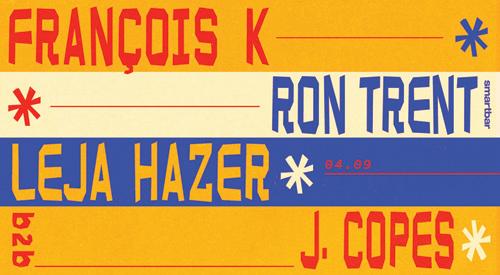




MARCH 31, 2022 - CHICAGO READER 69 AUG 20 MT. JOY AUG 25 JORJA SMITH FLEET FOXES AUG 03 AUG 15 FIRST AID KIT LORD HURON Tickets @ saltshedchicago.com • 1357 N Elston Ave. AUG 13 LAKE STREET DIVE SPECIAL GUEST MADISON CUNNINGHAM SEPT 23 JASON ISBELL AND THE 400 UNIT SPECIAL GUEST SHEMEKIA COPELAND SEPT 22 JASON ISBELL AND THE 400 UNIT SPECIAL GUEST SHEMEKIA COPELAND SHARON VAN ETTEN • ANGEL OLSEN • JULIEN BAKER AUG 10 WITH SPECIAL GUEST SPENCER. ANDREW BIRD IRON & WINE AUG 12 WITH SPECIAL GUEST W. MESHELL NDEGEOCELLO SOLD OUT SOLD OUT SOLD OUT AUG 16 COURTNEY BARNETT w. ALVVAYS & THE BETHS SPECIAL GUEST WILDERADO AUG 21 MT. JOY SPECIAL GUEST WILDERADO 2ND NIGHT ADDED 2ND NIGHT ADDED SOLDOUT SOLD OUT SOLD OUT 3730 N CLARK ST METROCHICAGO.COM @METROCHICAGO SMARTBARCHICAGO.COM 3730 N CLARK ST | 21+ FRIDAY APR 08 SOUL CLAP SHAUN J. WRIGHT FRIDAY APR 01 ZERNELL DUANE POWELL TIM ZAWADA SATURDAY APR 02 DJ SWISHA + KUSH JONES MISS TWINK USA COMPOSURESQUAD TUE APR 12 MOGWAI + Nina Nastasia FRIDAY APR 01 / 7PM / 5+ THE AMITY AFFLICTION + Archetypes Collide + The Seafloor Cinema SATURDAY APR 09 / 7PM / 5+ SLOWTHAI + Jean Dawson THURSDAY APR 14 / 8PM / 5+ 1833 WELCOMES / DALE GAS TOUR SNOW THA PRODUCT MONDAY APR 04 / 7PM / 5+ QROCK 100.7 WELCOMES METRO + KICKSTAND PROD. PRESENTS CODE ORANGE + Loathe / Vended / Dying Wish FRIDAY APR 15 / 7PM / 5+ A BENEFIT FOR CHARLES LEVI FT. STABBING WESTWARD + Combichrist + Chris Connelly / Mark Atkins and more! MON APR 25 PABLLO VITTAR + Alice Longyu Gao NOCTURNA MILD HIGH CLUB KOTA THE FRIEND GANG OF YOUTHS ASHE DAN ANDRIANO DRAGULA ANDY STO @ SLEEPING VILLAGE THE REGRE ES APR 23 APR 28 APR 29 MAY 03 MAY 07 MAY 11 MAY 12 MAY 12 MAY 13 SAT APR 23 BLACK PISTOL FIRE Laid Back | Cold Beer | Live Music @GMANTAVERN GMANTAVERN.COM 3740 N CLARK ST 21+ FRI APR 22 METRO / SMARTBAR + OBSCURE PRESENT MALL GRAB
MUSIC
Find more music listings at chicagoreader.com/musicreviews
battle and then shi on a dime into smooth, tender singing. Vert(EGO) excels because of his fluidity, and when he decides to go big with a pop number—such as “Meantime,” with its house-leaning thump, honeyed vocal hook, and supple funk keys—he’s liable to take out a long lease in your head.
—LEOR GALIL
When I first saw the Linda Lindas perform “Racist, Sexist Boy”—in the May 2021 video from the Los Angeles Public Library that took the Internet by storm—I got huge “industry plant” energy from them. But I wasn’t really mad about it. The four-piece, which is made up of girls between the ages of 11 and 17, have already opened for Bikini Kill, signed to Epitaph, and appeared in a couple of Netflix properties. On the one hand, they may not have had all those same opportunities without their connections: two of the band’s members are daughters of Grammy-winning producer Carlos de la Garza, who’s worked on the most recent releases for Bad Religion (and Bad Religion guitarist Brett Gurewitz founded Epitaph). But on the other hand, even if nepotism helped thrust the Linda Lindas into the spotlight, they’re still a great band who shred on their instruments and write their own songs. Their debut full-length, Growing Up, overflows with youthful charm, and each member’s personality gets equal time in the spotlight. Bassist Eloise Wong is the band’s punk heart, with a perfectly slurred growl that recalls the Muffs’ Kim Shattuck; sisters Lucia and Mila de la Garza harmonize on glorious indiepop melodies; and guitarist Bela Salazar tips her hat to riot-grrrl idols Le Tigre on tracks such as album opener “Oh!” Together or separately, the members of the Linda Lindas have bright futures ahead of them. Their songwriting skills are already amazingly sharp, and whether or not they had more doors opened for them than most bands their age, their music will inspire more adolescents to pick up guitars—and that’s a good thing.
—LUCA
gressive death metal so distinctive and compelling that it’s spawned an entire subgenre of imitators. And right from its title, the Swedish band’s ninth album, Immutable, announces that it won’t try to fix what isn’t broken. The elements Meshuggah have made familiar over the past three decades are all present: pitch-dark riffing in perverse time signatures, against which the occasional clean guitar line stands out like a titanium wire in the cinders of a house fire; rigorous drumming that nails down those knotty meters and chops them up with a backbeat, so that the competing patterns play tug-of-war with your attention; and abrasive, howling vocals that use bizarrely dilated timing to weave through this rhythmic minefield. Over time, the band’s music has grown less human, in that it feels less like a group of metalheads banging something out in a room and more like the output of an incomprehensible computer that generates Meshuggah songs. I once described it as death metal fed through the gears of a colossal alien machine, and for a few albums now, that machine’s moving parts have been getting bigger and heavier, so that their interference patterns are easier to perceive. On Immutable, Meshuggah are o en as minimalist as I’ve ever heard them, not only playing fewer notes but fewer different notes. Some of the new album’s oddly weighted riffs still move like slipping chains or stuttering jackhammers, just like in the old days, but at least as o en they’re anvils tumbling down a hill.
it hard to even pick a tempo for your headbanging. Immutable may just be Meshuggah making the same mistakes over and over—some fans have never forgiven them for abandoning the nervy, organic sound of Destroy Erase Improve decades ago—but they’re brilliant mistakes. —PHILIP MONTORO
Orville Peck, Bronco Columbia orvillepeck.bandcamp.com
CIMARUSTI
Meshuggah,
Immutable
Atomic Fire meshuggah.afr.link/immutableWE
Meshuggah have developed an approach to pro-

Many of the lyrics on Immutable are about deception, folly, the abuse of power, and the limits of knowledge: as guitarist Mårten Hagström puts it in the album’s press materials, “Humanity is immutable, too. We commit the same mistakes over and over.” Fortunately, the music isn’t so abstract—it clamps down on the scruff of your neck and shakes you till you see stars. Meshuggah don’t have the broadest emotional range, but they cover all of it here: fury, frustration, melancholy, regret, tranquility, and the supercharged meditative state created by the tension between option paralysis and ecstatic trance. The drumless instrumental closer, “Past Tense,” is gentle and delicate enough to pass for a sinister lullaby, while “Ligature Marks” drives home the asymmetry between its four-four backbeat and its bludgeoning, irregular one-note chug by landing on each downbeat of the latter with a distorted growl that dips in pitch like a circular saw biting into meat. Downtuned riffs make zigzags that pop out of the mix like revving dirt bikes, a keening clean guitar dri s like an air-raid siren, and all the while thickets of three-against-four syncopation make
When the masked country crooner who performs as Orville Peck dropped his 2019 debut record, Pony (Sub Pop), his decadent baritone and mysterious persona immediately earned him a cult following. Created in the safety of anonymity, his descriptions of heartbreak and loneliness washed over listeners, their intimacy heightened by sparse musical accompaniment. But as quickly as fans were drawn to him, some were just as eager to unmask him, and eventually he was identified as Daniel Pitout of Canadian garage and punk groups Nü Sensae and Eating Out. So it was unsurprising that Peck’s next release, the 2020 EP Show Pony, seemed to withhold itself emotionally even as it ramped up the technical proficiency; it also included a sparkling duet with country megastar Shania Twain. For all its shortcomings, it was exactly what its title implied: the rehearsed pageantry of a rising star hemmed in by his own visibility.

The name of Peck’s latest release, Bronco (Columbia), promises the mature sound of a seasoned musician bucking against the constraints of superstardom, but it fails to approach anything wild or raw. Released in three “chapters”—the first on March 5, the second on March 11, and the last on April 8— Bronco delivers lush productions that borrow from traditional bluegrass, California psych rock, and doo-wop. But as lovely as the album sounds, its tightly layered arrangements drown out what should’ve been its most revealing moments. On “Kalahari Down,” for example, Peck mentions growing up in South Africa just north of Sophiatown (an enclave of Black innovation ravaged by apartheid), but at the same time he leans heavily on the artifice of his cowboy persona and a saccharine violin chart. “Daytona Sand,” a song about a whirlwind road romance, is punctuated by galloping drums that match the frenzied excitement of such a love, but the pop flourishes that round it out distract from the emotional weight it needs—that emotion is more apparent in its frantically campy music video.
One pleasant surprise is album closer “All I Can Say,” a moody duet with former Sub Pop labelmate Bria Salmena that’s obviously influenced by Mazzy Star: it relies on the strength and vulnerability of the singers’ voices, not on muddled musical signifiers. Is Bronco ’s overworked songwriting an inevitable consequence of Peck playing in the big leagues, or proof that he’s at his best when he can keep fans at a distance? Only time will tell. —MICCO
DJ Travella, Mr Mixondo Nyege Nyege Tapes
CAPORALE
nyegenyegetapes.bandcamp.com/album/ mr-mixondo
Tanzanian producer DJ Travella sounds like he’s having the time of his life. The 19-year-old artist specializes in singeli, a frenetic style of dance music that sets raves ablaze in his home country. On April 1 he’s releasing his debut album, Mr Mixondo , on Nyege Nyege Tapes, a label based in Kampala, Uganda, that’s played an important role highlighting producers working in this style, including Sisso, Duke, and Jay Mitta. The record is a nonstop romp, and it establishes its catastrophic tenor within the first few seconds of opener “Crazy Beat Music Umeme 1.” As his rhythms pummel listeners at more than 200 beats per minute, he throws in additional bursts of percussion to sustain the explosive atmosphere. From a distance, it’s easy to appreciate the song as the textural monstrosity it is: its layers of synthesized noise culminate in the aural equivalent of an abstract expressionist painting. But it’s even more thrilling if you lean into its groove and actually dance. There are points at which DJ Travella cuts all noise, but even these momentary silences continue the music’s propulsive motion—they feel like flying through your car’s windshield after hitting a wall. Crucial to the success of Mr Mixondo is that it pulls from musical styles from around the world. “FL Beat,” for example, uses familiar vocal samples that place it in the lineage of Chicago footwork, while “London Bandcamp” slows the tempo down with a dembow rhythm but uses stuttering electronics to keep the song energized. DJ Travella knows how absurd his music can be, and he leans into it on “Chapa Bakola Music Bass,” which sounds like being surrounded by a thousand slot machines, and on “Tambasana,” whose chipmunked vocals render everything cartoonish. Outrageous in the best way possible, Mr Mixondo is party music for only the most hard-core. —JOSHUA
MINSOO KIM v
70 CHICAGO READER - MARCH 31, 2022 ll
The Linda Lindas, Growing Up Epitaph thelindalindas.bandcamp.com/album/growing-up
continued from 68
Meshuggah EDVARD HANSSON AND BRENDAN BALDWIN
Orville Peck JULIA JOHNSON

MARCH 31, 2022 - CHICAGO READER 71 Let’s Play! Make time to learn something new with music and dance classes at Old Town School! We offer flexible schedules for all skill levels both in-person and online. oldtownschool.org Sign up for classes today at MUSIC CLASSES FOR ADULTS & KIDS LINCOLN SQUARE LINCOLN PARK SOUTH LOOP & ONLINE OTS_1_2V_ClassAd_072921.indd 1 7/23/21 2:21 PM
EARLY WARNINGS
No Trigger, Bollweevils, Knoxious 6/16, 8 PM, Reggies Music Joint
Nothing, Nowhere; Poorstacy; Carolesdaughter; Guccihighwaters; Snarls 5/20, 6:30 PM, House of Blues b Jennifer O’Connor, Old Joy, Jessica Risker 5/2, 8:30 PM, Empty Bottle F
Odesza, Sylvan Esso, Elderbrook, Nasaya 9/9, 6:30 PM, Huntington Bank Pavilion b 070 Shake 5/8, 7 PM, House of Blues b 1 800 Pain, Cali Cartier 4/15, 8 PM, Schubas b Or, Gentleman Speaker 4/16, 8 PM, Burlington Ours 4/14, 8 PM, Beat Kitchen, 17+
Out of Space presents Buddy Guy, Todd Park Mohr 8/7, 6 PM, Canal Shores Golf Course, Evanston, 18+
NEW
Airiel, Deserta, Desert Liminal, Shimmer DJs (Scary Lady Sarah and Philly Peroxide)
4/22, 8:30 PM, Sleeping Village
Matt Andersen 5/22, 7 PM, Szold Hall, Old Town School of Folk Music b
Anvil 7/31, 7:30 PM, Reggies Rock Club, 17+
Aunt Kelly, Ripley, Dearlys 4/15, 9 PM, GMan Tavern
Jim Baker, Jakob Heinemann, and Steve Hunt 4/24, 9 PM, Hungry Brain
Bambara, Wombo 5/10, 9 PM, Sleeping Village
Bassjackers 4/16, 10 PM, Prysm Nightclub
Bedouine, Le Ren 4/22-4/23, 8 PM, SPACE, Evanston b
Regina Belle, Kyla Jade 4/16, 5 and 8 PM, City Winery b
William Black 4/22, 8 PM, Chop Shop, 18+
Breizh Amerika Collective 5/25, 8:30 PM, Maurer Hall, Old Town School of Folk Music Fb
The Bridge 4/17, 9 PM, Hungry Brain
Frank Catalano Quartet 4/154/16, 8 PM, Green Mill
CIX 5/7, 7 PM, the Vic b
Daddy Yankee 9/4, 7 PM, Allstate Arena, Rosemont b
Darts, Mystery Actions, Rumours 5/28, 10 PM, Liar’s Club
Dear Hunter, the World Is a Beautiful Place and I Am No Longer Afraid to Die 8/21, 7:30 PM, Metro, 18+
Deeper, Sports Boyfriend 4/16, 9:30 PM, Hideout
Iris DeMent, Ana Egge 5/26, 7:30 PM, SPACE, Evanston b
Dirty Heads, Soja, Tribal Seeds, Elovaters 8/12, 6 PM, Radius Chicago b
Don Li ed, Sydny August 4/16, 9 PM, Schubas, 18+
Ed Schrader’s Music Beat, CB Radio Gorgeous 4/16, 8:30 PM, Empty Bottle
Elder, Belzebong, Dreadnought 9/3, 7:30 PM, Reggies Rock Club, 17+
Elephant Lore, Tuckers, B.lake 4/15, 9 PM, Reggies Music
Joint
Eliane Elias 4/14, 8 PM, City Winery b
Ergs, Copyrights, Chinese Telephones 6/23, 8 PM, Cobra Lounge, 17+
Lee Fields, Kendra Morris 4/22, 8:30 PM, Thalia Hall, 17+
Florence & the Machine, Sam Fender 9/7, 8 PM, Huntington Bank Pavilion b
Gaslight Anthem, Tigers Jaw 9/26, 8 PM, Riviera Theatre, 18+
Layton Giordani, Hiroko Yamamura 4/15, 10 PM, Spy Bar Jennifer Hall 4/26, 8 PM, Golden Dagger
Caleb Hawley, Violet Nines 5/14, 8 PM, Golden Dagger
Helen Money, Eli Winter, Sam Wagster 4/19, 9 PM, Sleeping Village
Erwin Helfer 4/14, 6 PM, Hideout Herbsaint 4/22, 9 PM, Hungry Brain
Haley Heynderickx, Matt Dorrien 4/14, 8:30 PM, Constellation
Peter Hook & the Light 8/198/20, 8 PM, Metro, 18+
Imagine Dragons, Macklemore, Kings Elliot 8/26, 6:30 PM, Hollywood Casino Amphitheatre, Tinley Park b Aya Ito 4/14, 9 PM, Tack Room F
Jantsen, Smoakland, Jon Casey, Superave 4/16, 9 PM, Chop Shop, 18+ Jillie 4/15, 9 PM, Tack Room F
Joeboy 5/13, 8 PM, Park West b
Josh K 5/27, 7 PM, the Promontory Keshi 6/1, 7 PM, House of Blues b
Kowloon Walled City, Rid of Me, Virgin Mother, Lume 4/16, 8 PM, Beat Kitchen b
Jim Lauderdale 4/14, 8:30 PM, FitzGerald’s, Berwyn b
Jonah Leatherman Band, Vulgar Commons, Irish Marlowe, Lex Alley Project 6/3, 8 PM, Burlington
Led Zeppelin 2 4/16, 7 and 10 PM, FitzGerald’s, Berwyn Leonora, Lung, Paige Beller 4/17, 8 PM, GMan Tavern
Lowest Pair 4/15, 8 PM, Hideout
Lucky Boys Confusion 5/27, 8 PM, Bottom Lounge, 17+ Lykke Li 10/4, 7:30 PM, the Vic, 18+
Marsh 4/15, 10 PM, Prysm Nightclub
Matrixxman, Justin Aulis Long, Jaq Attaque 4/29, 10 PM, Smart Bar
Mndsgn, Frank Leone 4/15, 10 PM, Empty Bottle
Elizabeth Moen, Lucky Cloud 4/16, 9 PM, Lincoln Hall, 18+
Ricky Montgomery, Lyn Lapid 5/13, 7 PM, House of Blues b
Moonchild 4/21, 8 PM, Thalia Hall, 17+
Motion City Soundtrack, All Get Out, Neil Rubenstein 6/7, 7 PM, House of Blues, 17+
Mssv, Mute Duo & Quintet 4/14, 8:30 PM, Empty Bottle
Mz Worthy, Dom Brown, Morgan Alexis 4/23, 10 PM, Spy Bar
Mzz Reese & Her Pieces 4/21, 8:30 PM, FitzGerald’s, Berwyn Nervo 4/23, 10 PM, Prysm Nightclub
NLE Choppa, Scorey 5/31, 8 PM, Avondale Music Hall b
Out of Space presents Elvis Costello & the Imposters, Nick Lowe & Los Straitjackets 8/5, 7 PM, Canal Shores Golf Course, Evanston, 18+ Out of Space presents Jenny Lewis, Trampled by Turtles 8/4, 6:30 PM, Canal Shores Golf Course, Evanston, 18+ Out of Space presents Lucinda Williams, Waxahatchee, Liam Kazar 8/6, 6 PM, Canal Shores Golf Course, Evanston, 18+ Pachanga featuring Sonora Dinamita, Grupo Vanguardia, Inizial, performers from the Collaborative Institute of Cultural Arts, Pachanga DJs 4/20, 8 PM, Thalia Hall Palms 5/1, 8:30 PM, Empty Bottle
Willy Porter Band 10/16, 8 PM, SPACE, Evanston b Prize Horse, Ridgeway, Habitats, Daybreaker 4/15, 6 PM, Subterranean, 17+ Psychedelic Furs, X 7/23, 8 PM, Aragon Ballroom, 17+ Q-Tip Bandits, Weekend Run Club, August Hotel 4/17, 7 PM, Cobra Lounge b Loura Rain, Harmonica Hinds 4/14, 5:30 PM, Buddy Guy’s Legends Rav, Kill Bill, Scuare, Airospace 4/18, 8 PM, Subterranean, 17+ Rhea the Second, Demetruest, Soh Darling 5/27, 8 PM, Golden Dagger
Henry Rollins (talking show) 4/17-4/18, 8 PM, Thalia Hall, 17+

Daniel Rossen 4/14, 8:30 PM, Lincoln Hall, 18+ Sainte Vie, Hummingbird, Zooday 4/16, 10 PM, Spy Bar
Salt Sweat Sugar, Dashboard Professional 4/15, 8 PM, Cobra Lounge, 17+ Tiwa Savage 6/9, 8 PM, the Promontory b Schizophonics, Rebel Queens, Evictions 4/23, 9:30 PM, Liar’s Club
b ALL AGES F
Never miss a show again. Sign up for the newsletter at chicagoreader. com/early
DJ Joe Shanahan 4/16, 3 PM, GMan Tavern F Sherelle, Ariel Zetina, Josh Maj 4/15, 10 PM, Smart Bar Shortly, Ally Evenson, Fran, Colleen Dow 4/15, 8 PM, Beat Kitchen, 17+
Si Dios Quiere, Snuffed, Habitats, Payasa 4/16, 8 PM, Subterranean, 17+ Terrance Simien & the Zydeco Experience 4/15, 8 PM, SPACE, Evanston b Sleigh Bells 8/5, 8 PM, Metro, 18+
So Kill, Alien Boy, Topographies, French Police 4/15, 9 PM, Lincoln Hall, 18+ Sonicsoul Band 4/29, 9 PM, Rosa’s Lounge
Jon Spencer & the Hitmakers, Quasi 4/14, 8 PM, Schubas Spring Awakening Music Festival 7/8-7/10, United Center, 18+ Streetlight Manifesto 11/18, 8 PM, Radius Chicago b Stuck, Pardoner 4/25, 8:30 PM, Sleeping Village Craig Taborn 4/15, 8:30 PM, Constellation Terror, Kublai Khan, Never Ending Game, Sanguisugabogg, Pain of Truth 5/21, 7 PM, Bottom Lounge, 17+ Tropa Magica, Gambacho 4/19, 8 PM, Cobra Lounge, 17+ 2Baba 5/14, 11 PM, the Promontory Elle Varner, DJ Aktive 4/15, 7 and 10 PM, City Winery b Leon Vynehall 4/22, 10 PM, Smart Bar
Waipuna 5/18, 8:30 PM, Szold Hall, Old Town School of Folk Music Fb Warhawks, Party’z, Brian Mietz 4/26, 9 PM, Burlington Weedeater, Rebelmatic, Adam Faucett 4/15, 8 PM, Chop Shop, 18+
UPDATED
Allie X 4/21, 7:30 PM, Park West, canceled
Front Line Assembly, Rein, Choke Chain 5/14, 9 PM, Metro, lineup updated, 18+ Fuzz, Bitchin Bajas 4/19, 8:30 PM, Thalia Hall, lineup updated, 17+
Smashed Plastic third anniversary celebration featuring Eleventh Dream Day, BCMC (Bill MacKay and Cooper Crain), Half Gringa, Plastic Love DJs 4/23, 8 PM, Sleeping Village, lineup updated v
GOSSIP WOLF
A furry ear to the ground of the local music scene
LEGENDARY CHICAGO jazz guitarist George Freeman has been honing his dynamic, explosive style since the 1940s, working with dozens of the genre’s hall of famers, including Charlie Parker, Richard “Groove” Holmes, Gene Ammons, Jimmy McGriff, Buddy Rich, Shirley Scott, and his brothers Von and Bruz Freeman. On Sunday, April 10, Freeman turns 95, and to mark the occasion, local label Southport Records will drop Everybody Say Yeah! , a set of favorites and rarities from its archives. The tracks span 26 years, and the 19 ace backing players involved include drummer Hamid Drake, harmonica player Billy Branch, and two of the guitarist’s relatives: Von and his saxophonist son, Chico Freeman. Eleven of the 14 cuts are Freeman originals, and among the standouts is a new version of his ballad “Perfume”—a highlight when Gossip Wolf saw him at the Green Mill in 2019.
In February, Reader contributor Steve Krakow reviewed Here Comes the Sunset, the new album by everything-but-thekitchen-sink prog-rock weirdos CheerAccident , in the process anointing them “one of the greatest, most challenging, and most fun bands that Chicago has ever produced.” On Friday, April 15, CheerAccident celebrate with a streamed performance from the basement where they rehearse, hosted on the Bandcamp page of Skin Gra Records. Tickets to “attend” are $10, and the label promises a professional shoot with multiple cameras, plus some “pre-recorded surprises.” The band are notorious for their oddball onstage high jinks, so this wolf is eager to tune in!
Last time Gossip Wolf checked in with Strawberry Jacuzzi guitarist Shannon Candy , she was about to drop her solo debut in November 2020. The irreverent bubblegum dance-punk on that album, So Long , hooked Italian label Aua Records : it just issued two of the LP’s tracks, “Well Actually” and “Gimme Liberty,” on a seven-inch for its Lo-Fi Mono Single Club!
—J.R. NELSON AND LEOR GALIL
Got a tip? Tweet @Gossip_Wolf or e-mail gossipwolf@chicagoreader.com.

72 CHICAGO READER - MARCH 31, 2022 ll
Henry Rollins COURTESY THE ARTIST
CHICAGO SHOWS YOU SHOULD KNOW ABOUT IN THE WEEKS TO COME
WOLF BY KEITH HERZIK























MARCH 31, 2022 - CHICAGO READER 73 LIVE MUSIC IN URBAN WINE COUNTRY 1200 RANDOLPH STREET, CHICAGO, IL 60607 | 312.733.WINE don’t miss... Coming Soon... NRBQ 4.07 Elvin Bishop 4.06 Regina Belle with Kyla Jade Jonatha Brooke 4.19 4.16 4.4 THE HAMILTONES 4.5 COLIN PETERIK WITH THE DEVONNS 4.84.10 WILL DOWNING 4.11 BRENDAN BAYLISS OF UMPHREY’S MCGEE 4.1 NICK WATERHOUSE WITH MCKINLEY JAMES 4.2 CHICAGO FARMER & THE FIELDNOTES WITH BARBARO 4.3 GREAT MOMENTS IN VINYL PLAYS THE ROLLING STONES - 12 PM 4.3 SOUL MUSIC CELEBRATION THE BIRTH OF SOUL 4.12 RODNEY ATKINS & ROSE FALCON 4.13 BILLY PRINE & THE PRINE TIME BAND: SONGS OF JOHN PRINE 4.14 ELIANE ELIAS 4.15 ELLE VARNER WITH DJ AKTIVE 4.17 4.18 JUSTIN FURSTENFELD OF BLUE OCTOBER 4.20 THE QUEBE SISTERS 4.21 THE CLAUDETTES WITH BETH BOMBARA 4.22 MELANIE FIONA 4.24 ARI HEST WITH SARAH MARIE YOUNG 4.25 4.26 CANDLEBOX 4.27 IDES OF MARCH 4.28 4.29 ALAN DOYLE WITH CHRIS TRAPPER 5.1 MIDNIGHT SUN 5.2 CECE PENISTON Dame Jane Glover leads Bach’s imaginative Easter Oratorio, a journey from a cavern’s darkness into the magnificent light of heaven. Also featured—Bach’s “Komm, Jesu, komm” & music by Buxtehude & Purcell. Yulia Van Doren, soprano; Elizabeth DeShong, mezzo-soprano James Gilchrist, tenor; Michael Sumuel, bass-baritone TICKETS START AT $20 | baroque.org/easter CHORUS & ORCHESTRA EASTER ORATORIO Apr 10, 7:30pm North Shore Center, Skokie Apr 11, 7:30pm Harris Theater, Chicago 4 / 19 @ Reggies 4 / 8 @ Reggies 4 / 30 @ Joe’s on Weed St. Stick Men RICHIE RAMONE David Nail
SAVAGE LOVE
Forever vs. now
Plus, catching feelings for a polysaturated partner
BY DAN SAVAGE
Q : I’m a 28-year-old queer woman. It’s been a while since I’ve been in a relationship, as it was impossible for me to make a physical or emotional connection with anyone after I was raped four years ago. I finally found a very, very, very nice fella. He’s 36 years old and pretty basic. He’s a cis white man who isn’t into anal, which is good, not too good at oral, which is bad, with a medium-to-low sex drive and an average-to-good cock. Here’s the problem: I like the warm feelings of love and lust I’m finally experiencing after a long time, but I am nevertheless unsatisfied with him. There are so many things that I feel he is lacking. We don’t share fantasies, he doesn’t take the initiative, there’s no sense of seductiveness, and the cunnilingus is underwhelming. I’ve talked to him about it and he listens, he says he hears me,
but he does not implement any of my suggestions. Instead, he tells me to focus on the things that are wonderful about our relationship rather than what’s lacking. Maybe I’m being too critical and should try to focus on the positive. Or should I leave him and go find an idealized sex God who may or may not be out there?
about this and talking to your psychologist. You can talk to both of us.
to that question is obviously no. If you were with this guy forever—if you married a guy who wasn’t that great in bed and refused to listen to feedback and make changes—you would be unhappy in the long run. You’d never get to act on those fantasies, you’d never get seduced the way you want, you’d never get eaten the way you want. But if instead of asking yourself, “Is he the right guy forever?”, you were to ask yourself, “Is he the right guy for now?”, the answer might be different.
You had a traumatic experience four years ago and haven’t dated anyone since. Easing back into sex, dating, and relationships with a nice fella who isn’t great but isn’t awful . . . yeah, that might be just what you need. Not forever, IDK, for now
with me. Now that winter is ending, I’m about to go back and start working near him again. I talked to him recently, and he is eager to keep hooking up, but he made it clear—again—that he doesn’t want more than that. I feel conflicted because while I really want to keep having sex with this guy, I’m scared of getting hurt. Even if I go in with the intention of having casual sex, there’s a chance I might fall in love with him, and he has made it clear that he doesn’t want to be with me. Do you have any suggestions for how I can enjoy this guy and the great sex without getting too attached? —CONSTANTLY AMAZING SEX, UNWILLING ABOUT LOVE
a: Nope.
So, don’t move in with this guy, don’t make any promises, and don’t stay in this relationship one minute longer than you want to. When you’re ready to end it—when you’re ready to go searching for an idealized sex God— then you can and should end it. You’re not going to have a successful long-term relationship with this guy, IDK, but you could have a successful short-term relationship with him.
—I
DEALIZED DICK KATHARSIS
P.S. My question requires a thoughtful response, not a savage answer. So, maybe I should talk to my psychologist and not to you?
a: First and most importantly, I’m so sorry you were raped. I’m glad you sought professional help, IDK, and I’m happy to hear you feel ready to start making connections again after taking four years off to heal. And I’m gonna go out on a limb here to say you don’t have to choose between talking with me
Zooming out for a second, I’ve always thought of this column (and my podcast) as a conversation I’m having with friends about our love and/ or sex lives after we’d had a few drinks. (Or, these days, shared an edible.) Friends are there to listen, to challenge us, and to call us on our bullshit. And friends are there to be heard, to be challenged, and to be called on their bullshit. But friends aren’t pros. When it comes to the kind of trauma you experienced, ideally, we would seek help from a pro and—when we were ready for it—advice from our friends.

And as your supportive friend, IDK, as your thoughtful friend, I would advise you to stop thinking forever and instead concentrate on now Basically, IDK, you’re looking at this guy and asking yourself, “Is he the right guy forever?” And the answer
Welcome back to sex and dating, take care of yourself, and feel free to write me anytime.
Q: I’m a 32-year-old poly woman in Canada. Last spring and summer I worked a contract job a few hours away from where I live, and I was hooking up with one of my coworkers who is a 40-year-old poly man. He’s great and we had great sex. When I started to have more romantic feelings for him, he made it clear that he was polysaturated and didn’t want to be in a relationship
Catching feelings for someone isn’t a conscious choice we make, CASUAL, and typically by the time we start worrying we might be catching feelings for someone . . . it’s too late. Feelings have already been caught. The only thing we can do if we’re worried that we might catch feelings for someone or have already caught feelings for someone is to stop seeing that person, CASUAL, in the hopes that their absence (or someone else’s presence) will make those feelings go away. But if the sex is great and the risk of heartbreak is worth it, no one would blame you for continuing to fuck this polysaturated guy. (Funny he can find the time to fuck you on the regular, but doesn’t have the bandwidth to date you, not even a little bit.) But go in with your eyes open: if you keep fucking this guy, CASUAL, you’re gonna get more and more attached to him, you’re gonna catch more and more feelings, and then wind up getting hurt in the end.
spot-on; however, your advice to TITE last week— the man who wanted to end things with his FWB—was not good. You encouraged TITE to lie to their fuck buddy by saying that their partner wants to close things up. That’s terrible advice. Not the lying, Dan, but the blaming it on the partner. First of all, that lie makes the partner the villain even though they had no part in this, so TITE is lying to one person and lying about another! Second, it’s just setting everyone up to get bitten in the ass—and not in the good way. Suppose TITE is out sometime with someone other than his partner and his former fuck buddy happens to see him? I get wanting to spare someone’s feelings, but at some point we have to take responsibility for our relationships, including the ending of them. Using, “Oh, my partner wants to close things up” is the ENM [ethical non-monogamy] version of a woman saying, “I have a boyfriend” to get some guy to stop harassing her (except in that case it is sometimes necessary for safety). Now, if TITE wants to get their partner’s permission to use them as an excuse, at least then they’re not lying to two people. But really, isn’t a better solution to have clear and honest communication and treat everyone as an adult?
—COMMUNICATE HONESTLY AND TACTFULLY
a: They can’t all be winners. So, to you and everyone else who wrote to tell me my advice for TITE was off the mark, CHAT, I wanna say: you guys were right, I was wrong. Thanks for calling me on my bullshit, friends. v
Q: I enjoy your column and I think your advice is usually
Send letters to mail@ savagelove.net. Download the Savage Lovecast every Tuesday at thestranger.com.
@fakedansavage
74 CHICAGO READER - MARCH 31, 2022 ll
OPINION
JOE NEWTON
























































































































































MARCH 31, 2022 - CHICAGO READER 75 SCAN HERE CBD PAIN RELIEF CREAM GREAT FOR: BACKACHES ARTHRITIS MUSCLE ACHES The relief you need exactly where you need it most. USE CODE: PAIN & get 3 FREE Gifts greencbdtoday.com/reader 331661_4.75_x_4.75.indd 1 2/23/22 12:37 PM Visit www.squirt.org today to join the action Where ALL GUYS come together Where ALL GUYS come together
JOBS
Northwestern Memorial Healthcare seeks Sr. Medical Lab Scientists for Chicago, IL. Bachelor’s in Med Tech/Med Lab Sci/Clinical Lab Sci/ Chem/Bio/Allied Health qualifying applicant for ASCP certification exam. Req’d Skills: 2yrs clinical lab exp. Edu/exp must incl hematology. Requires general MLS or MT (ASCP) cert or eligible. Must be ASCP certified within 1yr of employment. Background check & drug test required. Must be willing to work 3rd shift. Apply online: http:// jobseeker.nm.org/ Requisition ID: 5702
Chicago’s First Lady Cruises has a rare opening for FT or PT 100 ton Great Lakes Captain. Days and/or Evenings, beautiful vessels and nice people to work with. We have a full engineering team-no mechanical skills necessary. Supplement your income or make it a careerwelcome aboard. Jobs@ CruiseChicago.com
Bookkeeper (job site: Chicago, IL) Send resumes to Amin Fazel, Windy City Restaurant Management, LLC, 120 S. State St., Lower Level, Chicago, IL 60603; or email to aminf@fdngroup. com.

BIM/VDC Engineer (Master’s with 3 yrs exp or Bachelor’s with 5 yrs exp; Majors: Architecture, Advanced Architectural Design, or equivalent)Chicago, IL. Job entails working with & reqs exp incl: Building customized digital tools for modeling, automation, & documentation, & for data harvesting on BIM360 & cloud platforms using JavaScript & Python; elevating firmwide BIM standards & templates; managing & QA/QC for BIM Revit models; using C# on Revit; BIM Revit standards development, implementation, & enforcement; & coordinating with global teams on project design & data. Relocation & travel to unanticipated locations within USA possible. Send resumes to VIATechnik LLC, Attn: HR, 1500 West Carroll Ave, 5th Floor, Chicago, IL 60607.
Meltzer Real Estate LLC seeks Accountant in Chicago, IL to assist the firm’s Property Accountant in managing accounts. If interested send cvr ltr & resume to: admin@meltzerre. com Subject line: Ref# Acct113
TransUnion, LLC seeks Senior Analysts- Analytics for Chicago, IL location to apply analytics to data to describe, predict & improve business performance. Master’s in Statistics/Analytics/ related field +2yrs exp or Bachelor’s in Statistics/ Analytics/related field +5yrs exp req’d. Req’d skills: Python, R, Hive, SQL, D3, Tableau, Git, Spark Hadoop, Machine Learning, Database Eng, Image Recognition, Optimization, Text Mining, Research & Statistical Study Design. Send resume to: A. Goodpasture, REF: YZ, 555 W Adams St, Chicago, IL 60661.
Systems Engineer; Great Computer Solutions, Inc. Jobs loc in Skokie, IL & var unanticpt locs t/o U.S. Mnitor & mnge all installed systs & infrastructure. Est, config, test & maint op systs, app s/ware & syst mngmnt tools. Eval existing systs & prvde tech direction to IT support staff. Plan & impl systs auto as req’d for better efficiency. Timely rprting on the log sheet for the rapid resp to any glitches. Trav/relo to var unanticpt locs t/o U.S. for l/t & s/t assigns. Reqs Bachelor’s or frgn equivt in Comp Sci, Engng (any), Bus Admin, Mngmnt, or rel. Will also accept 2 yrs of exp in job offered or as a Comp S/ware Prof’l in lieu of Bachelor’s degree. Mail res w/h cover letter to Great Computer Solutions, Inc., 5152 Main Street, Skokie, IL 60077; Job 21GCS03; EOE
Experienced/aggressive telephone closers needed now to sell ad space for Chicago’s oldest newspaper rep firm. Immediate openings in Loop office. Salary + commission. 312-368-4884.
Unitas Global LLC seeks Senior Vice President, Software Engineering to collaborate with management team and internal business customers to define software engineering roadmap to support business goals. Travel: 5% domestic travel required. Worksite: Chicago, IL and various unanticipated worksites throughout the US. Send resumes by mail to Unitas Global LLC, 910 W Van Buren St., Suite 610, Chicago, IL 60607.
Small Loop firm desires part time staff support/ reception. Bilingual preferred. MWF $18 per hour. Send resume to ratown@comcast.net.
DePaul University seeks Intermediate ERP Business/Analyst Developers for Chicago, IL location to analyze and design ERP sw applications in client/server + web-based enterprise application environment. Bachelor’s in Comp Sci, Info Sys/Tech or Computer/Computational or related field (or Computational Finance + 5 Comp Sci courses) + 3 yrs exp req’d. Skills req’d: Exp in higher edu environment analyzing, designing, testing ERP, including SDLC, PeopleSoft sw apps, PeopleSoft data mining, working w/ customers to analyze req’s, Oracle Server, SQL, Application Engine, .NET, JSON, web service integrations, HTML, XML, XSLT, CSS, UI Design, PL/SQL, Visual Studio, C#, SQR, COBOL. Send resume to: Ikeer Savage, 55 East Jackson, 7th floor, Chicago, IL 60604
Incontext Solutions Inc in Chicago, IL seeks a Senior Software Engineer to research current depth sensing and photogrammetry techniques for automated 3D content creation. No trvl; WFH. Email Cv: talent@ incontextsolutions.com
Kraft Heinz Foods Company seeks Manager, Data Visualization COE Analytics to work in Chicago, IL & be responsible for driving the use of data visualization tools and serving as focal point for Data Visualization and end user training. Degree & commensurate exp. req’d. Apply online by searching R-52427 at https://careers.kraftheinz. com/careers
Groupon, Inc. is seeking a Software Development Engineer, Android in Chicago, IL w/ the following responsibilities: Analyze, design, program, debug, & modify software enhancements &/or new products used in local, networked, cloud-based or Internet-related computer programs. Apply at www. grouponcareers.com by searching keyword R26488
Groupon, Inc. is seeking a Software Development Engineer III in Chicago, IL w/ the following responsibilities: Architect, design & implement rich experience for the Groupon Deal pages by utilizing advanced specialized knowledge of Groupon’s I-Tier framework & Optimize tool. Up to 100% telecommuting allowed. Apply at www. grouponcareers.com by searching keyword R26501
The College of Medicine, Offc. of the Dean, at the Univ of IL at Chicago (UIC), located in a large metropolitan area, is seeking a fulltime Associate Director, Clinical Strategy, Analysis, & Practice to assist the department with the following responsibilities: Under direction and supervision, utilize methods, studies, and analyses to identify, develop, and interpret existing clinical operations and external state budget and legislative changes, which will assist senior leadership with decision-making and policy formulation; Assist department to develop, guide, and ensure the completion of studies designed to improve clinical performance; Present actionable results in an understandable and compelling manner customized to the audience; Analyze academic ranking systems to identify key drivers of the score and design strategies to improve performance; Review upcoming physicians’ quality initiative models, identify gaps in current practice and develop strategies to increase the likelihood of receiving incentive payments and avoidance of penalties; Evaluate complex revenue models, develop an evaluation template and a set of recommendations as to the most effective strategy; Analyze national databases in order to improve productivity, revenue cycle performance, and quality of services; Work directly with senior leadership to design and perform more complex analyses, database design development, and report creation; Analyze ways to approach federal quality reporting systems; Analyze departmental performance metrics; Develop data acquisition strategies that enables evidenced-based policy making; Utilize variety of tools to design customer specific reports by integrating data from clinical system, financial system, and administrative system; Perform other related duties and participate in special projects as assigned. No travel is required for this position. This position minimally requires a Master’s degree or its foreign equivalent in Business Administration, Healthcare Administration, or closely related field of study, as well as one year of data management/analyst work experience either in an academic medical center or with any customers operating as an academic medical center or teaching hospital. For fullest consideration,
please submit CV, cvr ltr, & 3 references by 4/19/22 to Nicholas Kane, Office of the Dean, Univ of IL at Chicago, 1853 West Polk Street Chicago IL 60612 or via email to nkane@ uic.edu. UIC is an Equal Opportunity, Affirmative Action employer. Minorities, women, veterans, & individuals w/ disabilities are encouraged to apply. UIC may conduct background checks on all job candidates upon acceptance of a contingent offer letter. Background checks will be performed in compliance with the Fair Credit Reporting Act. University of Illinois faculty, staff and students are required to be fully vaccinated against COVID-19. If you are not able to receive the vaccine for medical or religious reasons, you may seek approval for an exemption in accordance with applicable University processes.
Scientific Market Analyst (US) – Maintain opinion leader network; support Neurosurgeon/ Radiation Oncology user list for US market; support clinician speaker relationships; maintain database on radiosurgery programs; maintain Novalis® product webpage, initiatives, natl/internatl meetings, conferences; clinical liaison for patient marketing; collate global input from biz regions/stakeholders; devel internal comms intended to filter clinical data into relevant formats; workshops, trade shows, conferences; report trends to marketing; devel relations w/ R&D, marketing; support regions/ units w/ research; deliver sales material specializing in scientific proof; publication of studies. 80% natl/internatl travel. Home worksite avail (near major airport). Reqd: 5 yrs exp w/ stat analysis & programming languages; sales/clinical marketing in healthcare indust; & neuro-oncology, incl Neurosurgical/ Radiosurgical apps. Exp may be concurrent. Must have perm US work auth. Contact N. Bandukwala, HR, Brainlab, Inc., 5 Westbrook Corp. Ctr., Ste. 1000, Westchester, IL 60154.
Attorney, Real Estate (Chicago, IL) Represent private equity firms, investment firms, public REITs, developers, indiv. investors in complex corporate real estate transactions, incl. acquisitions, sales, mortgage financing, mezzanine financing, bridge loan financing, construction loan financing, joint ventures, loan purchases & assumptions, bank
& bond transactions. Prepare & negot. primary transact. doc., incl. purchase & sale agr., JV agr., deeds in lieu of foreclosure, operating leases. Review & negot. terms & cond. of financing doc. w/ mortg. & mezz. lenders. Req’mts: JD or foreign equiv., IL Bar, 3 yrs exp in position or 3 yrs alt occup exp in complex corporate real estate transactional legal duties. In lieu of JD or foreign equiv., an LLM or foreign equiv. is acceptable.
Email resume/ref’s to Julie.Hammond@lw.com. Latham & Watkins LLP.
RESEARCH
Have you had an unwanted sexual experience since age 18? Did you tell someone in your life about it who is also willing to participate?
Women ages 18+ who have someone else in their life they told about their experience also willing to participate will be paid to complete a confidential online research survey for the Women’s Dyadic Support Study.
Contact Dr. Sarah Ullman of the University of Illinois at Chicago, Criminology, Law, & Justice Department at ForWomen@ uic.edu, 312-996-5508. Protocol #2021-0019.
RENTALS
1506 Hudson 1st Floor 3 bedroom. 2 bath, kitchen appliances including microwave and dishwasher. Washer/dryer in unit. Central air and heat. No pets. Tenant pays Gas and electric. $2400 monthly; $3600 deposit. 773.255.6988, 312.343.0449
PROFESSIONALS & SERVICES
CLEANING SERVICES
CHESTNUT ORGANIZING AND CLEANING SERVICES: especially for people who need an organizing service because of depression, elderly, physical or mental challenges or other causes for your home’s clutter, disorganization, dysfunction, etc. We can organize for the downsizing of your current possessions to more easily move into a smaller home. With your help, we can help to organize your move. We can organize and clean for the deceased in lieu of having the bereaved needing to do the preparation to sell or rent the deceased’s home. We are absolutely not judgmental; we’ve seen and done “worse” than your job assignment. With your help, can we please help you? Chestnut Cleaning Service: 312-332-5575. www. ChestnutCleaning.com
Danielle’s Lip Service, Erotic Phone Chat. 24/7.
76 CHICAGO READER - MARCH 31, 2022 ll
ADULT SERVICES
Must be
Credit/ Debit Cards Accepted. All Fetishes and Fantasies
Personal, Private
Discrete.
SECURE, QUIET & EXTRA CLEAN7-STORY BUILDING ❐ Loyola University ❐ Thorndale Beach ❐ Whole Foods ❐ Mia Francesca – all steps away! $825 – $860 rent / 1ST month ½ price! $275 move-in fee / no security deposit STUDIOS AVAILABLE! ❐ Heat & Electric FREE ❐ Laundry Room ❐ Bike Storage ❐ Furnished Lobby w/ Secured Entry & FREE WIFI ❐ On-Site Engineer ❐ Cats OK FOR MORE INFORMATION (773) 396-6785 ✶ AffordableKenmoreAffordableEdgewater.com CLASSIFIEDS JOBS ADMINISTRATIVE SALES & MARKETING GENERAL REAL ESTATE RENTALS FOR SALE NON-RESIDENTIAL PROFESSIONALS & SERVICES CLEANING RESEARCH ADULT SERVICES WANT TO ADD A LISTING TO OUR CLASSIFIEDS? Email details to classified-ads@chicagoreader.com
21+.
Are Welcomed.
and
773-935-4995








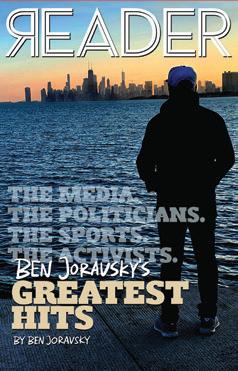




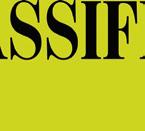
MARCH 31, 2022 - CHICAGO READER 77 e Chicago Reader is now biweekly More than 60,000 copies will be available at nearly 1,200 locations across the city and suburbs. Find one near you and/or download the current issue: chicagoreader.com/map Upcoming Issues: Cannabis Conversations The Sound Issue Pride Issue/WCT Insert Summer Theater/Arts Preview Cannabis Conversations Food & Drink Issue Apr. 14, 2022 Apr. 28, 2022 May 12, 2022 May 26, 2022 June, 9, 2022 June 23, 2022 July 7, 2022 July 21, 2022 235 pages / perfect bound / 5.5” x 8.5” size Available in paperback and PDF download chicagoreader.com/store Ben Joravsky’s Greatest Hits is a collection of profiles and features hand-picked by Ben from his 40 years of writing for the Reader. Each article offers a distinctive portrait of an activist, politician, writer, or sports personality who has left an indelible imprint on Chicago. chicagoreader.com/classifieds Reach local buyers and find what you’re looking for anytime, anywhere.
































78 CHICAGO READER - MARCH 31, 2022 ll Outside Noise Reduction Keeps Bugs & Spiders Out Reduce or Eliminate Fog & Water Noise from Outside? Visit stormsnaps.com or noisewindows.com sales@stormsnaps.com Alpina Manufacturing, Chicago, IL 1-800-915-2828 Soundproofing Window Inserts the platform The Chicago Reader Guide to Business and Professional Services To advertise, email ads@chicagoreader.com home improvement legal books Fun, Clean, Picture Frame assembly JOB $18/hour Tired or bored of clicking away on a keyboard working at home? Keep your hands and mind busy with a fun, safe, clean assembly job. You’d have your own large assembly zone, at least 15-20 feet away from others, so we’re really safe here. Top rated rm Alpina Manufacturing LLC founded in 1992 Beautiful campus in Galewood, near Mars candy, 3 blocks north of Oak Park. We build and sell display framing systems to customers nationwide including Wal-Mart, Verizon, Circle K gas stations, Hospitals. Full time, Part time, Flex hours for working parents or students. We train, no travel, work in Galewood. Open to any backgrounds. Excellent pay, friendly caring management. Stop in anytime between 7am and 4pm M-F ask for Izzy to apply and check us out. Alpina Manufacturing 6460 W Cortland St., Chicago, IL 60707 business consulting entertainment Brigi e Schmidt Bell, P.C. 847-733-0933 lawyers@bsbpc.com Brigi eBell.com Brigi eSchmidtBellPC Considering Divorce? We Can Help. Collaborative | Prenuptual Divorce | Mediation insurance services health and wellness YOUR AD HERE dance JOIN US! WWW GECHAMBER COM shop local 5301N.ClarkSt.Fl.2 CHICAGODANCESUPPLY.COM 773-728-5344 A Matter of Consequences by Michael W. Falls Available on Amazon and Booklocker A Classic Chicago Mystery Customized Massage Therapy, Intuitive Energy Work, and Holistic Talk Therapy 2514 W Armitage Ave, Suite 211 Chicago, IL 60647 773-697-9278 www.intuithealing.com th+f 11am-8pm sat 9am-5:30pm sun 10am-6pm mon 11am-6pm BY APPOINTMENT ONLY your heading here



























MARCH 31, 2022 - CHICAGO READER 79 Become a Published Author with Dorrance. We want to read your book! Trusted by authors for nearly 100 years, Dorrance has made countless authors’ dreams come true. Complete Book Publishing Services FIVE EASY STEPS TO PUBLICATION: 1. Consultation 2. Book Production 3. Promotion 4. Distribution 5. Merchandising and Fulfillment Our staff is made up of writers, just like you. We are dedicated to making publishing dreams come true. Call now to receive your FREE Author’s Guide 844-625-0186 or www.dorranceinfo.com/reader the cannabis platform a Reader resource for the canna curious www.neuromedici.com 312-772-2313 Findouttoday ifmedical cannabisorinfusiontherapyis rightforyou.Telemedavailable! Yourpartnersinhealthandwellness. Serving medical cannabis patients since 2015. To advertise, email ads@chicagoreader.com CBD / cannabis recipes, psychedelic drawings to color, word puzzles to stimulate your brain, growing tips, and more! chicagoreader.com/420book The Budrista platform is a cannabis industry and lifestyle project. Its purpose is to support the healthy and balanced lifestyle of cannabis industry workers. Budrista functions through various outlets such as educational programming and recreational events. By signing up, you’ll have first access to our events and programming! Redeem this deal at nakedwines.com/deal50 SCAN ME $100 SAVE Includes Shipping Voted America's #1 Wine Club 2019, 2020 & 2021 "Excellent" Trustpilot rating 7,500+ Reviews Terms and Conditions: $100 o a preselected twelve-pack valued at $179.99. Wines pictured in the advertisement may not be available. First time customers and 21+ only. Void in AK, AL, AR, DE, HI, IN, MI, MS, MO, NJ, OH, RI, SD, TX, UT and where prohibited. By redeeming this o er, you agree to make a $40 monthly contribution to your Naked Wines account (charged until you cancel) that you can use to buy wine. Unused contributions are fully refundable. Additional restrictions apply and vary by state, see complete details at nakedwines.com/terms. 12 world-class wines for $79.99
100+ EVENTS JUNE 15–SEPTEMBER 18 Woah! Free Metra Union Pacific North train to and from Ravinia with dated concert ticket CHICAGO SYMPHONY ORCHESTRA • MARIN ALSOP AMOS LEE • NEAL FRANCIS • RODRIGO Y GABRIELA • JACKSON BROWNE • COMMON BLACK VIOLIN RAMSEY LEWIS • KURT ELLING • MARQUIS HILL • LIZZ WRIGHT • BOBBY LEWIS WITH THE J.W. JAMES A.M.E. CHOIR MIRIAM FRIED • JONATHAN BISS • MATTHEW WHITAKER QUINTET • STEVE MILLER BAND • JIMMIE VAUGHAN BÉLA FLECK & MY BLUEGRASS HEART• SAM BUSH • JERRY DOUGLAS BAND • WHY DON’T WE TROMBONE SHORTY & ORLEANS AVENUE • TANK & THE BANGAS • BIG FREEDIA • CYRIL NEVILLE GEORGE PORTER JR. AND DUMPSTAPHUNK • THE SOUL REBELS • EMERSON STRING QUARTET • THE LION KING CHICAGO PHILHARMONIC • THIAGO TIBERIO • BECKIE MENZIE & TOM MICHAEL • ABBA THE CONCERT DWIGHT YOAKAM • OLD CROW MEDICINE SHOW • CLASSICAL MYSTERY TOUR • GEORGE STELLUTO THE GOONIES • SHERYL CROW • KEB’ MO’ • SOUTHERN AVENUE • JOHN FOGERTY • MICHAEL FRANTI & SPEARHEAD ARRESTED DEVELOPMENT • RSMI FACULTY CHAMBER PLAYERS • LYLE LOVETT & HIS LARGE BAND • CHRIS ISAAK THE BLACK CROWES • AMJAD ALI KHAN TRIO • STEWART GOODYEAR • MARCUS ROBERTS TRIO • MAMES BABEGENUSH LITTLE BIG TOWN • HENHOUSE PROWLERS • YEREE SUH • MATTHIAS GOERNE • POI DOG PONDERING LESLIE ODOM JR. • ALEXANDRE KANTOROW • BONNIE RAITT • CHANTICLEER • ANNA DUCZMAL-MRÓZ LAURA JACKSON • JERI LYNNE JOHNSON • CHICAGO CHILDREN’S CHOIR • CRISTINA PATO •KAYHAN KALHOR DAVID KRAKAUER • MICHAEL WARD-BERGEMAN • JANAI BRUGGER • JAYE LADYMORE ESPERANZA SPALDING • MONSIEUR PERINÉ • WAYNE MARSHALL • ALEXANDER MALOFEEV CARLOS MIGUEL PRIETO • CONRAD TAO • THE REVIVALISTS • GRACE POTTER • KEVIN STITES ROB LINDLEY • ALEXANDRA BILLINGS • HEATHER HEADLEY • BRIAN STOKES MITCHELL NATHAN & THE ZYDECO CHA CHAS • JAMES CONLON • APOLLO CHORUS OF CHICAGO LUCAS MEACHEM • KRISTINN SIGMUNDSSON • RACHEL WILLIS-SØRENSEN • SAIMIR PIRGU NICOLE CAR • CRAIG COLCLOUGH • BRENT MICHAEL SMITH • ERICA PETROCELLI • MATTHEW POLENZANI GUANGQUN YU • EMILY D’ANGELO • ASHLEY DIXON • DISPATCH • O.A.R. • G. LOVE • ZIGGY MARLEY • KAZAYAH GIPSY KINGS • KEVIN MURPHY • PETER OUNDJIAN • ITZHAK PERLMAN • STEVEN REINEKE • KATIE ROSE CLARKE MONTEGO GLOVER • JORDAN DONICA • MATT DOYLE • A.R. RAHMAN • EMIL DE COU • INMO YANG • PITBULL IGGY AZALEA • CULTURE CLUB • STING • JOE SUMNER • ORPHEUS CHAMBER ORCHESTRA • VADIM GLUZMAN YACHT ROCK REVUE • EMMYLOU HARRIS • MARY CHAPIN CARPENTER • MUSIC OF THE BAROQUE • DAME JANE GLOVER GARRICK OHLSSON • DIANA ROSS • NATURALLY 7 • THE AUSTRALIAN PINK FLOYD SHOW • STEVIE NICKS TOO MANY ZOOZ • GRACE KELLY • ERYKAH BADU • THE KNIGHTS • ERIC JACOBSEN • HUBBARD STREET DANCE CHICAGO METRO & SMARTBAR 40TH AT RAVINIA WITH QUEEN! • KUMBIA KINGS • DOS SANTOS … AND MORE! Early access to live music— you give it by donating to Ravinia and our education programs; you get it with the ticket presale only for Ravinia supporters. Benefits start with a $100 gift to the nonprofit Ravinia Festival. Access tickets early! See more ravinia.org/ AnnualFund

 By IRENE HSIAO
By IRENE HSIAO























































 By Jarais Musgrove
By Jarais Musgrove




 By KELLY GARCIA
By KELLY GARCIA
































































































































 By MICCO CAPORALE
By MICCO CAPORALE







































































 By KERRY REID
By KERRY REID



























































































 @noraapaul
@noraapaul





























































































 JEAN LOTUS
JEAN LOTUS








 JEAN LOTUS
JEAN LOTUS





















































































































































































































